
By
VICTOR M. BERTHOLD.
NEW YORK
SCOTT STAMP & COIN CO.
1906.
Copyrighted, 1906
All rights reserved.
| INTRODUCTION, | 3 |
| The 1853-55 Series, | 6 |
| Reference List, | 33 |
| Second Issue: 1860, | 40 |
| One cent: Blue, | 40 |
| Three cents: Red, | 45 |
| Four cents, | 47 |
| Six cents: Red, | 48 |
| Ten cents: Green, | 48 |
| Reference List, | 48 |
| Third Issue: 1861, | 53 |
| Three cents: Rose, | 53 |
| Six cents: Rose, | 59 |
| Reference List, | 60 |
| Fourth Issue: 1863 AND 1864, | 63 |
| Dies Inscribed "U. S. Postage", | 64 |
| Dies Inscribed "U. S. Post", | 68 |
| Reference List, | 83 |
| Fifth Issue: 1864-1865, | 90 |
| Reference List, | 97 |
| Appendix, | 103 |
| Addenda, | 104 |
| Errata, | 106 |
"Variety is the spice of Life". This aphorism, if applied to collectors of the dies of the early United States envelopes, changes with kaleidoscopic rapidity into: "Varieties are the bane of collectors". The truth of this statement is borne out by the fact that, though the die varieties of the Nesbitt issues are one of the most interesting phases of American philately, the amount of our knowledge concerning them is surprisingly small.
If we recall that many of these dies have been in existence for half a century, embracing all issues prior to 1870, and thus, in comparison with modern issues, are hoary with age, that they have been collected for decades by ardent lovers of United States envelopes, our surprise is heightened.
The honor of the first attempt at describing the various Nesbitt die varieties and making this knowledge public property belongs to an English philatelist of rare ability, the late Gilbert Harrison. While this confers great credit upon the latter, it is an humiliation to American philatelists that this page of our own history was left to be written by an English student. Even so, this work[A] did not appear until fully forty years after the Nesbitt dies were first issued.
It is, likewise, true that Messrs. Tiffany, Bogert and Rechert in their "Historical Notes"[B] undertook to rescue the Nesbitt die varieties from an ignominious oblivion, and for this they are also entitled to praise, but up to the most recent time, the great body of collectors did not possess a guide-book, a "Philatelic Baedeker," which would enable the timorous traveler to proceed into the unknown country with a feeling of perfect safety.
Naturally the question arises: What is the reason for this state of affairs? Why have the Nesbitt die varieties been relegated to an entirely unmerited obscurity?
Unless I am greatly mistaken the answer is that the large majority of collectors believed the subject to be fraught with difficulties. Add to this both the lack of a catalogue and of any systematic exposition of the early die varieties, and it is easy to comprehend why the bugbear has continued to the detriment of United States philately.
However, thanks to the good services of the Scott Stamp & Coin Co., and the J. M. Bartels Co., this wrong impression has been largely removed and the future collector of the Nesbitt dies has a rich and inviting field now open for his favorite pursuit. Moreover, henceforth no collection lacking these important die varieties can lay a claim to a full degree of completeness, and this remark refers equally to those who collect entire envelopes or cut square specimens. Indeed, of the two the latter is by far the larger gainer, because these varieties appear on comparatively few "knives" or shapes of envelopes.
Assuming that not many collectors, either young or old, have busied themselves with die varieties a few remarks about the method or way of studying them, gained from practical experience, may not be out of place.
Of course, I do not intend to give specific rules here. These will be in order as soon as we take up a special issue.
It is true that die varieties may be found in half a dozen different ways, but it is equally plain that if we can use a uniform method, applicable to all, we shall be far better off. Although this fact is self evident, such a method was unknown when the writer commenced the study of the Nesbitt die varieties. Recognizing, however, the value of some simple means, various methods were pursued until, after numerous disappointing failures, the solution of the problem was found by means of line prolongation and the use of a unit distance measurement.
As in redrawing a die the engravers of the Nesbitt envelopes have endeavored merely to reproduce the stamp in its general features, the result is that the spacings between the letters, the form of the letters, their size, and the size of the entire stamp may all be subject to many changes. Owing to this nonchalant procedure, and referring now to the very first issue, the engravers have left to posterity not less than ten different heads of the "Father of our Country" which can readily be seen on fine specimens. For the same reason there are ten dies of the 3 cent red, commonly known as Die 5 or E, which are further characterized by the "T" of "THREE" having a long cross stroke. This die was redrawn and the long cross stroke of "T" changed into a short line. The alteration added twenty varieties, among which are some highly interesting and valuable specimens.
Suppose we select the "T" of "THREE" for our starting point and, noting that that letter is found in various positions, slanting to the right or left, or standing nearly vertically, we lay the edge of a fine piece of paper along the outside of the downstroke and thus virtually prolong the "T" line downward. Next we carefully note where that prolongation touches a letter in the lower label. If we find that in a number of dies the line touches the "N" of "CENTS", we have probably established a general class. Continuing our inquiry we may note that the[Pg 5] "T" line falls outside of the "N", perhaps touches the "T" or may even cut the "S" of "CENTS"; a clear indication that we have other die varieties.
The above, I believe, illustrates sufficiently what is meant by a system of line prolongation.
Another great help is furnished by the use of a uniform distance measurement. For convenience take ten millimetres and, setting a divider at that distance, commence with the "T" of "THREE", selecting as our starting point the left end of the horizontal cross stroke of "T". Assume that, in our first specimen, the end of the ten millimetre line touches the end of the first "E", in the second it may fall between the two "E"s, while in a third the same distance reaches outside the final "E". In this simple and comparatively easy manner, we have ascertained three important classes.
Knowing our main classes, the next step is to study a number of dies of the same general class for sub-varieties, using again one or both of the methods with which we are now well acquainted.
In this manner order is brought out of apparent confusion, and if we work carefully, and are willing to have a little patience, the final success will pay well for all our trouble. Indeed the mental training gained by this work is very valuable and will assist us greatly in the knowledge of other stamps or dies.
So far I have not spoken of the various forms of watermarks employed by Nesbitt, nor of the tresses, or seals, found on the flaps. These are of importance to the collector of entire envelopes, but are a negligible quantity for those who prefer to get the die varieties as cut square specimens.
As it is evident that the purpose of the present work is to enable the great body of collectors of United States stamps to become well acquainted with the early Nesbitt varieties, hitherto considered the exclusive property of the specialist, I suggest to the powers that supply our need in the way of stamp albums to prepare a couple of extra pages, showing the die and its main varieties. A friend of the writer, an enthusiastic collector of cut square specimens, has adopted this plan and it is certain that if any of our readers had an opportunity to see how attractive and interesting these pages appear, they would not hesitate to do likewise.
Perhaps this suggestion will be heeded by the album publishers. If so, there will soon spring up special groups of collectors of the early Nesbitt Die Varieties.
In conclusion I desire to express to Messrs. J. M. Bartels, Edward H. Mason and Geo. Rauh, all of Boston, my sincere thanks for the valuable aid which they have rendered me in preparing this work.
Mr. Bartels has worked with me continuously in my investigations into the intricacies of these dies; Mr. Mason has placed his grand collection of United States envelopes unreservedly at my disposal, besides aiding me in many other ways, and it is to Mr. Rauh that I am indebted for the very fine and conscientiously executed drawings of the various, heads of this series.
Boston, Mass.
Feb. 1905.
[A] The—Nesbitt Stamped Envelopes—and Wrappers—of the—United States of America,—with descriptions of the varieties of the dies,—and fifteen full-page illustrations—by—the late Gilbert Harrison.—Edited and completed—by—E. D. Bacon.—Published as a supplement to the "London Philatelist",—by M. P. Castle,—Vice-President of the Philatelic Society, London,—1895.
[B] The—Stamped Envelopes.—Wrappers and Sheets—of the United States—by John K. Tiffany, R. R. Bogert,—and Joseph Rechert.—A Committee of the National Philatelical Society,—New York—1892.—Published by—The Scott Stamp & Coin Co. Limited.—12 East 23rd St.
It is strange that the Yankee, who is generally so quick witted in all matters pertaining to trade and commerce, has been comparatively slow in recognizing the value of the stamped envelope for business purposes. As a matter of fact, the famous Mulready and its numerous caricatures had been used in Great Britain for nearly a dozen years when the Thirty-second Congress, on Aug. 31, 1852, authorized the issue of stamped envelopes in the United States.
The next we hear of the matter is a short line in the Report of the Postmaster-General, dated December 4, 1852, which reads: "Such envelopes as are authorized are now in preparation and will soon be issued." And, in February of the following year, the Scientific American mentions the interesting news that "G. F. Nesbitt has shown to the Postmaster-General an embossed stamp for prepaid envelopes which has been accepted, and the manufacture will at once proceed. Such, however, is the labor and care required for their production, that none will be ready for delivery before the middle of next April."
The much heralded novelty of the Post Office finally appeared July 7, 1853. At least, this date is certified to by the National Intelligencer of the Washington Journal, which, in describing the envelopes just sent out for distribution, states: "they are as yet but of a single size and of the three cent value." It also adds that the addition of the Nesbitt seal is an outrage.
Without entering into further details, it is of general interest to note that, up to 1869, Geo. F. Nesbitt & Co., of New York, continued to furnish the United States Post Office Department with envelopes.
Recalling the fact that Nesbitt originated the dies; that the machinery for embossing was very crude compared with our modern apparatus, collectors must concede that his work deserves great credit.
The question, however, of superlative interest to philatelists is: why has Nesbitt produced such a large number of dies or die varieties? The answer is simple: Pressed hard by the Department to manufacture several millions of envelopes, a gigantic task in the early days of stamp[Pg 7] making, and lacking our present means of reproducing working dies from the matrix, he undoubtedly used his best effort; i.e. he probably ordered a number of engravers to reproduce the original die, and, in the hurry of the work, little attention was paid to exactness. This would seem a very plausible explanation, and in the absence of any official data let us permit the above assumption to stand.
Whatever may be the facts in the case, one thing is certain; the varieties exist and have been a source of trouble to many collectors of United States envelopes. With wider knowledge and on better acquaintance, it is certain that in future they will prove a most interesting branch of United States philately.
DIE I.

Short labels with curved ends close to the letters.
10 loops in left side ornament and 9 in right.
TEN HEADS—TWELVE VARIETIES.
In accordance with the instructions of the United States Postal Department, the first issue of United States envelopes was to represent a profile of General Washington after Houdon's famous bust. No doubt the spirit of the engraver was willing, but the "flesh was woefully weak." Indeed, it is no exaggeration to affirm that the head, or heads, of Die I (or A) are as far from Houdon's masterpiece as the sun is from our planet. Moreover, on a close inspection we find a lot of curious and noteworthy details which seem to indicate that the artist, or artists, had peculiar ideas of the manly beauty of the "Father of our Country."
Certainly, various national types are represented and the expression runs the gamut of meekness, aggressiveness, stolidity, stupidity and boozy hilarity. As a rule an artist would be satisfied to ornament the eye of his subject with one eyebrow, but several of the profiles of Die 1 have two, and in a position which would bewilder the student of anatomy. Another startling feature is the sidelock, which sometimes grows upon the eyebrow. And finally we are forced to conclude that the tonsorial artist who attended Washington performed queer tricks. In one die one-half of the head appears void of hirsutic covering. Well, perhaps this was the summer season! I must not forget to mention that on one side of the nostrils appears a Phrygian cap, probably an indication of the republican spirit of the United States. In conclusion the writer recalls a good joke by a gentleman prominent in philatelic circles. After a perusal of the above paragraphs he expressed himself that the bust of Washington of Die 1, instead of being "after Houdon" was a "Hoodoo", and there is a great deal of truth in the witticism.
Owing to the antiquity of the first issue of Nesbitt dies, collectors must not expect to find an abundance of mint specimens. Of course they are the exception, but in many used envelopes the head is impressed with sufficient clearness to permit identification, and the cuts accompanying[Pg 8] the dies, being photographic reproductions of pen drawings by an artist, will be found a valuable aid. Indeed, as far as the varieties of Die 1 are concerned, a thorough knowledge of, or acquaintance with, the various heads is necessary to avoid confusion, especially as the inscription in several labels is similar and not unfrequently the lettering is quite indistinct.
If the question is asked why a unit distance measurement is not applied to differentiate these varieties, the answer is that the spacing of the letters of the inscription is nearly alike. Of course the slant of the letters differs. Such differences as are helpful and noticeable will be mentioned. The system of line prolongation, for example, the downward prolongation of the "T" of "THREE", discloses certain groups in the writer's opinion, but the differences obtained thereby are not of sufficient practical value for establishing groups. For a quick and reliable identification of these varieties an intimate knowledge of the heads is required.
It having been decided to reproduce the heads, the question arose: Shall we draw every feature and every detail, or is it preferable to indicate merely such portions of the face as are different in the various dies? Evidently, many minor points could be omitted without in any way detracting from the usefulness of the drawings. Indeed, the adoption of this plan permitted the artist to emphasize and to bring out more strikingly such features as constitute the real differences.
There are three prominent features in each of the ten heads. The first is the side-lock, which may be either single or double, straight or hooked, short or long. Second in importance is the distance between the end of the side-lock and the ear-lobe. Even a casual observation shows that the distance between the ear-lobe and the end of the side-lock varies greatly; very wide, near and close. The third feature is the lowest front-lock, which, by the taste or art of the die cutters has been, like man, "wonderfully and fearfully made", short or long, thin or full, single or double. In good specimens the eyebrow constitutes a valuable adjunct, and in all dies where this feature plays a prominent part it will be noted. Finally the attention of the collector is directed to the fact that only Head 1 shows Washington with circularly cropped hair, or, as the barber would express it, a "Dutch clip". This head was used for varieties 1, 2 and 3, the first being a rather scarce article. If the student fixes his attention on the above three main features, and does not attempt to get the entire ten heads fixed in his mind at a glance, it will be found that the task of differentiation is not at all a burden even to the youngest collector of cut square specimens. A certain amount of patience is, however, required; likewise a certain amount of willingness to be taught, but the collector possessing these two virtues—and it is one of the crowning glories of stamp collectors to be both studious and patient—will soon have the various Nesbitt heads of Washington engraved upon his memory.
Taking the distance between the end of the side-lock and the ear-lobe as our main feature, the various heads may be grouped into three distinct classes:
CLASS I. Distance between side-lock and ear-lobe very wide.
Heads 1a, 3, 4, 6, 7.
CLASS II. Distance between side-lock and ear-lobe near.
Heads 1, 2, 8.
CLASS III. Side-lock close to ear-lobe.
Heads 5, 9, 10.
HEAD I.
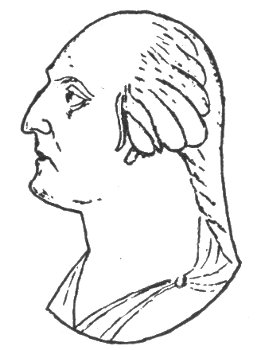 I.
I.
A long side-lock commences a short distance above the corner of the eye, but stops quite a distance from it. Together with the side-lock commences a heavy lower lock which slants across the ear-lobe, leaving the lower half exposed. There is a considerable space between the end of the side-lock and the ear-lobe. The entire hair ends in a nearly horizontal line. Two folds in the garment on the right side of the neck.
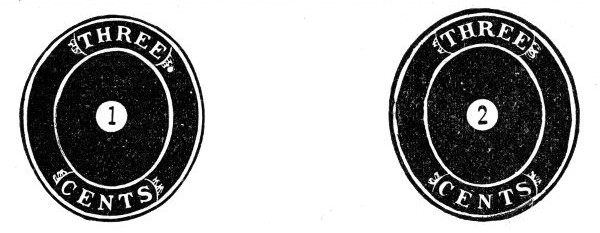
Variety I:—"CENTS" close to outer oval line. "CE" on level and far apart. "C" quite a distance from curve. "N" and "T" wide apart at base. "S" close to curve. The final "E" of "THREE" is somewhat lower than the first "E", dips to the right, and is close to the curve. "T" of "Three" is also close to curve. Many of the white envelopes are on horizontally laid paper.
Variety 2:—"THREE" near outer oval line. "T" further from curve. "RE" wider apart at top than in Var. 1, and "HR" slightly nearer than in Var. 1. The distance between "EN" and "NT" of "CENTS" is very wide. "S" far from curve. "CE" wide apart.
HEAD Ia.
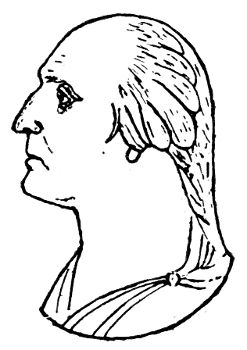 Ia.
Ia.
Same as Head I, but the side-lock is shorter and is further from the ear-lobe.
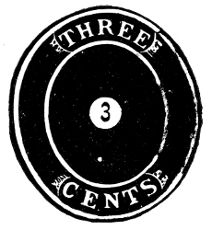
Variety 3:—"C" is above level of "E", near inner oval line and close to curve. "CE" wide apart. Note that "ENT" is near and "NT" much nearer at base than in Var. 1 or 2. "NTS" is also nearer inner oval line. "TH" of "THREE" is close. The "R" of "THREE" slants to right.
This variety is often seen on white paper horizontally laid.
HEAD II.
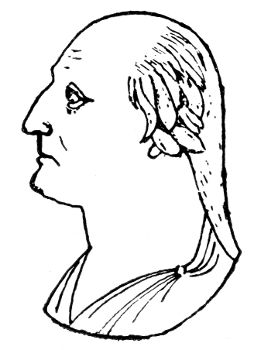 II.
II.
An heavy eyebrow. Two side-locks, of which the first is merely a fine line, commence far from and high above the corner of the eye.[Pg 11] The first side-lock is only half as long as the second; the latter is curved sharply at its end, and near the ear-lobe. Near the end of the side-lock commences the lowest front-lock, which slants only a little distance across the lobe. Front-lock and ear-lobe resemble the letter "T". Hair is divided into two parts. The lowest lock of the back row is in line with the queue.
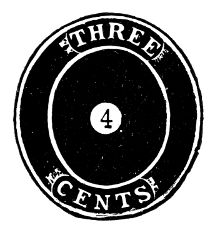
Variety 4.—"CENTS" is close to outer frame line and "C" is far from curve. "EN" near; "CE" wide. "NT" wide at base, "THR" near.
HEAD III.
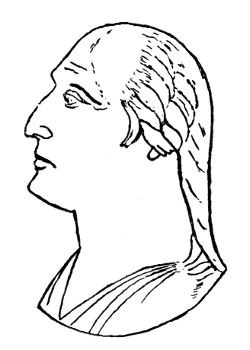 III.
III.
Side-lock starts some distance from the eye-brow and a little above it. The eyebrow is heavy. The side-lock is long, rather heavy and curved and ends far from the ear-lobe. The main feature is the heavy lowest front-lock, which slants across the lobe but ends in line with it. Side-lock, lobe and lowest front-lock somewhat resemble a figure 1.
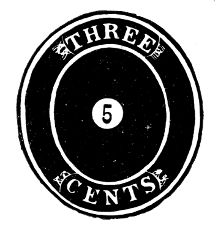
Variety 5:—"C" above level of "E": The entire word is high in label, especially "NT". "CE" wide. Note the top of "S" which[Pg 12] almost touches the lower right curve. "TH" wide at top. "R" is nearly vertically placed and in centre of the label. The top of the "T" of "CENTS" is a little above final stroke of "N".
HEAD IV.
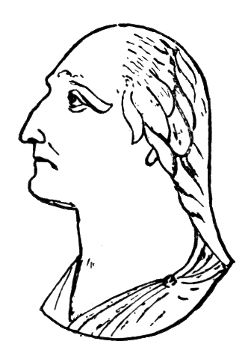 IV.
IV.
A heavy eyebrow ends near the middle of the side-lock. The latter is short and stops (as in Head III) far from the ear-lobe. The main feature is that the queue forms a direct continuation of the lowest front-lock.
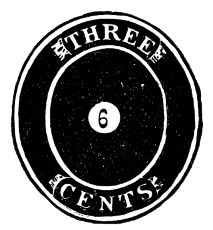
Variety 6:—"CE" of "CENTS" near. "EN" wide. "NT" wide at base. Note that the upper end of the lower right curve reaches well over the top of "S" and "C" is far from curve. "TH" close. Distance at top of "HR" and "RE" about the same.
HEAD V.
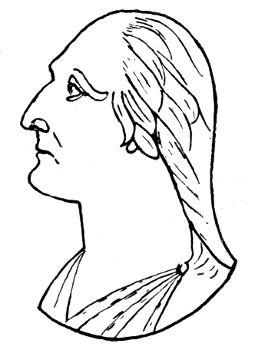 V.
V.
A very heavy eye-brow. The side-lock starts in line with the corner[Pg 13] of the eye and near the eyebrow; it curls slightly outward and, following closely the outline of the ear-lobe, ends almost above it. A heavy lock starts near the end of the side-lock, slants across the ear-lobe and ends in nearly a point. This feature distinguishes Head V from Head II, in which the lowest lock ends full and rounded. The queue is continued from the second heavy lock. Note also that the lock immediately behind the side-lock consists of two fine hairs and a heavy third strand.
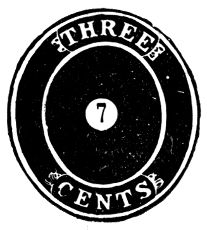
Variety 7:—"T" of "THREE" below level of "HREE". "CENTS" near outer oval line. "C" and "S" quite a distance from curves. "ENT" spaced nearer than "C" to "E" and "T" to "S".
HEAD VI.
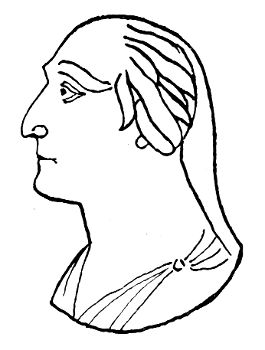 VI.
VI.
An heavy eyebrow. Near its end starts a small side-lock together with a long, narrow lock which slants across ear-lobe. Note that half of this lock is below the lobe. There is some distance between the side-lock and the lobe. A second heavy strand of hair extends the entire length of the [HW: narrow] lock and continues into the queue.
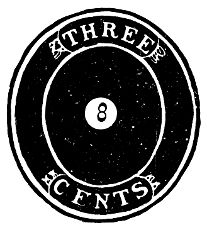
Variety 8:—"C" above level of "E" and far from it. "N"[Pg 14] stands vertically and almost in centre of label. "NT" close at top and near at base. "C" and "S" are close to curves. Note that "HR" and "RE" are wide at top.
HEAD VII.
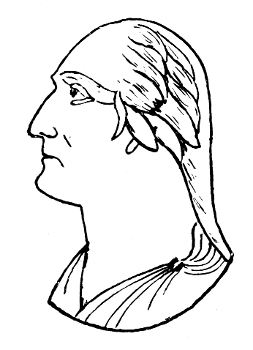 VII.
VII.
An heavy eyebrow extends beyond the corner of the eye. A long side-lock starts from the eyebrow and ends far from the ear-lobe. The lowest lock commences near the middle of the side-lock. Along the latter is another strand of hair of the same thickness but it is longer than the first and in line with the queue. The hair consists of two distinct rows, each of which has five locks.
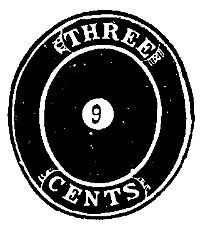
Variety 9:—"CENTS" near inner oval line. "CE" near; "ENT" near; "NT" close at top. "C" and "S" far from curves. "RE" wider at top than "HR".
HEAD VIII.
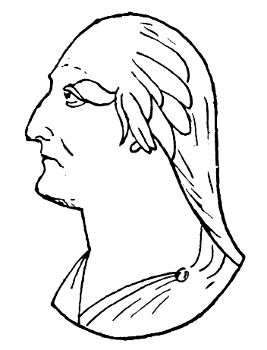 VIII.
VIII.
An heavy eyebrow near the corner of the eye. It extends to the[Pg 15] beginning of the side-lock, which is long, slim, almost straight, and ends a little distance from the ear-lobe. Note that the point of the side-lock is not turned up to the left. Together with the side-lock starts the lowest front-lock. It is rather thin, slants across the lobe, and is divided at the end, which is the main feature. Note that it extends but a little distance beyond the lobe. Immediately above the lowest strand is a second one, much longer than the first, forming the commencement of the queue.
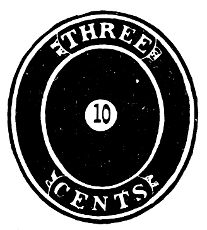
Variety 10:—"THREE" high in label. "HR" very close. "CENTS" near outer oval line. Base of "E" a little below that of "C". "EN" wide. "TS" near at base.
HEAD IX.
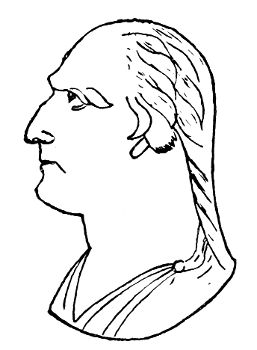 IX.
IX.
The side-lock starts above and far from the corner of the eye. It is short, curves outward towards its end, and terminates a little distance above the ear-lobe. Note that the ear-lobe is larger than usual and extends quite a distance beyond the end of the side-lock. Together with the side-lock commences the lowest bunch of hair, which resembles somewhat a pear, i.e. slim at the start and bulging towards the base. The hair is divided into two rows. The queue is in line with the back row.
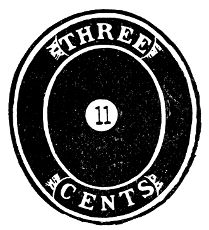
Variety 11:—"CENTS" near inner oval line; "C" high, and a[Pg 16] little above level of "E". "CE" wide; "ENT" near at top. "S" close to curve. "THREE" close to inner oval line. "HR" and "RE" wide at top.
HEAD X.
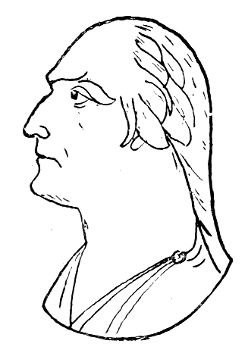 X.
X.
An heavy eyebrow starting upward from the bridge of the nose. A second eyebrow is close to the corner of the eye. A long side-lock starts near it and touches the ends in line with the ear-lobe. The hair is divided into two parts, four locks in front and three in the back row. The lowest lock in the front row is by far the heaviest. The hair is cut round similar to Head 1. Note that the queue is in line with the second row of hair.
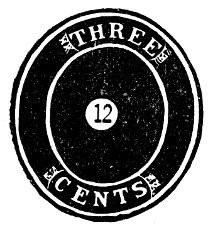
Variety 12:—"CENTS" close to inner frame line, especially "C". "THREE" close to inner oval line. "ENT" near at base. The die resembles closely Var. 9 with the exception of "C," which is high in the label.
Before leaving this issue some remarks about the paper and its various tints may be useful. The writer well remembers that when he first took up the study of these envelopes he was often sorely puzzled how to classify a specimen. The general catalogue knows but two shades of paper, white and buff, and is mute on the question of quality.
As a matter of fact the quality of the paper used for the first issue varies from soft to a hard, brittle texture, from thin to thick, with a dull or even highly glazed surface. A decided rarity is a kind of wove paper, unwatermarked. We find fine laid lines, the cross lines near or far, and two very distinct varieties of watermarks.
The white paper has sometimes a creamy and at other times a bluish tint, and the buff may be collected in various light and dark shades. The most pronounced shade varieties of buff appear, however, later, and will be mentioned when we study Die 5.
For the benefit of collectors of entire envelopes we will conclude this chapter by adding that:
Knife I appears only in five varieties, i.e. Nos. 4, 6, 7, 8, and 10, while Knife 2, both white and buff, exists in all varieties.
THREE CENTS, RED. DIE 2.
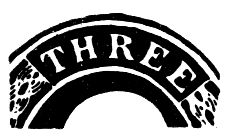
The "Straight End" Die.
Short labels with straight ends.
8-1/2 loops on the left; 9 loops on the right.
It is generally conceded that this die is one of the earliest made, because many of the envelopes bear the Nesbitt tress or seal on the flap.
In addition to Head 1, used for Die I, there now appear two new ones. This issue is also noticeable because in each of the three varieties the lettering is about the same. For this reason a knowledge of the heads is imperative for identification of the varieties. It may also assist the collector to note that Head I exists only with the seal on the flap of the envelope, and that in Heads XI and XII the garment at the back of the neck has four folds in contradistinction to Head I, in which the garment has but two folds.
As far as we know, letter size envelopes, bearing Die 2, were issued in July, 1853, and note size in September of the same year. Excepting note size (Knife 1 of the present list), all other envelopes exist on both white and buff paper.
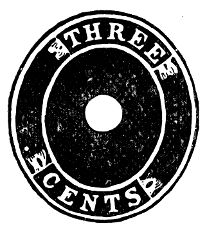
Variety 1, Head I:—As this head has been fully described and illustrated under Die 1, it needs no additional remarks.
HEAD XI.
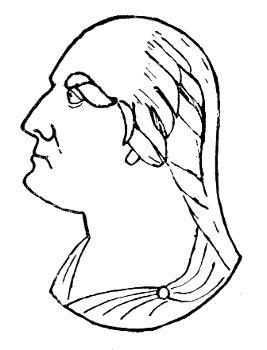 XI.
XI.
Variety 2, Head XI.—A small but heavy eyebrow near the corner of the eye. The side-lock commences close to the eye-brow and is rather short and shaped like a comma. Near the end of the side-lock begins the lowest front-lock, which is very short, heavy, and extends some distance beyond the ear-lobe. Note that the end of the side-lock reaches to the middle of the ear-lobe. The queue is continued from the second front-lock. There are five locks in the front row and two heavy upper locks in the back row:
[HW: there is usually a flaw in the outer colored line opposite the lower left straight line near "C."]
HEAD XII.
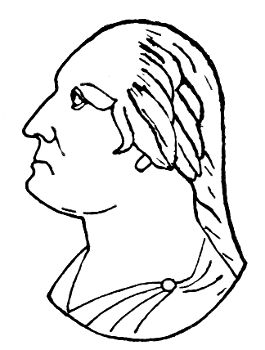 XII.
XII.
Variety 3, Head XII:—A long, heavy-side-lock starts near a heavy eyebrow, which extends far beyond the corner of the eye. At its end the side-lock bends sharply to the left and is quite a distance from the ear-lobe. Together with the side-lock starts the lowest front-lock. It slants across the ear-lobe, broadens towards its middle and is pointed at the end. The side-lock, front-lock and ear-lobe somewhat resemble the figure 1. The queue is continued from the lowest lock immediately behind the second front-lock. There are five locks in the front row and three heavy locks in the back row.
THREE CENTS, RED. DIE 3.
"THREE" in square label with a diagonal line across each corner called
"K Ends."
8-1/2 loops on left; 9 loops on right.
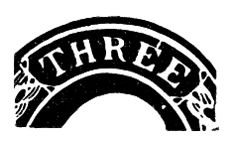
This die appeared in July, 1853, and exists on note and letter size envelopes. The former is extremely rare. Mr. Harrison, who has carefully studied this die, found two heads of Washington (XIII and XIV). He states, however, that: "in the heads in relief there is only a slight difference in the arrangement of the hair, which is of no practical use, as in most specimens of this series the head is so lightly impressed[Pg 19] that it is impossible to detect any differences." Realizing how difficult it is to get a fine specimen of this die, the writer tried his best to obtain a clear impression, and the drawing shows that the search has not been in vain.
HEAD XIII.
Two small side-locks. (For further description see Head XIV).
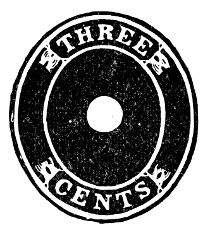
Variety 1.:—"C" of "Cents" low.
HEAD XIV.
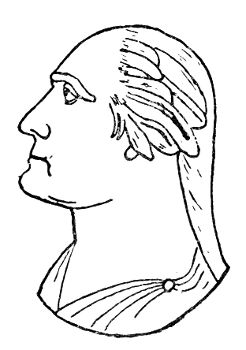 XIV.
XIV.
One short side-lock: A heavy eyebrow. A fine, short side-lock starts quite a distance from the latter and ends far from the ear-lobe. Together with the side-lock commences the short, lowest front-lock. Immediately above the latter commences the third front-lock, which is bifurcated to the middle. This is the main feature of the die. It is by far the heaviest strand and continues, uninterruptedly, into the queue. All other front or rear locks are short. Between the last-mentioned long front-lock and the short, lowest one lies a small rear lock, pointed at its start and broad at its end. Including the lowest front-lock, there are five locks in front and but three in the rear row, i.e., two above the long, bifurcated front-lock and a small one immediately below the latter.
Variety 2:—"C" of "CENTS" high in the frame.
THREE CENTS, RED. DIE 4.
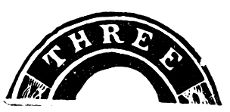
Wide label, measuring 20 mm. horizontally, with square ends; lower
label short (17 mm.) but also with straight ends. 7 loops on each side.
Issued July, 1853.
Luckily the engraver has seen fit to use but one head for this issue and it is our old favorite, HEAD I, and needs no further description. There is but one variety, and none of the envelopes have the Nesbitt seal.
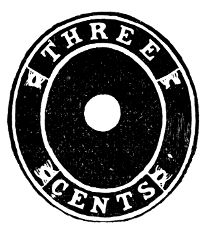
Variety 1:—Letters of "THREE" very widely spaced, especially the last two letters. "T" nearer to left label than "E" to the right. "ENT" of "CENTS" nearer to each other than "C" to "E" and "T" to "S".
The die has been used for note and letter size, i.e., Knives 1 and 2, on white, and for the latter on both white and buff paper.
THREE CENTS, RED. DIE 5.
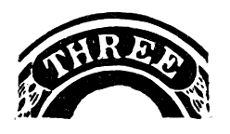
The common die of the first series.
Short labels (measuring 15 mm. horizontally) with curved ends.
9 loops on the left; 8-1/2 loops on the right.
This die appeared in March, 1854, and remained in existence until October, 1860. On account of its six years of constant use, it was not strange that the die should need repairing and retouching. Nevertheless, while admitting the necessity of repairs, this does not account in any way for the fact that we have thirty distinctly different dies in this series, many of which cannot be explained by the above theory. Of course, the various curves of the labels may be accounted for by repeated retouching, but no one who compares many of these dies would attempt to give the same reason for the totally different lettering and the great variety in the spacing. As a matter of fact, most of the so-called varieties are far more distinct dies than some of the well-known Reays and Plimptons of equal denominations. In spite of the great number of varieties of this issue, the engraver has seen fit to use but one head of Washington, which is totally different from any of those preceding.
HEAD XV.
 XV.
XV.
Two fine, very short side-locks, reaching to the middle of the ear-lobe, which is rather large. There are seven very thin locks of hair, almost hair lines, in the upper part of the head, extending to the back of the head, each with a curve in the centre. Below these there is a short, thick bunch, or lock, bent upwards into the space left by the curve of the seventh thin lock. There is one short, thick front-lock and three in the back row, side by side, nearly at right angles to the bunch of hair which is bent upwards. The lowest front-lock slants a considerable distance across the ear, while the lock immediately above it is much longer and reaches into the queue. The latter is very thin and shows no subdivisions.
Doubtless the thirty varieties of this die would have been highly prized by collectors and would have been well known many years ago if American philatelists had taken the trouble to study them with a view to systematic classification. Certainly, without a system the collector's task is troublesome, but, with a proper classification, the difficulty vanishes and what has hitherto been considered an annoyance becomes a pleasurable pursuit. This issue greatly favors the collector of cut square specimens, for a good many dies can easily be found. On the contrary, the collector of entires, especially the advanced collector who desires mint copies, will find it difficult to get unused specimens of many dies.
The paper used is white and buff, and, as mentioned before, both the quality and color differ widely. For instance: "Buff" covers shades which would be called at the present time light chocolate, brown, oriental buff, light yellow, etc. A great many envelopes are of soft paper, nearly unsurfaced, while there are numerous others having a hard, brittle texture, highly surfaced or glazed. Often six shades may be obtained, and they are certainly worthy of being collected with care.
It has already been stated that the thirty varieties can be classified, and that such classification is a great help to the philatelist. Fortunately, the first ten dies are quickly recognized by the long, horizontal cross stroke of "T" of "THREE," and "T" of "CENTS," while the remaining twenty dies have a short top stroke, and this differentiation, in the writer's humble opinion, should have been introduced long ago in the general catalogues.
Before commencing the study of the first ten varieties, it is only proper to state that even Mr. Harrison has put himself on record that:[Pg 22] "the ten earlier varieties are by no means easy to separate." Indeed, they are decidedly more troublesome and require far closer work than any of the other Nesbitt die varieties. The student is sure to find many specimens in which the upper curves are entirely worn away, and in judging the spacing of the letters errors are likely to occur, due to heavy impressions, which are not infrequent.
Being well aware of these annoyances, the writer has tried, to the best of his ability, to make the description of these ten varieties as lucid as possible, and as they now stand they represent the labor of many hours. Expressions like "far", "near" or "close" are, of course, subject to individual interpretation, but by comparing the illustrations accompanying the text, what is meant by "close", etc., will be easily understood. Wherever greater accuracy seemed needful, the distance between two letters, either at the top or the base has been added. If a letter is stated to be below the level of another, the student, as a rule, should have no difficulty in recognizing this fact. This is true of varieties 4 and 5, but a certain amount of training of the eye is required to recognize quickly the lower position of "T" and "E" of "THREE" in varieties 1, 2 and 10.
Together with the new die two new sizes of envelopes appear, known as Knives 4 and 5, respectively; both are termed "Full Letter" and have three black lines on the inside of the left side flap.
"T" WITH LONG CROSS STROKE.
Dies 1 to 10.
The ten die varieties are divided into three groups by drawing a straight line along the outside of the downward stroke of "T" of "THREE".
1) Line cuts through "S" of "CENTS" (Var. 1, 2, 3, 4).
2) Line goes to right of "S" (Var. 5, 6, 7).
3) Line goes through right lower curve (Var. 8, 9, 10).
It should be understood, however, that the above line prolongation is only tentative, not absolute, and can only be relied upon in a general way as certain specimens will be found which will vary from it to a greater or less extent.
Description of Dies.

Variety 1:—"T" a considerable distance from upper left curve.[Pg 23] "TH" widely spaced, but "HR" near and "R" the highest letter. "RE" wide at top. "EE" wide. "CE" wide at base. "EN" wide. "NT" wide at base. Lower curves deep and far from "C" and "S".
Variety 2:—"T" near curve, and "T" and final "E" below level of "HRE". "TH" near, "HR" near, but "RE" and "EE" wide at top. Upper curves are frequently much deteriorated. Lower left curve far from "C". "CE" and "NT" wide at base. "TS" near. Lower right curve near "S".
Variety 3:—Upper left curve very far from "T". "RE" wide and "R" slants sharply to the right. "EE" near at top. "C" far from lower left curve. "CE" wide at base. "E" slants sharply to the left and "EN" wide at base. "S" close to curve.
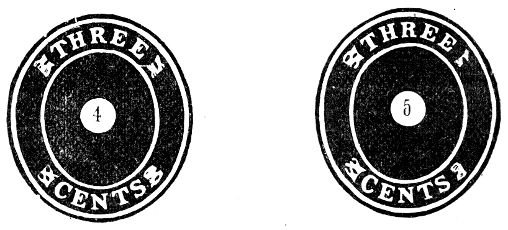
Variety 4:—"T" near curve but below level of "H". "HR" wide but "RE" wider, and "EE" widest at top. The main feature of this die is that the lower left curve slants sharply downward and is far from base of "C". "CE" wide at base. "NT" very wide at base. "S" far from curve.
Variety 5:—Upper right curve flattened and top of "T" near curve. "T" low and far from "H". "HR" widely spaced at top, but "RE" still wider. "EE" near. Upper right curve far from "E" both at top and base. Frequently the curves are nearly obliterated.
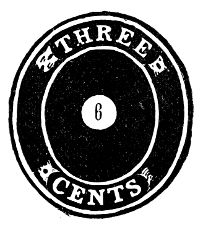
Variety 6:—Upper right curve near "T". Top of "T" some distance from "H". "RE" wide at top. "EE" wide. The curve is far from top of "E", but slants so that, at the point where it meets the inner oval line, it is near base of "E". Lower left curve near "C" and reaches over the top of the letter. "CEN" near; "NT" near at base. "S" far from curve.
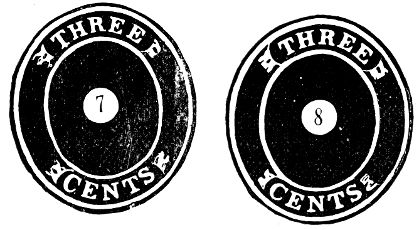
Variety 7:—The FLAW VARIETY. Upper right curve very deep. Top of "T" considerably nearer curve than base. "TH" near. "HR" and "RE" near at top. "EE" very wide at top. Curve is very far from "E" both at top and base. Lower left curve flattened and near "C". "EX" near. "NT" well spaced. In the outer red frame line, near base of "T", a small portion of the die is broken away.
Variety 8:—Upper left curve deep and top of "T" near curve. "TH" near. "HRE" near, and "RE" the closest spacing of all the varieties. "EE" near. Right curve is a good distance from top of "E". Lower left curve small and near "C". "CE" wide. "ENT" near and upper horizontal stroke of "N" often joined to "T". "TS" near and "S" close to curve.
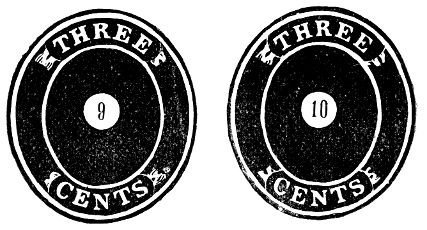
Variety 9:—Upper left curve much flattened and close to "T"; "T" and final "E" somewhat below level of "HRE". "TH" close and "H" sharply slanting to left. "HREE" near at top. Right curve far from "E". Lower left curve short and near "C". "CE" close. "EN" near. "NT" near at base. Right curve near "S".
Variety 10:—Upper left curve near "T". "TH" near at top. "HRE" spaced as in Var. 9 but "EE" nearer, and top of "E" nearer the curve. Lower left curve near "C". "C" above level of "E" and near at base. "ENTS" near. "S" far from curve.
LETTERS "T" WITH SHORT CROSS STROKES.
Dies 11 to 30.
These twenty die varieties are grouped into two classes by the use of a unit distance measurement of 14 and 12 mm. respectively.
Class I.
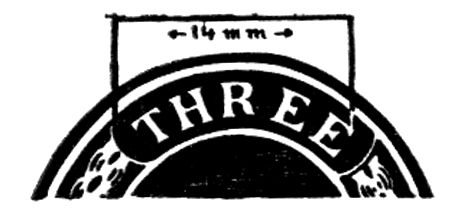
A line 14mm. long will extend from the point where the upper left curve meets the inner white frame-line to the end of the final "E" of "THREE".

Group A:—A line 12mm. long, starting from the junction of the upper left curve and the inner, white, frame-line will extend to the end of the horizontal stroke of the first "E" of "THREE". (Var. 11 to 18.)
Group B:—A line 12mm. long, starting from the junction of the upper left curve and the inner, white, frame-line will extend to a point just beyond the end of the horizontal stroke of the first "E" of "THREE". (Var. 19 to 27.)
Class II.
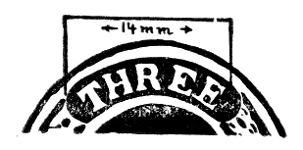
A line 14mm. long, starting from the junction of the upper left curve and the inner, white, frame-line, will extend to a point just outside of the final "E" of "THREE". (Var. 28 to 30.)

Variety 11:—The top stroke of "N," if extended, would bisect the vertical stroke of "T". "RE" very wide at top. "T" and "E" about an equal distance from curves. Lower left curve well rounded. "EN" near at top. "N" broad.
Variety 12:—The small horizontal line of "N," if extended, would cut the vertical downstroke of "T." All the centre crossbars of "Es" touch the horizontal upper stroke. "N" of "CENTS" is narrow; is the lowest letter, and has a heavy middle line. "T" and "E" are close to the curves, which are short. "TS" close and on level.
There are often two dots in the central oval, one near the throat and the other opposite the third loop above "C". Compare variety 11 for "NT," also variety 21.
Variety 13:—A flaw in the design, caused by the addition of a short line immediately above the right lower curve and at the beginning of the first loop. "TH" wide. "RE" wide at top. "CE" near. The entire word "CENTS" is well in the centre of the label. "S" above level of "T". Note the wide distance of "C" from the lower left corner.
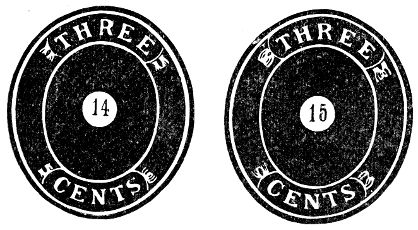
Variety 14:—This die shows the widest spacing of "THREE". Lower left curve is deep; slants back and is far from "C". Lower right curve near "S". "T" and "E" about equally far from curves. Upper right curve much flattened. Note "T" short and top of "C" considerably below inner oval line. Note also that centre of first loop below upper right curve is unfinished. "TH" wide at base; "CE" near: "EN" wide. "N" tall and narrow.
Variety 15:—"RE" very wide. There is a small triangle in the design immediately above the centre of lower right curve. Upper left curve very deep and "T" far from it. "HRE" wide at base. Final "E" below level of first "E" and nearer curve than "T". Lower left curve is flat and "C" is far from it, both at top and base. "CE" wide. Tall, narrow "N". Note that the entire word is high in the label.
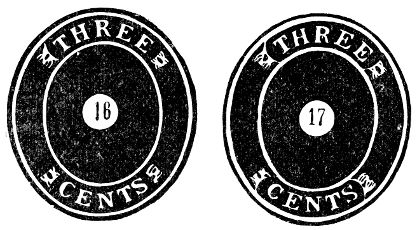
Variety 16:—"S" of "CENTS" high in label. Lower left curve very slightly curved and very far from "C," which is elongated. "CE" wide, likewise "EN". "N" large and broad. Lower right curve flattened and "S" far from curve. "T" and "E" about equally distant from upper curves, which are, likewise, flattened. "TH" nearer at top than "HR". "RE" wider at top than "HR". "EE" wide at top. Compare varieties 26 and 27 for upper right curve.
Variety 17:—Lower left curve commences near top of "C" of "CENTS", slants sharply downward, and is, at the point where the curve meets the outer oval line, far from base of "C". Upper right curve is much flattened and close to "E" at base. Upper left curve is deep and a good distance from "T". The latter is short, thick and near "H". "RE" much wider at top than "HR". There are two small dots immediately below the upper right curve. In the lower label "C" and "S" are slightly above the level of "ENT"; "EN" near; "N" broad. Compare variety 18 for lower left curve and note position of "T" of "THREE" with regard to upper left curve.
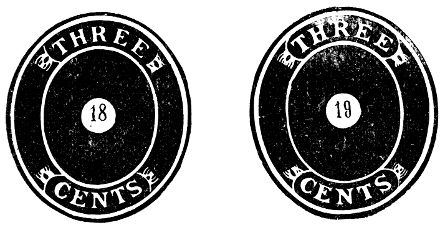
Variety 18:—Lower left curve slants back and is far from "C" at the junction of the curve with the outer frame line. "T" close to upper left curve. Upper left curve flat and "T" is much nearer to it than "E" to the right curve. "THR" near at top. "RE" very wide at top. "EE" near. The entire word "CENTS" is close to the inner oval line. "N" is broad, and top of "T" is slightly above "X". "TS" close. Note that there are three dots immediately above lower right curve. Compare Variety 17 for lower left curve.
Variety 19:—"T" and "E" close to curves. Upper curves short. "HRE" wide at top. "EE" near. Lower left curve near "C". "CE" close. "EN" wide. "N" in upright position. "NT" wide at base. Compare variety 12 for arrangement of letters in upper label and note "NT". Note that the top of "E" is very near curve.
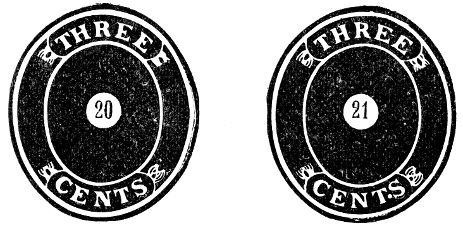
Variety 20:—"C" high; near inner oval line and close to "E". "C" and "S" above level of "ENT". "C" heavy and near lower left curve. "EN" wide. "NT" close. Upper curves are short. "T" near upper left curve. "TH" close and "T" has short top stroke. Upper right curve starts far from top of "E" and slants inward. "EE" near. Lower right curve deep. Compare varieties 12, 19 and 21 for lower label.
Variety 21:—"T" short, thick and near curve. "TH" near. "R" in the centre of label and in a vertical position. Upper right curve slants inward and is much nearer to base than to top of "E". "C" and "S" in lower label are above level of "ENT". "S" of "CENTS" far from curve. Lower left curve short and close to "C". "N" is broad. Lower right curve deeper than lower left curve. "CEN" near. Compare variety 30 for lower right curve and 20 for upper right curve.
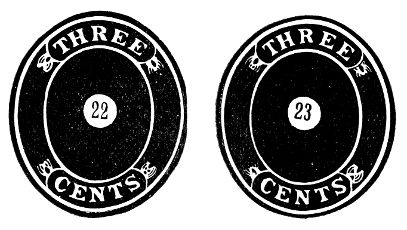
Variety 22:—"EN" joined at top. "HR" very wide at top and forming a sharp angle. "TH" close. Upper left curve flat. Upper right curve is deep; far from top of "E" and terminates at its base. Lower left curve far from "C". "C" and "S" above level of "ENT". Upper cross stroke of "T" short. "S" far from lower right curve. First loop above lower right curve has a very large centre. Compare variety 21.
Variety 23:—"R" highest letter and close to outer frame line. "TH" close. "RE" very wide at top. "T" and "E" about the same distance from curves. There are two small, colored dots immediately below the upper right curve. Lower left curve slants. "C" and "S" equally far from curves. "CENT" on level and "CEN" close at base. Compare variety 17 for lower left curve.
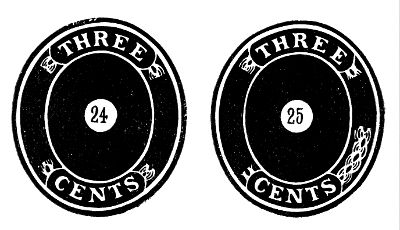
Variety 24:—Top stroke of "E" is above top of "C". "CE" close. "EN" near at top. "N" short and thick. Top stroke of "N" nearly touches "T". "NT" high in label. Lower curves well rounded and short, but lower left curve deeper than lower right. "C" somewhat further from curve than "S". Upper right curve deep and far from "E". "TH" near and about parallel. "HR" near, but "RE" wider at top. "EE" near; centre strokes touch upper horizontal line. Compare, for distance of "THR", variety 29.
Variety 25:—A flaw, i.e., a white line running out from the middle of the third loop on the right, towards the inner oval line. Lower left curve a good distance away from "C". "C" round and full, but shorter than the rest of the letters. "S" far from lower right curve. "EE" widely spaced and upper right curve flat. "C" and "S" above level of "ENT".

Variety 26:—"C" of "CENTS" elongated, very slanting and far from "E". Lower left curve is very flat and far from "C". "ENT" near at top. Lower right curve slants back and is far from base of "S". Upper left curve is very flat. "HRE" very wide at top and "EE" widely spaced. "N" is broad. There are, also, two dots immediately below upper right curve. Compare varieties 16 and 29.
Variety 27:—The horizontal bar of the final stroke of "N" extends over the top of "T". Lower left curve fat and very far from "C". "CE" wide. Upper left curve much deeper than upper right curve, which is almost a straight line. "T" very short. "TH" wide at top, "HR" wider. Note that "R" stands to right of the centre of stamp and, also, the wide, colored space above the top of "THRE". "N" of "CENTS" is broad. Compare varieties 16 and 26.
Variety 28:—"T" of "THREE" is low, small and heavy. "RE" nearest. "T" is near the inner oval line and much nearer to upper left curve than "E" to upper right curve. "TH" near, "H" and "E" at top about the same distance apart from "E", which is upright and close to outer frame line. "EE" near. Lower left curve short; lower right curve deep. "CE" on level and close. "EN" far. "N" short and thick and, at base, nearer "E" than "T". Compare variety 29.

Variety 29:—"THR" spaced closest. "T" of "THREE" slightly nearer the curve than "E" is to upper right curve. Upper curves are deep and well rounded. "TH" close. "C" of "CENTS" is heavy and close to the short, round curve. "NT" near and sometimes touching at top. "TS" wide and "S" far from curve. Lower right curve deep and well rounded. Note that the word "CENTS" is near the outer frame line. Compare variety 30 for "S" distance.
Variety 30:—"C" near outer frame line and on level with "E". "TH" very near and top of "T" close to curve. "RE" much wider at top than "HR". "EE" wide at top. Upper right curve much larger than upper left curve and much further from top than from base of "E". Lower curves short and round. "NT" wide at base. "TS" close at top and top of "S" close to curve.[Pg 30] There is a colored dot, or circle, immediately above centre of the lower right curve. Note wide colored space above top of "R" and "E". Compare varieties 21 and 28.
SIX CENTS, RED AND SIX CENTS, GREEN.
Short labels with straight ends.
8-1/2 loops on the left; 9 loops on the right.
The date of issue of the SIX CENTS red is generally placed about July 31st. 1853; that of its congener—but with color changed—sometime before Sept. 30th of the same year. As there has never been much demand for a six cent envelope, it is strange that this issue has four distinct heads of Washington, two forms of "SIX", small and large, and different spacings of the word "CENTS". Unlike the last issue, the die is exceedingly well printed, and it is not difficult to get fine copies.
In Varieties 1 and 2 "SIX" is widely spaced:
In Varieties 3 and 4 the spacing is closer.
VARIETY 1.
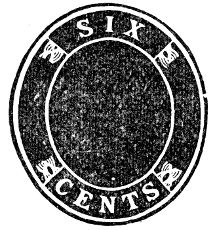
No description of the head is needed; it is HEAD I of Die 1 of 1853. "CE" very wide; "EN" wide; "NT" near at top and "S" is far from "T".
VARIETY 2.
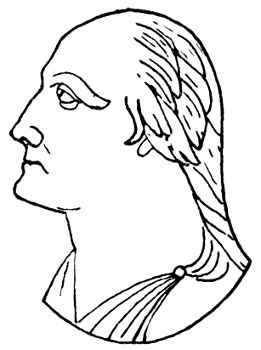 XVI.
XVI.
HEAD XVI. Side-lock is long, straight, curved at its point, and[Pg 31] ends near the ear-lobe. There are five locks in the front row and four in the back row. The highest front-lock is split into two parts. Between the side-lock and the lowest front-lock and well towards the middle of the former, commences a thin lock which extends far beyond the ear-lobe and ends in the queue. "CE" wide; "EN" wide; "NT" further at base than in Var. 1. "TS" near. This head is found on the reprints on white and buff vertically laid paper.
VARIETY 3.
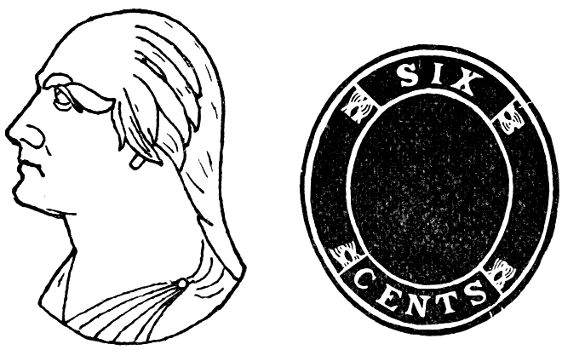 XVII.
XVII.
HEAD XVII. A very heavy eyebrow which comes close to the side-lock. The latter is very fine and near the ear-lobe. The hair consists of five long and nearly parallel locks. The second longest and heaviest lock touches the queue. "CE" very wide; "EN" wide. "NT" wide at top. "TS" very widely spaced.
VARIETY 4.
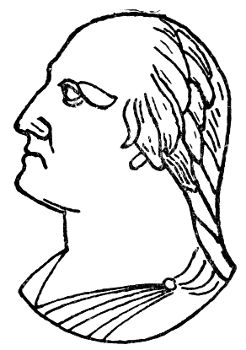 XVIII.
XVIII.
HEAD XVIII. A heavy eyebrow. A short side-lock with a sharp point, starting near the eye-brow, ends [HW: some] distance from the ear-lobe. There are five locks in the front row and the same number in the back row. Of the five front locks four are heavy. There is also a long and thin strand between the second and third front-lock. Together with the side-lock starts the lowest front-lock which broadens out towards its middle and ends in a point a short distance behind the ear-lobe. The second front-lock is in line with the queue. "CENTS" close to outer frame line. "CE" nearer than in Var. 3. "T" has a short cross-stroke; "TS" is wide and "NT" is near at top.
All varieties of the SIX CENTS red exist only on Knife 3, and all those of the SIX CENTS green only on Knife 2. The former is a newcomer and was styled "Official, Size 7". On account of its size (221 × 98 mm.) the envelope did not meet with much favor, and to-day it is difficult to find a cancelled specimen in fine condition. In accordance with the instructions of the Post Office the envelope should have been folded so that the right side flap overlapped the left, but this rule was not strictly adhered to, so that many collectors possess specimens with the opposite folding.
TEN CENTS, GREEN.
Narrow labels with straight ends.
8-1/2 loops on the left; 9 loops on the right.
This die appeared in April, 1855. Its issuance is due to an Act of Congress of March 3, 1855, which fixed the letter rate for transportation over 3000 miles at 10 cents.
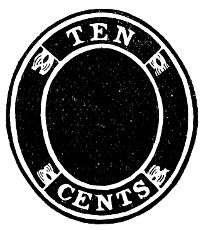
HEAD XV: VAR. I:—Letters of "TEN" about equally spaced. "T" slants back and is somewhat nearer the left label than "N" to the right. "CE" close: "NT" near, and the top of the latter above "N". "S" closer to curve than "C". Frequently a little white line runs out from the left ornamental scrollwork a short distance above "C".
TEN CENTS, GREEN.
Very wide upper label (measuring horizontally 24-1/2 mm.) with straight
ends.
7 loops on each side.
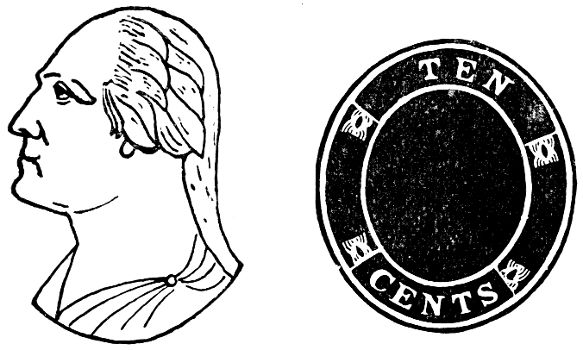 XIX.
XIX.
HEAD XIX: VAR I:—A short fine eyebrow extends upward from the end of the nose. Another short, but much heavier one, is[Pg 33] attached to the corner of the eye. Two fine, short side-locks commence a little distance from the heavy eyebrow and finish just above the ear-lobe. There is a double row of five short and heavy locks, while the queue is continued from the lowest lock in the back row. The garment at the back has three folds.
"TEN" near, but "N" nearer to right label than "T" to the left. Letters of "CENT" closely spaced, but "S" some distance from "T".
THREE CENTS, RED.
Die I. "THREE" in Narrow Curved Label.
| Var. 1: Head I. | |||||
|---|---|---|---|---|---|
| No.[C] | Paper. | Knife. | Size. | Dimensions. | Remarks. |
| 1 | W | 2 | 3 | 139 × 83 | Seal. |
| 2 | B | 2 | 3 | " " | " |
| Var. 2: Head I. | |||||
| No. | Paper. | Knife. | Size. | Dimensions. | Remarks. |
| 3 | W | 2 | 3 | 139 × 83 | Plain and seal. |
| 4 | B | 2 | 3 | " " | " " " |
| Var. 3: Head Ia. | |||||
| No. | Paper. | Knife. | Size. | Dimensions. | Remarks. |
| 5 | W | 2 | 3 | 139 × 83 | Plain and seal. |
| 6 | B | 2 | 3 | " " | " " " |
| Var. 4: Head II. | |||||
| No. | Paper. | Knife. | Size. | Dimensions. | Remarks. |
| 7 | W | 1 | 1 | 120 × 73 | Plain. |
| 8 | W | 2 | 3 | 139 × 83 | Plain and seal. |
| 9 | B | 2 | 3 | " " | " " " |
| Var. 5: Head III. | |||||
| No. | Paper. | Knife. | Size. | Dimensions. | Remarks. |
| 10 | W | 2 | 3 | 139 × 83 | Plain and seal. |
| 11 | B | 2 | 3 | " " | " " " |
| Var. 6: Head IV. | |||||
| No. | Paper. | Knife. | Size. | Dimensions. | Remarks. |
| 12 | W | 1 | 1 | 120 × 73 | Plain. |
| 13 | W | 2 | 3 | 139 × 83 | Plain and seal. |
| 14 | B | 2 | 3 | " " | " " " |
| Var. 7: Head V. | |||||
| No. | Paper. | Knife. | Size. | Dimensions. | Remarks. |
| 15 | W | 1 | 1 | 120 × 73 | Plain. |
| 16 | W | 2 | 3 | 139 × 83 | Plain and seal. |
| 17 | B | 2 | 3 | " " | " " " |
| Var. 8: Head VI. | |||||
| No. | Paper. | Knife. | Size. | Dimensions. | Remarks. |
| 18 | W | 1 | 1 | 120 × 73 | Plain. |
| 19 | W | 2 | 3 | 139 × 83 | Plain and seal. |
| 20 | B | 2 | 3 | " " | " " " |
| Var. 9. Head VII. | |||||
| No. | Paper. | Knife. | Size. | Dimensions. | Remarks. |
| 21 | W | 2 | 3 | 139 × 83 | Plain and seal. |
| 22 | W | 2 | 3 | " " | No watermark, plain. |
| 23 | B | 2 | 3 | " " | Plain and seal. |
| Var. 10: Head VIII. | |||||
| No. | Paper. | Knife. | Size. | Dimensions. | Remarks. |
| 24 | W | 1 | 1 | 120 × 73 | Plain. |
| 25 | W | 2 | 3 | 139 × 83 | Plain and seal. |
| 26 | B | 2 | 3 | " " | " " " |
| Var. 11: Head IX. | |||||
| No. | Paper. | Knife. | Size. | Dimensions. | Remarks. |
| 27 | W | 2 | 3 | 139 × 83 | Plain and seal; also hor. laid. |
| 28 | B | 2 | 3 | " " | Plain and seal. |
| Var. 12: Head X. | |||||
| No. | Paper. | Knife. | Size. | Dimensions. | Remarks. |
| 29 | W | 2 | 3 | 139 × 83 | Plain and seal. |
| 30 | B | 2 | 3 | " " | " " " |
Die II. "THREE" in Narrow, Straight Label.
| Var. 1: Head I. | |||||
|---|---|---|---|---|---|
| No. | Paper. | Knife. | Size. | Dimensions. | Remarks. |
| 31 | W | 2 | 3 | 139 × 83 | Seal. |
| 32 | B | 2 | 3 | " " | " |
| Var. 2: Head XI. | |||||
| No. | Paper. | Knife. | Size. | Dimensions. | Remarks. |
| 33 | W | 2 | 3 | 139 × 83 | Plain and seal. |
| 34 | B | 2 | 3 | " " | " " " |
| Var. 3: Head XII. | |||||
| No. | Paper. | Knife. | Size. | Dimensions. | Remarks. |
| 35 | W | 1 | 1 | 120 × 73 | Plain. |
| 36 | W | 2 | 3 | 139 × 83 | Plain and seal. |
| 37 | B | 2 | 3 | " " | " " " |
Die III. "THREE" in Square Label with a Diagonal Line Across Each Corner, Called "K Ends".
| Var. 1: Head XIII. | |||||
|---|---|---|---|---|---|
| No. | Paper. | Knife. | Size. | Dimensions. | Remarks. |
| 38 | W | 1 | 1 | 120 × 73 | |
| 39 | W | 2 | 3 | 139 × 83 | |
| 40 | B | 2 | 3 | " " | |
| Var. 1: Head XIV. | |||||
| No. | Paper. | Knife. | Size. | Dimensions. | Remarks. |
| 41 | W | 2 | 3 | 139 × 83 | |
| 42 | B | 2 | 3 | " " | |
Die IV. "THREE" in Wide Label with Square Ends.
| Head I. | |||||
|---|---|---|---|---|---|
| No. | Paper. | Knife. | Size. | Dimensions. | Remarks. |
| 43 | W | 1 | 1 | 120 × 73 | |
| 44 | W | 2 | 3 | 139 × 83 | |
| 45 | B | 2 | 3 | " " | |
Die V. "THREE" in Medium Curved Label.
"T" with Long Cross Stroke.
| Var. 1: Head XV. | |||||
|---|---|---|---|---|---|
| No. | Paper. | Knife. | Size. | Dimensions. | Remarks. |
| 46 | W | [HW: 2] | [HW: 3] | [HW: 139 × 82] | |
| 47 | B | [HW: 2] | [HW: 3] | " " | |
| 48 | W | 4 | 3 | 139 × 82 | |
| 49 | B | 2 | 3 | " " | |
| Var. 2. | |||||
| No. | Paper. | Knife. | Size. | Dimensions. | Remarks. |
| 50 | W | 1 | 1 | 120 × 73 | |
| 51 | W | 2 | 3 | 139 × 83 | |
| 52 | W | 2 | 3 | " " | No watermark. |
| 53 | B | 2 | 3 | " " | |
| Var. 3. | |||||
| No. | Paper. | Knife. | Size. | Dimensions. | Remarks. |
| 54 | W | 2 | 3 | 139 × 83 | |
| 55 | B | 2 | 3 | " " | |
| Var. 4. | |||||
| No. | Paper. | Knife. | Size. | Dimensions. | Remarks. |
| 56 | W | 1 | 1 | 120 × 73 | |
| 57 | B | 2 | 3 | " " | |
| 58 | B | 2 | 3 | " " | [Pg 36] |
| Var. 5. | |||||
| No. | Paper. | Knife. | Size. | Dimensions. | Remarks. |
| 59 | W | 1 | 1 | 120 × 73 | |
| 60 | W | 2 | 3 | 139 × 83 | |
| 61 | B | 2 | 3 | " " | |
| Var. 6. | |||||
| No. | Paper. | Knife. | Size. | Dimensions. | Remarks. |
| 62 | W | 2 | 3 | 139 × 83 | |
| 63 | B | 2 | 3 | " " | |
| Var. 7. | |||||
| No. | Paper. | Knife. | Size. | Dimensions. | Remarks. |
| 64 | W | 2 | 3 | 139 × 83 | |
| 65 | B | 2 | 3 | " " | |
| Var. 8. | |||||
| No. | Paper. | Knife. | Size. | Dimensions. | Remarks. |
| 66 | W | 2 | 3 | 139 × 83 | |
| 67 | B | 2 | 3 | " " | |
| Var. 9. | |||||
| No. | Paper. | Knife. | Size. | Dimensions. | Remarks. |
| 68 | W | 2 | 3 | 139 × 83 | |
| 69 | B | 2 | 3 | " " | |
| Var. 10. | |||||
| No. | Paper. | Knife. | Size. | Dimensions. | Remarks. |
| 70 | W | 2 | 3 | 139 × 83 | |
| 71 | B | 2 | 3 | " " | |
"T" with short cross stroke.
| Var. 11. | |||||
|---|---|---|---|---|---|
| No. | Paper. | Knife. | Size. | Dimensions. | Remarks. |
| 72 | W | 2 | 3 | 139 × 83 | |
| 73 | B | 2 | 3 | " " | |
| Var. 12. | |||||
| No. | Paper. | Knife. | Size. | Dimensions. | Remarks. |
| 74 | W | 2 | 3 | 139 × 83 | |
| 75 | B | 2 | 3 | " " | |
| 76 | W | 4 | 3 | 139 × 82 | |
| 77 | B | 4 | 3 | " " | |
| Var. 13. | |||||
| No. | Paper. | Knife. | Size. | Dimensions. | Remarks. |
| 78 | W | 2 | 3 | 139 × 83 | |
| 79 | B | 2 | 3 | " " | [Pg 37] |
| Var. 14. | |||||
| No. | Paper. | Knife. | Size. | Dimensions. | Remarks. |
| 80 | W | 2 | 3 | 139 × 83 | |
| 81 | B | 2 | 3 | " " | |
| Var. 15. | |||||
| No. | Paper. | Knife. | Size. | Dimensions. | Remarks. |
| 82 | W | 2 | 3 | 139 × 83 | |
| 83 | B | 2 | 3 | " " | |
| Var. 16. | |||||
| No. | Paper. | Knife. | Size. | Dimensions. | Remarks. |
| 84 | W | 1 | 1 | 120 × 73 | |
| 85 | W | 2 | 3 | 139 × 83 | |
| 86 | B | 2 | 3 | " " | |
| Var. 17. | |||||
| No. | Paper. | Knife. | Size. | Dimensions. | Remarks. |
| 87 | W | 2 | 3 | 139 × 82 | |
| 88 | B | 2 | 3 | " " | |
| Var. 18. | |||||
| No. | Paper. | Knife. | Size. | Dimensions. | Remarks. |
| 89 | W | 2 | 3 | 139 × 83 | [HW: Reprints on white and buff |
| 90 | B | 2 | 3 | " " | vertically laid paper.] |
| Var. 19. | |||||
| No. | Paper. | Knife. | Size. | Dimensions. | Remarks. |
| 91 | W | 2 | 3 | 139 × 83 | |
| 92 | B | 2 | 3 | " " | |
| Var. 20. | |||||
| No. | Paper. | Knife. | Size. | Dimensions. | Remarks. |
| 93 | W | 2 | 3 | 139 × 83 | |
| 94 | B | 2 | 3 | " " | |
| 95 | W | 4 | 3 | 139 × 82 | |
| 96 | B | 4 | 3 | " " | |
| Var. 21. | |||||
| No. | Paper. | Knife. | Size. | Dimensions. | Remarks. |
| 97 | W | 2 | 3 | 139 × 83 | |
| 98 | B | 2 | 3 | " " | |
| 99 | W | 5 | 3 | 139 × 82 | |
| 100 | B | 5 | 3 | " " | |
| Var. 22. | |||||
| No. | Paper. | Knife. | Size. | Dimensions. | Remarks. |
| 101 | W | 2 | 3 | 139 × 83 | |
| 102 | B | 2 | 3 | " " | |
| 103 | W | 5 | 3 | 139 × 82 | |
| 104 | B | 5 | 3 | " " | [Pg 38] |
| Var. 23. | |||||
| No. | Paper. | Knife. | Size. | Dimensions. | Remarks. |
| 105 | W | 2 | 3 | 139 × 83 | |
| 106 | B | 2 | 3 | " " | |
| 107 | W | 4 | 3 | 139 × 82 | |
| 108 | B | 4 | 3 | " " | |
| 109 | W | 5 | 3 | " " | |
| 110 | B | 5 | 3 | " " | |
| Var. 24. | |||||
| No. | Paper. | Knife. | Size. | Dimensions. | Remarks. |
| 111 | W | 2 | 3 | 139 × 83 | |
| 112 | B | 2 | 3 | " " | |
| 113 | W | 4 | 3 | 139 × 82 | |
| 114 | B | 4 | 3 | " " | |
| 115 | W | 5 | 3 | " " | |
| 116 | B | 5 | 3 | " " | |
| Var. 25. | |||||
| No. | Paper. | Knife. | Size. | Dimensions. | Remarks. |
| 117 | W | 2 | 3 | 139 × 83 | |
| 118 | B | 2 | 3 | " " | |
| Var. 26. | |||||
| No. | Paper. | Knife. | Size. | Dimensions. | Remarks. |
| 119 | W | 2 | 3 | 139 × 83 | |
| 120 | B | 2 | 3 | " " | |
| Var. 27. | |||||
| No. | Paper. | Knife. | Size. | Dimensions. | Remarks. |
| 121 | W | 2 | 3 | 139 × 83 | [HW: removed remarks] |
| 122 | B | 2 | 3 | " " | |
| Var. 28. | |||||
| No. | Paper. | Knife. | Size. | Dimensions. | Remarks. |
| 123 | W | 2 | 3 | 139 × 83 | |
| 124 | B | 2 | 3 | " " | |
| 125 | W | 4 | 3 | 139 × 82 | |
| 126 | B | 4 | 3 | " " | |
| Var. 29. | |||||
| No. | Paper. | Knife. | Size. | Dimensions. | Remarks. |
| 127 | W | 1 | 1 | 120 × 73 | |
| 128 | W | 2 | 3 | 139 × 83 | |
| 129 | B | 2 | 3 | " " | |
| 130 | W | 4 | 3 | 139 × 82 | |
| 131 | B | 4 | 3 | " " | |
| 132 | W | 6 | 1 | 118 × 6 | Ladies Note. |
| Var. 30. | |||||
| No. | Paper. | Knife. | Size. | Dimensions. | Remarks. |
| 133 | W | 2 | 3 | 139 × 83 | |
| 134 | B | 2 | 3 | " " | |
| 135 | W | 4 | 3 | 139 × 82 | |
| 136 | B | 4 | 3 | " " | |
SIX CENTS, RED.
| Var. 1. Head I. | |||||
|---|---|---|---|---|---|
| No. | Paper. | Knife. | Size. | Dimensions. | Remarks. |
| 137 | W | 3 | 7 | 221 × 98 | |
| 138 | B | 3 | 7 | " " | |
| Var. 2. Head XVI. | |||||
| No. | Paper. | Knife. | Size. | Dimensions. | Remarks. |
| 139 | W | 3 | 7 | 221 × 98 | Reprints on vertically |
| 140 | B | 3 | 7 | " " | laid paper. |
| Var. 3. Head XVII. | |||||
| No. | Paper. | Knife. | Size. | Dimensions. | Remarks. |
| 141 | W | 3 | 7 | 221 × 98 | |
| 142 | B | 3 | 7 | " " | |
| Var. 4. Head XVIII. | |||||
| No. | Paper. | Knife. | Size. | Dimensions. | Remarks. |
| 143 | W | 3 | 7 | 221 × 98 | |
| 144 | B | 3 | 7 | " " | |
SIX CENTS, GREEN.
| Var. 1. Head I. | |||||
|---|---|---|---|---|---|
| No. | Paper. | Knife. | Size. | Dimensions. | Remarks. |
| 145 | W | 2 | 3 | 139 × 83 | |
| 146 | B | 2 | 3 | " " | |
| Var. 2. Head XVI. | |||||
| No. | Paper. | Knife. | Size. | Dimensions. | Remarks. |
| 147 | W | 2 | 3 | 139 × 83 | Reprints on vertically |
| 148 | B | 2 | 3 | " " | laid paper. |
| Var. 3. Head XVII. | |||||
| No. | Paper. | Knife. | Size. | Dimensions. | Remarks. |
| 149 | W | 2 | 3 | 139 × 83 | |
| 150 | B | 2 | 3 | " " | |
| Var. 4. Head XVIII. | |||||
| No. | Paper. | Knife. | Size. | Dimensions. | Remarks. |
| 151 | W | 2 | 3 | 139 × 83 | |
| 152 | B | 2 | 3 | " " | |
TEN CENTS.
Die I. Short Label with Square Ends.
| Head XV. | |||||
|---|---|---|---|---|---|
| No. | Paper. | Knife. | Size. | Dimensions. | Remarks. |
| 153 | W | 2 | 3 | 139 × 83 | Various shades. |
| 154 | B | 2 | 3 | " " | " " |
Die II. Long Label with Square Ends.
| Head XIX. | |||||
|---|---|---|---|---|---|
| No. | Paper. | Knife. | Size. | Dimensions. | Remarks. |
| 155 | W | 2 | 3 | 139 × 83 | Various shades. Reprints on |
| 156 | B | 2 | 3 | " " | vertically laid paper. |
[C] Note:—The numbers used in this list are arbitrary, consecutive, and have no relation to the numbers used in any other work of a similar nature. Under the heading "Paper," "W." means white and "B." buff paper. The numbers under the headings "Knife" and "Size" are those of the knives illustrated and described in the Catalogue for Advanced Collectors and in Bartel's Catalogue of United States Envelopes, 1904 edition. Those under "Dimensions" give the size of the envelope in millimetres.
The 36th Congress, by an Act approved April 30, 1860, reduced postage on drop letters, also the charge for the delivery of a letter by carriers, to one cent. We further learn from the Report of the Postmaster-General, dated December 1st, 1860, that "the new one cent envelope is designed mainly for circulars and will also be used largely for city correspondence". In our days of cheap postage it strikes us as rather curious to be informed that the Post Office, to cover the expense of collecting letters, dropped into letter boxes attached to lamp posts, which letters were delivered by the mail carriers to the next post office, evolved the scheme of printing two entirely different stamps on the same envelope, i.e. a ONE CENT (BLUE), and a new THREE CENTS (RED). The one cent paying the carrier's fee, and the other stamp paying the postage.
In addition to the one and three cent, the Post Office issued also a new SIX and TEN CENTS. In reality the latter two appeared in October, 1860, while the ONE and FOUR CENTS were added in December of the same year.
For the collector the most interesting novelty is, however, the invention of the wrapper now-a-days so commonly used that we can scarcely think of the time when this commodity did not exist. The sizes of the envelopes were also increased by the addition of a new one known as knife 9, bearing on the inside of the left flap the "patent lines."
HEAD OF FRANKLIN TO THE RIGHT, OVAL 20-1/2 × 24-1/2 MM. "ONE CENT" ABOVE; "U. S. POSTAGE" BELOW.
TWELVE VARIETIES.
The easiest way of classifying the various dies is to extend the base line of the bust and note its position with regard to the letters "A" and "G" of "POSTAGE". By this simple method we obtain the following groups:—
1) Bust points at G;
2) " " between A and G;
3) " " at A.
Next in importance is to note the position of the back of the bust with reference to the strokes of letter "U". Calling the stroke next to the star ornament the first stroke, and that next to "S" the second, we have two additional distinctive features. Finally, the distance from the back of the bust to inner oval line furnishes a third valuable clue.
To the above we may add three 10 mm. unit distance measurements, taken from the upper end of the first stroke of "U" towards "ONE"; from the right end of the horizontal stroke of "T" of "CENT" towards the "E" of "POSTAGE"; and from the upper end of the final stroke of "N" of "CENT" towards the "E" of "ONE", noting each time the end of the 10 mm. line. The result is shown in the subjoined table:—
Measured from upper extremity of "U" the end of the 10 mm. line touches right side of "O"; strikes base of "N"; or falls between the strokes of "N";
Measured from "T" the end of the 10 mm. line touches end of "E" reaches to about the middle of the lower horizontal stroke; or falls behind "E".
Measured from "N" end of 10 mm. line touches upper end of "E"; reaches to the middle of the upper horizontal stroke; or falls outside "E".
We are now well prepared to take up the several varieties.
PERIOD AFTER "POSTAGE".
BUST POINTS AT "G".
Base line of bust touches "G" to the left.
Back of bust opposite 2nd bar of "U" in Varieties 1, 2, 3, 4, 5, 6, 7, 8, 10, 11 and 12.
Unless otherwise stated the stamp measures 20-1/2 × 24-1/2 mm.

Variety 1:—"O" and "N" of "ONE" widely spaced. "SP" near at
top. "CENT": "CEN" widely spaced at top. "NT" close.
"POSTAGE": "GE" near to inner frame line. Back of bust far
from inner oval.
10 mm. from "U" strikes first bar of "N".
10 mm. from "N" touches "E".
10 mm. from "T" strikes a little into the lower bar of "E" of
"POSTAGE".
Variety 2:—Widely spaced between "U. S." and inner frame
line. "ONE": "ONE" near. Wide space between "U" of "U.S."
and "O" of "ONE". "CENT": "EN" close. Distance between "ONE"
and "CENT" only 3 mm. Back of bust far from inner oval line.
10 mm. from "U" touches right side of "O".
" " " "N" touches middle of upper bar of "E" of "ONE".
" " " "T" strikes a little into the lower bar of "E" of "POSTAGE".
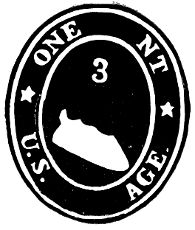
Variety 3:—"S" of "U. S." nearly touches inner frame line.
"CENT": "C" of "CENT" near inner frame line.
"NT" wide. Back of Bust far from inner oval line.
10 mm. from "U" reaches to centre of "N".
" " " "N" touches "E" of "ONE".
" " " "T" strikes a little into the lower bar of "E" of "POSTAGE".
[HW: Distance from "E" to "C" is 3-1/2 mm.]
BUST POINTS BETWEEN A AND G.
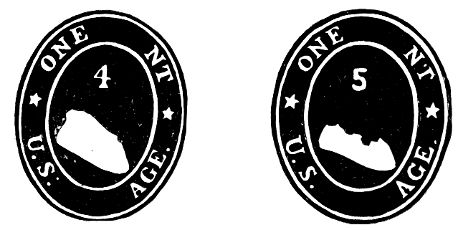
Base line of bust passes through right bar of A.
Varieties 4, 5, 6, 7, 8.
Variety 4:—"O" of "POSTAGE" considerably above outer frame line; "TAGE" close, especially "GE", which are close to inner frame line and above level of the other letters. STAMP measures 20 × 24-1/2 mm. "ONE": "NE" far apart. Letters of "ONE" especially the "E" close to outer frame line. "CENT": "C" far from "E." "POSTAGE": "PO" close. "O" to "U": 7-1/2 mm. From end of upper right point of "C" to top of left stroke of "O" of "ONE" is 5 mm.
Variety 5:—"PO" of "POSTAGE" wide; "OS" and "AGE" near lower frame line: "GE" near. "ONE": "NE" wide. Distance between "ONE" and "CENT" widest. Sometimes a spot under left star and also in central oval at back of head. A rare die. "O" to "U": 8 mm. "C" to "E": 5 mm. falls considerably outside "E".
Variety 6:—Distance between "S" of "U. S." and "P" of
"POSTAGE" wide. "ONE": "NE" wide, and the latter tipped to
right. "POSTAGE": "PO" wide: "TE" wide at foot: "GE" close.
There is often a comma after the "S" of "POSTAGE", and a dot
above the head in the central oval under the "N" of "ONE".
[Pg 43]
"O" to "U": 7-1/4 mm.
"C" to "E": 5 mm. is barely outside "E".
10 mm. from "U" falls at centre of "N".
" " " "T" touches middle of lower bar of "E".
This die is found greatly worn, especially in the wrappers.
Variety 7:—"U" AND "S" close. This is the only die in which
back of bust nearly touches inner frame line. "E" of "ONE"
equidistant from oval lines. "ONE": "NE" far apart.
"POSTAGE": "PO" wide; "ST" wide at foot: "AGE" close.
"O" to "U": 8 mm.
"C" to "E": 5 mm.
10 mm, from "T" touches "E" to the left;
" " " "U" touches "N"
" " " "N" touches middle of top stroke of "E" of "ONE".
Variety 8:—Similar to the last, but back of bust is some
distance from inner oval line. "POSTAGE": "TAGE" closely
spaced and near outer frame line.
10 mm, from "T" strikes one-half mm. into the lower bar of "E".
" " " "U" falls between "O" and "N".
" " " "N" touches "E".
5-1/2 mm. strikes "E".
"O" to "U": 8-1/2 mm.
There is a dot under the left star, and sometimes, also, one above it.
BUST POINTS AT A.
BASE LINE OF BUST CUTS LEFT BAR OF A.
Variety 9:—Back of bust opposite first bar of "U". "S" of
"U. S." and "P" of "POSTAGE" very close. "U. S." widely
spaced. "POSTAGE": "OS" close to lower frame line.
10 mm. from "U" touches "N".
POINT OF BUST BETWEEN A and G. Oval 20 × 24 mm.
Variety 10:—Back and front of bust cut into inner frame line.
NO PERIOD after POSTAGE. Oval 21 × 25 mm.
Bust points between A and G.

Variety 11:—Back of bust opposite second bar of "U". Base of bust nearly touches inner frame line, and entire bust low in frame. "CENT": "C" much nearer "E". "POSTAGE" close to outer frame line.
Bust points at G.
Variety 12:—Same as last, but back of bust far from inner frame line, and entire bust lower in frame. "CENT": "C" much nearer "E". "POSTAGE": "POST" close to inner frame line.
NEWSPAPER WRAPPERS.
By the Act of Feb. 27th, 1861, Chap. LVII, Sec. 2, the Postmaster-General was authorized "to adopt such improvements as may be deemed advisable from time to time in connection with postage stamps or stamped envelopes for letters or newspapers." Under authority of this Act the Postmaster decided to introduce one cent wrappers and they were first issued in October, 1861. By the Act of March 3, 1863, the rate for transient newspapers was changed to two cents, and accordingly, the Post Office issued what is known as the "two cent, Jackson", newspaper wrapper.
Collectors have often complained that the wrappers of this issue are troublesome. This is largely due to the fact that no one has undertaken the task of compiling a complete list of the fairly numerous varieties in existence. Again, the various tints of paper used in this issue have justly caused a good deal of confusion. The catalogues distinguished between coarse and yellow buff, salmon, pale buff and amber buff, pale and dark manila, but it is safe to assume that no two collectors would agree in regard to color. It seems reasonable to distinguish between buff, salmon buff (a pinkish yellow) and yellow buff, while the manila paper used for the one cent wrappers may properly be called coarse manila.
To give the philatelist a broader hold on this issue and a better insight, Mr. J. M. Bartels, together with the writer, has made a thorough study of the one cent wrapper, and the result of their united labor is embodied in the list which will follow this series of articles.
For the identification of a wrapper of this issue it is well to observe the following method:
Note whether the paper is horizontally or vertically laid;
Whether or not the wrapper has a watermark;
Measure the distance between the top of the stamp and the
horizontal edge of the wrapper; it will be found that this
distance varies from 35 to 120 mm. and constitutes a
valuable help for differentiation and identification of a
wrapper;
Note the dimensions of the wrapper which may be:
148 × 225 to 227 mm.
151 × 227 mm.
148 × 257 mm.
151 × 257 mm.
In the absence of a watermark the paper may be either wove or laid. A noteworthy innovation in this issue is the introduction of orange paper used both for envelopes and wrappers.
The one cent wrapper has also been found on a somewhat coarse, white paper, of which the writer has seen a single copy, contained in the magnificent collection of Mr. G. H. Worthington, of Cleveland, Ohio, but, as far as known, the white paper was not issued with the sanction of the Post Office authorities.
An envelope on white paper, of a somewhat similar texture to the wrapper spoken of above, was in the collection of Mr. Van Derlip, of Boston, but, it is impossible to trace its present whereabouts, and, therefore, I have no means of ascertaining the die.
HEAD OF WASHINGTON TO LEFT. A SMALL UPRIGHT OVAL MEASURING 20 × 24 MM. "THREE CENTS" ABOVE; "U. S. POSTAGE" BELOW.
At each side is a six-rayed star between the inscriptions.
NINE VARIETIES.
It has already been mentioned that the new die was issued in accordance with the action of the 36th Congress, and that this stamp is also used to form a compound value with the one cent die.
The collector of entire envelopes finds in this issue two new shapes, knives 6 and 7, of which the former was supposed to supply the needs of the gentler portion of humanity, and is officially known as "Ladies' Note Size," while knife 7 is styled "Medium Letter" and is for commercial correspondence. These envelopes have "patent lines."
With the exception of variety 8, which measures 24-1/2 mm., the vertical dimension of the die is 24 mm. The several varieties may be grouped by observing the position of the back of the bust with relation to the letters "G" and "E" of "POSTAGE."
Group I.—Back of bust points at "G." (Vars. 1 to 7.)
Group II.—Back of bust points between "G" and E." (Var. 8.)
Group III.—Back of bust points almost at "E." (Var. 9.)
For the specialist the writer recommends the use of a 10 mm. unit distance measurement to be applied as follows:
Measure 10 mm. from the top of the highest ray of the left star towards the top of "P" of "POSTAGE." This measurement assists in the identification of varieties 1 and 3. Another measurement may be taken from the left end of the horizontal cross stroke of "N" of "CENTS" towards the "E" of "THREE," and reveals the different spacings between the latter and "CENTS."
BACK OF BUST POINTS AT "G."
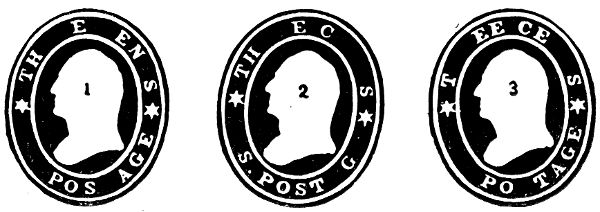
Variety 1:—"PO" close. "AGE" widely spaced. Note that the distance between "T" and the left star is further in Var. 1 than in Var. 2 or 3. "C" of "CENTS" near "E." Width of "U. S." at top 4-1/2 mm.
Variety 2:—An additional period close to the upper end of "S." "O" further from "P." "S" nearer "T" than in Var. 1. "U. S." wider than in Var. 1, measuring 5 mm. across the top. "CE" of "CENTS" wide.
Variety 3:—"PO" spaced as in Var. 2, and "U. S." as in Var. 1; but "PO" and "TA" are spaced wider than in Var. 1.
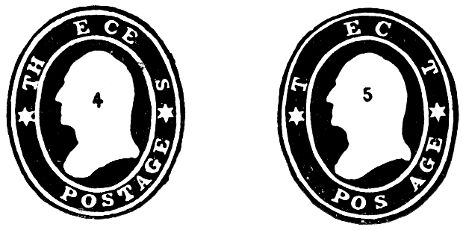
Variety 4:—"O" far from "P." "S" of "POSTAGE" almost touches inner frame line. "AGE" near.
Variety 5:—"PO" close, but "OS" very wide. "AGE" wide.
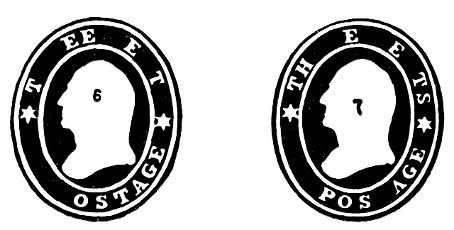
Variety 6:—"ST" very widely spaced; "OS" wide; "AGE" near.
Variety 7:—"A" of "POSTAGE" has no bar; "PO" near; "OS" wide.
BACK OF BUST BETWEEN "G" AND "E."
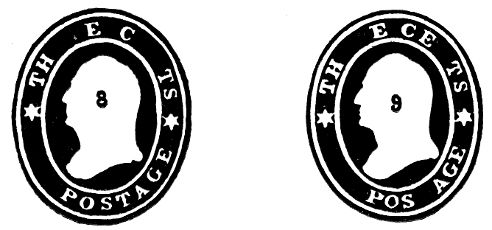
Variety 8:—This is the largest die of the series. Its vertical measurement[Pg 47] is 24-1/2 mm. "PO" close; "ST" close; "AGE" widely spaced.
BACK OF BUST POINTS ALMOST AT "E."
Variety 9:—"POSTAGE" short and lettering very close. 10 mm. measured from the top of "P," reaches "E."
PROOF SET.
It may be of interest to collectors of entire envelopes to mention that a set of envelopes has been catalogued under the supposition that they were regularly issued, but they are now generally believed to be proofs. They are all buff paper and are Var. 8. The following knives and sizes exist:[D]
| S. 3, | Knife | 3, | 221 × 97 mm. | Official. |
| S. 7, | " | 13, | 224 × 96 mm. | " |
| S. 8, | " | 14, | 241 × 100 mm. | Extra Official. |
| S. 8, | " | 15, | 249 × 104 mm. | " " |
| S. 8, | " | 16, | 260 × 110 mm. | " " |
| S. 8, | " | 17. | 271 × 118 mm. | " " |
Letter sheets on blue and white paper with this die are essays or trial printings.
ONE CENT BLUE (FRANKLIN) AND THREE CENTS RED (WASHINGTON).
The reason for the issue of this, the only compound stamp of the U. S. Post Office, has already been stated in the introduction to the one cent. The two stamps were impressed side by side, the one cent to the left and the three cents to the right. The Department issued two sizes of these rather scarce compounds, officially called size 2 and 3. Of the first there exists but one knife, i.e. knife 8 (137 × 77 mm), and of the second two knives, i.e. knives 2 and 9, both measuring 139 × 83 mm. All envelopes exist on white and buff paper, except perhaps variety 5. There are five different combinations of these compounds, which are as follows:
| ONE CENT. | THREE CENTS. | ||
|---|---|---|---|
| Variety 1. | 3 | × | 8 |
| Variety 2. | 4 | × | 4 |
| Variety 3. | 6 | × | 8 |
| Variety 4. | 8 | × | 1 |
| Variety 5. | 10 | × | 8 |
It will be noted that the same variety of the three cents is used with three different combinations of the one cent. By far the rarest of the entire series is variety 5 which represents the Franklin die, in which the back and front of the bust cut into the inner frame line. The writer has seen a few copies of this variety on white paper but none on buff.
From the reports of the Postmaster-General it has been ascertained that the compound stamp was issued only during fifteen months, ending June 30, 1863. On account of the short time that these envelopes remained on sale but 127,250 were issued. This explains their rarity.
HEAD OF WASHINGTON: SIX RAYED STARS FOR SIDE ORNAMENTS.
OVAL 20 × 24 MM.
This die, which was in use from October, 1860, to August 15, 1861, presents us with a new head, which was retained for the next higher denomination, the ten cents, green. Why the head used for the three cents was abandoned by the die maker we do not know. The principal new feature is a very short heavy front-lock which ends far from the ear-lobe. In addition to the front-lock there are three long clusters of hair in the front and four in the rear, of which the two lowest reach into the queue. From the middle of the side-lock extends the wedge-shaped lowest front-lock. It slants but a little distance across the ear-lobe. A long straight lock, made up of three strands, runs from the ear-lobe into the queue. The size of this envelope is "Official" or No. 7, measuring 221 × 98 mm. It is found both on white and buff paper and is very rare.
HEAD OF WASHINGTON; SIX RAYED STARS FOR SIDE ORNAMENTS.
OVAL 20 × 24 MM.
Envelopes bearing the ten cent die were issued from October, 1860, to August 15, 1861. As has already been stated the head is the same as that of the preceding die, but the envelope is different. It is the common knife 2, or "Full Letter," measuring 139 × 83 mm. The paper is white or buff. Of the two, the former is the rarer.
Before taking up the next issue it may be well to remind the collector that the three cents, six cents and ten cents have been reprinted, not on entire envelopes, but on pieces of paper vertically laid, while the originals are on diagonally laid paper.
Envelopes.
ONE CENT, BLUE.
| No. | Paper. | Knife. | Size. | Dimensions. | Gum. | Remarks. |
|---|---|---|---|---|---|---|
| Var. 1. | ||||||
| 157 | B | 2 | 3 | 139 × 83 | U | |
| 158 | B | 2 | 3 | " " | G | |
| Var. 2. | ||||||
| 159 | B | 2 | 3 | 139 × 83 | U | |
| 160 | B | 2 | 3 | " " | G[Pg 49] | |
| Var. 3. | ||||||
| 161 | B | 2 | 3 | 139 × 83 | U | |
| 162 | B | 2 | 3 | " " | G | |
| 163 | B | 5 | 3 | " " | G | |
| Var. 4. | ||||||
| 164 | B | 2 | 3 | 139 × 83 | U | |
| 165 | B | 5 | 3 | " " | U | |
| 166 | B | 5 | 3 | " " | G | |
| Var. 5. | ||||||
| 167 | B | 2 | 3 | 139 × 83 | U | |
| 168 | B | 2 | 3 | " " | G | |
| 169 | B | 5 | 3 | " " | G | |
| Var. 6. | ||||||
| 170 | B | 2 | 3 | 139 × 83 | U | |
| 171 | B | 2 | 3 | " " | G | |
| 172 | B | 5 | 3 | " " | U | |
| 173 | B | 5 | 3 | " " | G | |
| 174 | B | 9 | 3 | " " | U | |
| 175 | B | 9 | 3 | " " | G | |
| Var. 7. | ||||||
| 175a | B | 2 | 3 | 139 × 83 | U | |
| 176 | B | 5 | 3 | " " | U | |
| 177 | B | 5 | 3 | " " | G | |
| Var. 8. | ||||||
| 178 | B | 2 | 3 | 139 × 83 | U | |
| Var. 9. | ||||||
| 179 | B | 2 | 3 | 139 × 83 | U | |
| 180 | B | 5 | 3 | " " | U | |
| 181 | Y.B. | 5 | 3 | " " | U | |
| 182 | Or | 2 | 3 | " " | U | Wove paper, no wmk. |
| 183 | L.Or | 5 | 3 | " " | U | " " " |
| Var. 10. | ||||||
| 184 | Or | 11 | 3 | 139 × 83 | G | |
| Var. 11. | ||||||
| 185 | B | 11 | 3 | 139 × 83 | G | |
| Var. 12. | ||||||
| 186 | B | 11 | 3 | 139 × 83 | G | |
THREE CENTS, RED.
| No. | Paper. | Knife. | Size. | Dimensions. | Gum. | Remarks. |
|---|---|---|---|---|---|---|
| Var. 1. | ||||||
| 187 | W | 7 | 2 | 137 × 77 | G | |
| 188 | W | 8 | 2 | " " | G | |
| 189 | B | 8 | 2 | " " | G | |
| 190 | W | 2 | 3 | 139 × 83 | G | |
| 191 | B | 2 | 3 | " " | G | |
| Var. 2. | ||||||
| 192 | W | 7 | 2 | 137 × 77 | G | |
| 193 | B | 7 | 2 | " " | G | |
| 194 | W | 8 | 2 | " " | G | |
| 195 | B | 8 | 2 | " " | G | |
| 196 | W | 2 | 3 | 139 × 83 | G | |
| 197 | B | 2 | 3 | " " | G | |
| Var. 3. | ||||||
| 198 | W | 6 | 1 | 118 × 65 | G | |
| 199 | W | 1 | 1 | 120 × 73 | G | |
| 200 | W | 2 | 3 | 139 × 83 | G | |
| 201 | B | 2 | 3 | " " | G | |
| Var. 4. | ||||||
| 202 | B | 7 | 2 | 137 × 77 | G | |
| 203 | W | 8 | 2 | " " | G | |
| 204 | B | 8 | 2 | " " | G | |
| 205 | W | 2 | 3 | 139 × 83 | G | |
| 206 | B | 2 | 3 | " " | G | |
| Var. 5. | ||||||
| 207 | W | 2 | 3 | 139 × 83 | G | |
| 208 | B | 2 | 3 | " " | G | |
| Var. 6. | ||||||
| 209 | W | 2 | 3 | 139 × 83 | G | |
| 210 | B | 2 | 3 | " " | G | |
| Var. 7. | ||||||
| 211 | W | 6 | 1 | 118 × 65 | G | |
| 212 | W | 1 | 1 | 120 × 73 | G | |
| 213 | W | 7 | 2 | 137 × 77 | G | |
| 214 | B | 7 | 2 | " " | G | |
| 215 | W | 2 | 3 | 139 × 83 | G | |
| 216 | B | 2 | 3 | " " | G | |
| Var. 8. | ||||||
| 217 | W | 7 | 2 | 137 × 77 | G | |
| 218 | B | 7 | 2 | " " | G | |
| 219 | W | 8 | 2 | " " | G | |
| 220 | B | 8 | 2 | " " | G | |
| 221 | W | 2 | 3 | 139 × 83 | G | |
| 222 | B | 2 | 3 | " " | G | [Pg 51] |
| Var. 9. | ||||||
| 223 | W | 7 | 2 | 137 × 77 | G | |
| 224 | B | 7 | 2 | " " | G | |
| 225 | W | 8 | 2 | " " | G | |
| 226 | B | 8 | 2 | " " | G | |
| 227 | W | 2 | 3 | 139 × 83 | G | |
| 228 | B | 2 | 3 | " " | G | |
FOUR CENTS, RED AND BLUE.
| No. | Paper. | Knife. | Size. | Dimensions. | Gum. | Remarks. |
|---|---|---|---|---|---|---|
| Var. 1. | ||||||
| 229 | W | 9 | 3 | 139 × 83 | G | Var. 3 of 1c. and 8 of 3c. |
| 230 | B | 9 | 3 | " " | G | " " " |
| Var. 2. | ||||||
| 231 | W | 2 | 3 | 139 × 83 | G | Var. 4 of 1c. and 4 of 3c. |
| 232 | B | 2 | 3 | " " | G | " " " |
| Var. 3. | ||||||
| 233 | W | 2 | 3 | 139 × 83 | G | Var. 6 of 1c. and 8 of 3c. |
| 234 | B | 2 | 3 | " " | G | " " " |
| Var. 4. | ||||||
| 235 | W | 8 | 2 | 137 × 77 | G | Var. 8 of 1c. and 1 of 3c |
| 236 | B | 8 | 2 | " " | G | " " " |
| Var. 5. | ||||||
| 237 | W | 8 | 2 | 137 × 77 | G | Var. 10 of 1c. and 8 of 3c. |
| 238 | B | 2 | 3 | 139 × 83 | G | " " " |
SIX CENTS, RED.
| No. | Paper. | Knife. | Size. | Dimensions. | Gum. | Remarks. |
|---|---|---|---|---|---|---|
| 239 | W | 3 | 7 | 221 × 98 | G | |
| 240 | B | 3 | 7 | " " | G |
TEN CENTS, GREEN.
| No. | Paper. | Knife. | Size. | Dimensions. | Gum. | Remarks. |
|---|---|---|---|---|---|---|
| 241 | W | 2 | 3 | 139 × 83 | G | |
| 242 | B | 2 | 3 | " " | G |
WRAPPERS.
ONE CENT, BLUE.
| No. |
Paper.[E] |
Dimensions. |
Horizon'ly or Vertic'ly Laid. |
Dist'ce of st'p from Edge. |
Remarks. |
|---|---|---|---|---|---|
| Var. 3. | |||||
| 243 | S.B. | 148 × 225 | H | 35 | |
| 244 | S.B. | " " | V | 35 | |
| 245 | S.B. | " " | H | 35 | Unwatermarked. |
| 246 | A.B. | 151 × 257 | H | 35 | "[Pg 52] |
| 247 | Y.B. | 148 × 225 | H | 35 | |
| 248 | Y.B. | " " | V | 35 | |
| 249 | Or | 151 × 257 | H | 36 | Unwatermarked. |
| 250 | Or | " " | V | 36 | " |
| 251 | Or | " " | Wove | 36 | " |
| Var. 4. | |||||
| 252 | B | 148 × 232 | V | 38 | |
| 253 | Y.B. | 152 × 257 | V | 120 | |
| 253a | C.M. | " " | V | 120 | |
| Var. 5. | |||||
| 254 | B | 148 × 227 | H | 39 | |
| Var. 6. | |||||
| 255 | B | 148 × 227 | H | 39 | |
| 256 | B | " " | V | 39 | |
| 257 | C.M. | " " | H | 68-71 | |
| 258 | Y.B. | " " | H | 33-37 | |
| 259 | Y.B. | " " | V | 33 | |
| 260 | W | " " | V | 38 | Very rare. But one copy known. |
| Var. 7. | |||||
| 261 | Y.B. | 151 × 227 | H | 35 | |
| 262 | Y.B. | " " | V | 35 | |
| 263 | C.M. | " " | H | 71 | |
| Var. 8. | |||||
| 264 | B | 148 × 227 | H | 39 | |
| Var. 9. | |||||
| 265 | C.M. | 148 × 225 | H | 68-71 | |
| 266 | C.M. | " " | Wove | 71 | Unwatermarked. |
| 267 | B | " " | H | 39 | |
| 268 | B | " " | V | 39 | |
| 269 | B | " " | V | 70 | |
| 270 | Or | [HW: 180 × 260] | 44 | Unwatermarked. | |
| 270a | Or | 180 × 260 | H | 48 | " |
| Var. 10. | |||||
| 271 | C.M. | 148 × 225 | |||
| Var. 12. | |||||
| 272 | B | 148 × 225 | |||
[D] The Knives, Nos. 13, 14, 15, 16 and 17 are those of the list in the Catalogue for Advanced Collectors and are not referred to in the National Society's list.
[E] The abbreviations used to designate the papers are: W—white; B—buff; A.B—Amber-buff; S.B—salmon-buff; Y.B—yellow-buff; Or.—orange and C.M—coarse manila.
In the report of the Postmaster-General for the fiscal year 1861, it is stated that the three, six and ten cent dies would be changed, and the new ones were issued August 15th, 1861. They remained in use till September, 1864. Another important change was the abolishing of the former ten cents, or California, rate which took place shortly after July 1st, 1863.
In addition to these new dies, the Post Office introduced the following new denominations: i.e. 12, 20, 24 and 40 cents. These latter appear on large sized envelopes, known to the cataloguers as Knives 14—Size 7, "Official," 19—Size 8, "Extra Official," and 20—Size 8, "Extra Official." The 1861 report says that the large envelopes were intended for the purpose of mailing large packages and for foreign correspondence. The total issue amounted to 20,000.
Head of Washington facing to left. Inscriptions in outline, block letters. "United States" above: "Three Cents" below, separated on each side by a small circle containing a colorless numeral of value.
The die is an oval measuring in
Die A:—23 mm. or less in width.
Die B:—23 1/2 mm. or more in width.
Die A includes varieties 1 to 7.
Die B includes varieties 8 to 17.
As in former issues, the engraver has presented the collector with various heads which differ in the arrangement of the hair but, as in addition to these minor details the lettering of the various dies is a far more essential feature, it has not been thought necessary to reproduce the heads.
To find the main varieties the following system, based on line prolongation, has been adopted:
Draw a straight line along the outer vertical stroke of the final "E" of "THREE" and note its position with regard to letters "D," "S" and "T" of " UNITED STATES." This establishes four main groups or classes.
Class I.—The line runs to the left of "S" of STATES.
Class II.—The line passes through "S."
Class III.—The line touches the upper bar of "T" to left.
Class IV.—The line runs through centre of "T" or beyond it.
 I, II, III, IV
I, II, III, IV
The varieties of this die are, furthermore, plainly differentiated by the size of the letters used for the inscription. There are three sizes:—very tall letters, medium size, and decidedly small letters.
Even a cursory observation reveals various shapes of the letter "C" of "CENTS," and "D" of "UNITED." Likewise, the spacing between the words and the distance from the words to the circles containing the numerals of value vary considerably.
Formerly the existence of a broken circle at the side was chronicled as one of the most noteworthy varieties, but this feature is of little value. The philatelist may, however, be interested to hear the opinion of Messrs. Tiffany, Bogert and Rechert: "We have concluded that only two varieties are worthy of a place in our list. The others, though existing, are too minute to interest the average collector."
The above statement only proves that Horace is right when he assures us "Quandoque bonus dormitat Homerus." Now and then the best experts are asleep! In the writer's opinion all the varieties of the three cents rose cannot fail to interest the collector, and no two can be singled out as being of more or less importance.
By using a 10 mm. unit distance measurement, we detect numerous other varieties, of which some are shown in the subjoined diagram.
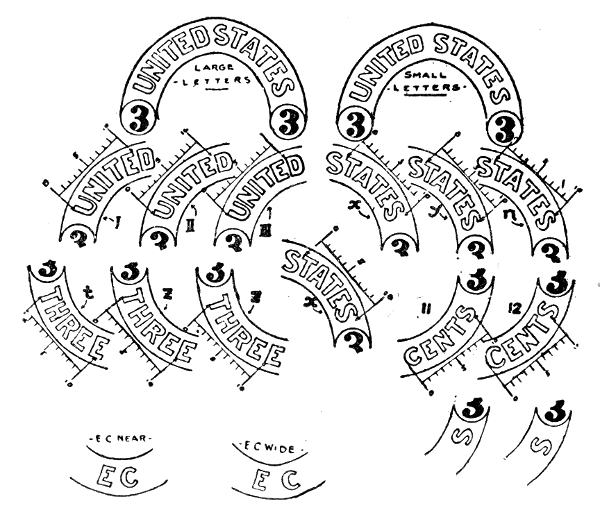
We are now prepared to study the several varieties of Dies A and B.
DIE A.
Class II.
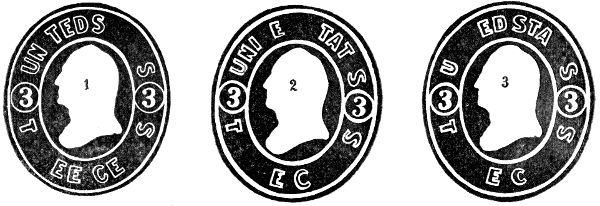
Variety 1:—Elongated "C" without dot in centre. The lettering is large. Wide, open "U." "NITE" widely spaced, especially "TE." "ED" near. "U" far from "3." "DS" near. "S" of "STATES" near "3." "T" of "THREE" far from "3." "HR" wide. "RE" wide at top. "NT" wide at base. "S" large and far from "3." Uncommon on white, very rare on buff.
Variety 2:—Open, short "U." Large, wide open "C." Small lettering. Wide, open "U," and far from "3." "NITE" widely spaced. "TAT" well spaced at top. "S" near "3." "T" of "THREE" near "3." "EC" wide. "C" of "CENTS" is tall, well rounded, and its ends are far apart. "S" of "CENTS" far from "3." Found on white and buff paper, quite rare.
Class III.
Variety 3:—Smallest letters; "S" of "CENTS" not so near as in Var. 4. "U" very small, contracted at top, and far from "3." "UNITE" evenly spaced; "ED" wide at top and "D" in an almost vertical position. "DS" wide. "TA" of "STATES" wide at top. "T" of "THREE" near "3." "EC" wide. "C" small and wide open. "C" far from "E." "TS" close at top. Common on both papers.

Variety 4:—Similar to variety 3. "S" of "STATES" nearer circle. The lettering of this variety is like that of Variety 3, but "U" of "UNITED" is nearer "3" and "S" of "CENTS" close to "3." Note also that the top stroke of the "T" of "THREE" is shorter on the left than on the right. Found only on buff, but quite common.
Class IV.
Variety 5:—"U" very near circle. Rather small letters. Space between bars of "U" narrow. "NI" wide at top. "DS" near. Final "S" of "STATES" near "3." "T" of "THREE" very far from "3." "C" small, open and end poorly rounded. "EC" wide. "S" of "CENTS" far from "3." Perhaps the rarest of all the varieties.
Variety 6:—"C" large, well formed, and far from "E." Similar to Variety 5. "U" further from "3," more open, and larger than in Variety 5. "C" well rounded and large. "S" of "STATES" large.
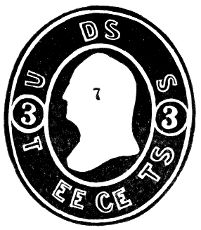
Variety 7:—Elongated "C" with dot in centre. Large lettering. "U" nearly horizontal and near "3." This variety has several characteristic features. 1st:—"TS" of "CENTS" is very widely spaced at base; 2nd:—"C" of "CENTS" is tall, straight and oval shaped. 3rd:—The left cross stroke of "T" of "THREE" is very short, and the letter is out of proportion to those of the rest of the inscription. "EE" of "THREE" widely spaced. "D" is large and slants decidedly to the left. "DS" close. Final "S" of "STATES" near "3." "EC" wide. "S" of "CENTS" far from "3."
DIE B.
Excepting perhaps numbers 9 and 14, the lettering of the varieties of this class is generally large.
Class I.
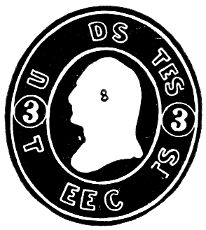
Variety 8:—Widest space between "S" of "CENTS" and circle. "U" narrow and tall, and in a nearly horizontal position; first bar much thicker than the second. "D" of "UNITED" well rounded at top. "DS" near. "S" in vertical position. Wide distance at base of letters "TE" of "STATES." "ES" close, and "S" near "3." "T" of "THREE" has a long crossbar and is far from "3." "HR" widely spaced, but "R" and "E," as well as "T" and "S" almost touch at top. "EC" near. "C" of "CENTS" is large, oval and open.
Class II.
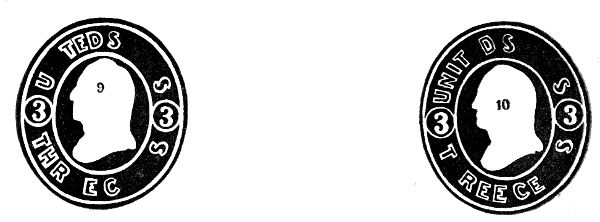
Variety 9:—Circular "C." Smallest lettering in Die B, "U" near circle. "U" small, short and near "3." "TE" almost joined at top. "DS" close. "STATES" spaced closely, and final "S" far from "3." "T" of "THREE" slender and far from "3." "HR" wide. "EC" near. "C" of "CENTS" small, almost circular, and its end-curves close together. "S" far from "3." There is often a white dot over the centre of "R" of "THREE."
Variety 10:—"U" nearly touches circle. Medium large lettering. "U" very close to "3;" it is long and wide open. "NT" widely spaced. "DS" wide at top. "T" of "THREE" far from "3." "RE" widely spaced. "EC" near. "C" of "CENTS" round with a wide space between the end-curves. Wide space between "C" and "E." "S" far from "3." "ENTS" appear smaller than the other letters.
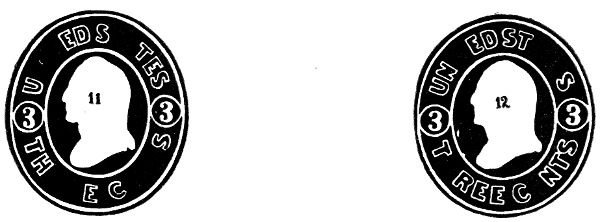
Variety 11:—"EC" very wide; "U" rather small. Large lettering. "U" narrow and far from "3." "D" of "UNITED" large and rounded, and "ED" close. "DS" close. Note in "STATES" wide space between "T" and "E." "ES" close at base. "S" far from "3." "T" of "THREE" near "3." "HRE" well spaced. "C" of "CENTS" round; top curve, short. "S" near "3."
Variety 12:—"U" far from circle. Large, round "C" close to "E." Large lettering. Second bar of "U" thinner than first. "UNIT" closely spaced; "ED" wide at top. "DS" near. "ST" of "STATES" close. The entire word "STATES" is very closely spaced. "S" far from "3." "T" of "THREE" near "3." Note that "RE" are close at top. "EE" close. "N" is unusually broad. "TS" almost touch. "S" far from "3."
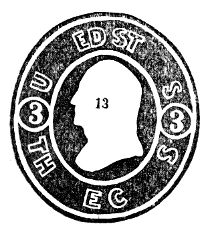
Variety 13:—There is generally a dot under right circle. Large lettering. "U" near "3" "UNITED" closely spaced. "DS" near. "STATES" is also closely spaced. "S" near "3." "T" of "THREE" short and near "3," and "TH" wide at base. "REE" well spaced. "EC" near. "C" of "CENTS" elongated, tipped to the left, and its end curves wide apart. "CE" well spaced, but "ENTS" close. "S" near "3." There is frequently a dot after "S" of "CENTS." Found on white and buff.
Class III.
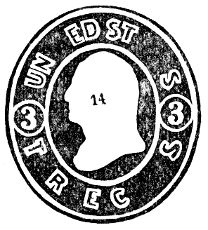
Variety 14:—"U" very far from circle. Small letters. "U" of "UNITED" small and contracted. "UNITED" is closely spaced, but "ED" is wide at top. "DS" near. Excepting "ST" the rest of "STATES" is also closely spaced. "S" near "3." "T" of "THREE" close to "3." "TH" near. "HREE" well spaced. "C" of "CENTS" is small and its curves short. "S" far from "3."
Class IV.
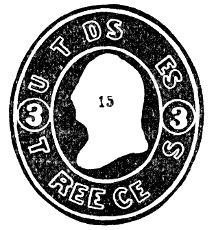
Variety 15:—"S" of "STATES" very far from circle. "U" near circle. "UNI" close. "T" has a long top stroke and "TED" wide at top. "DS" near. "S" large; "AT" spaced, and base of "E" short. "T" of "THREE" small and near "3." "TH" wide. "RE" close at top, "EC" near. "C" of "CENTS" is tall and its end-curves wide apart. "CE" wide. "S" near "3."
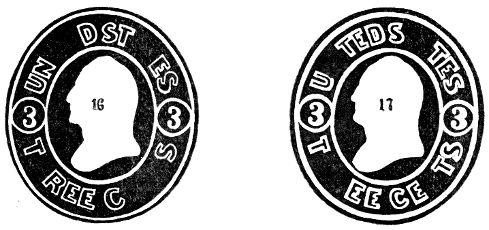
Variety 16:—Largest "C." "RE" and "TS" joined. Large lettering. This variety has a wide color margin both above the upper inscription and below the lower one. "UNITED" close. "DS" near. "STATES" close. "S" close to "3." "T" near "3." "RE" nearly joined at top. "EC" near. "C" large, broad and the lower curve considerably longer than the upper one. "CE" close. "TS" touch at top. "S" far from "3."
Variety 17:—Large square "D." "C" far from "E." "U" is close to "3," "U" contracted. "UNITED" close and "TE" touch at top. Note that "D" is nearly square. "DS" near. "STATES" close. "T" near "3." "HR" well spaced. "C" rather small and far from "E." "NTS" close; "TS" touch. "S" near.
The subjoined tables are added merely to aid the collector in recognizing the different varieties:
LETTERING.
Very small:—Varieties 3, 4.
Medium:—Varieties 5, 6, 9, 14.
Large:—Varieties 2, 7, 8, 10, 11, 13, 15, 17.
Very large:—Varieties 1, 12, 16.
DISTANCE FROM "U" TO LEFT CIRCLE.
1) Close:—Varieties 5, 10.
2) Medium:—Varieties 4, 6, 7, 8, 9, 11, 13, 15, 16, 17.
3) Far:— Varieties 1, 2, 3, 12, 14.
Varieties 2, 3, 4, 5, 6, 7 and 17 are found on Knife 2 only.
The design of the SIX CENTS is very similar to the last one, but the numerals at sides are in ovals. The lettering is also in outline block capitals. No varieties of this die exist.
In the beginning of the year 1861, Nesbitt produced new dies of the 12, 20, 24 and 40 cents values, and later, in August, the 10 cents. No varieties of these dies exist. The design consists of an horizontal oval, 27-1/2 × 25 mm. showing the bust of Washington in an upright, colored oval, surrounded by a broad, colorless band 3-1/2 mm. wide, inscribed in colored block capitals, with the value above and "U. S. POSTAGE" below. At each side is a circle with colored numerals. The ornaments above and below the circles consist of branches with seven leaves each.
With the exception of the Ten Cents, the new stamps are bi-colored: i.e.
12 cents: brown and red.
20 " blue and red.
24 " green and red.
40 " black and red.
Envelopes.
THREE CENTS, ROSE.
| No. | Class. | Die. | Paper. | Knife. | Size. | Dimensions. | Remarks. |
|---|---|---|---|---|---|---|---|
| Var. 1. | |||||||
| 273 | 2 | A | B | 7 | 2 | 137 × 77 | |
| 274 | " | " | W | 2 | 3 | 139 × 83 | |
| 275 | " | " | " | 11 | 3 | " | |
| 276 | " | " | B | 11 | 3 | " | |
| Var. 2. | |||||||
| 277 | 2 | A | W | 2 | 3 | 139 × 83 | |
| 277a | 2 | A | B | 2 | 3 | " | |
| Var. 3. | |||||||
| 278 | 3 | A | W | 1 | 1 | 120 × 73 | |
| 279 | " | " | W | 2 | 3 | 139 × 83 | |
| 280 | " | " | B | 2 | 3 | " | |
| Var. 4. | |||||||
| 281 | 3 | A | B | 2 | 3 | 139 × 83 | |
| Var. 5. | |||||||
| 282 | 4 | A | W | 2 | 3 | 139 × 83 | |
| 283 | " | " | B | 2 | 3 | " | |
| Var. 6. | |||||||
| 284 | 4 | A | W | 2 | 3 | 139 × 83 | |
| 285 | " | " | B | 2 | 3 | " | |
| Var. 7. | |||||||
| 286 | 4 | A | W | 2 | 3 | 139 × 83 | |
| 287 | " | " | B | 2 | 3 | " | [Pg 61] |
| Var. 8. | |||||||
| 288 | 1 | B | W | 1 | 1 | 120 × 73 | |
| 289 | " | " | W | 1 | 1 | " | Wove paper, no wmk. |
| 290 | " | " | W | 10 | 1 | 122 × 76 | |
| 291 | " | " | B | 7 | 2 | 137 × 77 | |
| 292 | " | " | W | 2 | 3 | 139 × 83 | |
| 293 | " | " | W | 2 | 3 | " | No wmk. |
| 294 | " | " | B | 2 | 3 | " | |
| 295 | " | " | Or. | 2 | 3 | " | |
| 296 | " | " | W | 5 | 3 | " | |
| 297 | " | " | B | 5 | 3 | " | |
| 298 | " | " | W | 9 | 3 | " | |
| 299 | " | " | B | 9 | 3 | " | |
| 300 | " | " | W | 12 | 5 | 160 × 90 | |
| 301 | " | " | W | 12 | 5 | " | No wmk. |
| 302 | " | " | B | 12 | 5 | " | |
| 303 | " | " | B | 12 | 5 | " | No wmk. |
| 304 | " | " | Or. | 12 | 5 | " | " " |
| Var. 9. | |||||||
| 305 | 2 | B | W | 2 | 3 | 139 × 83 | |
| 306 | " | " | B | 2 | 3 | " | |
| 307 | " | " | W | 9 | 3 | " | |
| Var. 10. | |||||||
| 308 | 2 | B | W | 6 | 1 | 118 × 65 | |
| 309 | " | " | W | 1 | 1 | 120 × 73 | |
| 310 | " | " | W | 7 | 2 | 137 × 77 | |
| 311 | " | " | B | 7 | 2 | " | |
| 312 | " | " | W | 2 | 3 | 139 × 83 | |
| 313 | " | " | B | 2 | 3 | " | |
| 314 | " | " | W | 5 | 3 | " | |
| 315 | " | " | B | 5 | 3 | " | |
| 316 | " | " | B | 12 | 5 | 160 × 90 | |
| Var. 11. | |||||||
| 317 | 2 | B | W | 2 | 3 | 139 × 83 | |
| 318 | " | " | B | 2 | 3 | " | |
| 319 | " | " | B | 9 | 3 | " | |
| 320 | " | " | W | 12 | 5 | 160 × 90 | |
| 321 | " | " | B | 12 | 5 | " | |
| Var. 12. | |||||||
| 322 | 2 | B | W | 6 | 1 | 118 × 65 | |
| 323 | " | " | W | 1 | 1 | 120 × 73 | |
| 324 | " | " | W | 10 | 1 | 122 × 76 | |
| 325 | " | " | W | 2 | 3 | 139 × 83 | |
| 326 | " | " | B | 2 | 3 | " | [Pg 62] |
| 326a | " | " | W | 5 | 3 | " | |
| Var. 13. | |||||||
| 327 | 2 | B | B | 3 | [HW: 3] | 137 × 77 | |
| 327a | " | " | W | 2 | [HW: 3] | 139 × 83 | |
| 328 | " | " | B | 2 | 3 | " | |
| 329 | " | " | B | 9 | 3 | " | |
| Var. 14. | |||||||
| 330 | 3 | B | W | 6 | 1 | 118 × 65 | |
| 331 | " | " | W | 1 | 1 | 120 × 73 | |
| 332 | " | " | W | 7 | 2 | 137 × 77 | |
| 333 | " | " | W | 2 | 3 | 139 × 83 | |
| 334 | " | " | B | 2 | 3 | " | |
| Var. 15. | |||||||
| 335 | 4 | B | B | 2 | 3 | 139 × 83 | |
| 336 | " | " | W | 9 | 3 | " | |
| 337 | " | " | B | 9 | 3 | " | |
| Var. 16. | |||||||
| 338 | 4 | B | W | 7 | 2 | 137 × 77 | |
| 339 | " | " | W | 2 | 3 | 139 × 83 | |
| 340 | " | " | B | 2 | 3 | " | |
| 341 | " | " | W | 9 | 3 | " | |
| 342 | " | " | B | 9 | 3 | " | |
| Var. 17. | |||||||
| 343 | 4 | B | W | 2 | 3 | 139 × 83 | |
| 344 | " | " | B | 2 | 3 | " | |
SIX CENTS, ROSE.
| No. | Paper. | Knife. | Size. | Dimensions. | Remarks. |
|---|---|---|---|---|---|
| 345 | W | 3 | 7 | 221 × 98 | |
| 346 | W | 3 | 7 | " | No wmk. |
| 347 | B | 3 | 7 | " | Also left over right flap. |
| 348 | B | 3 | 7 | " | No wmk. |
| 349 | W | 21 | 7 | 225 × 98 | |
| 350 | B | 21 | 7 | " | Also horizontally laid. |
TEN CENTS, GREEN.[F]
| No. | Paper. | Knife. | Size. | Dimensions. | Remarks. |
|---|---|---|---|---|---|
| 351 | W | 2 | 3 | 139 × 83 | |
| 352 | B | 2 | 3 | " | |
| 353 | W | 11 | 3 | " | |
| 354 | B | 11 | 3 | " | |
| 355 | A | 11 | 3 | " | |
| 356 | W | 5 | 3 | " | |
| 357 | B | 5 | 3 | " | |
| 358 | W | 9 | 3 | " | |
| 359 | B | 9 | 3 | " |
TWELVE CENTS, BROWN AND RED.
| No. | Paper. | Knife. | Size. | Dimensions. | Remarks. |
|---|---|---|---|---|---|
| 360 | A | 19 | 7 | 226 × 97 |
TWENTY CENTS, BLUE AND RED.
| No. | Paper. | Knife. | Size. | Dimensions. | Remarks. |
|---|---|---|---|---|---|
| 361 | A | 14 | 8 | 241 × 100 |
TWENTY-FOUR CENTS, GREEN AND RED.
| No. | Paper. | Knife. | Size. | Dimensions. | Remarks. |
|---|---|---|---|---|---|
| 362 | A | 20 | 8 | 249 × 104 | |
| 363 | S.B. | 20 | 8 | " |
FORTY CENTS, BLACK AND RED.
| No. | Paper. | Knife. | Size. | Dimensions. | Remarks. |
|---|---|---|---|---|---|
| 364 | A | 20 | 8 | 249 × 104 | |
| 365 | S.B. | 20 | 8 | " |
LETTER SHEETS.
THREE CENTS, ROSE.
| No. | Class. | Die. | Paper. | Dimensions. | Remarks. |
|---|---|---|---|---|---|
| Var. 8. | |||||
| 366 | 1 | B | Blue | 256 × 205 | Letter size. |
| 367 | " | " | " | 205 × 171 | Note " |
| Var. 10. | |||||
| 368 | 2 | B | Blue | 256 × 205 | Letter size. |
| 369 | " | " | " | 205 × 171 | Note " |
[F] The shade of green varies greatly in these envelopes.
The Act of March 3rd, 1863, establishing a two cent rate for drop letters and abolishing the carrier's fee, made the issue of a two cent stamped envelope and wrapper imperative. The new die appeared about the middle of 1863, and is a miserable caricature of Jackson, facing the left. The inscriptions are "U. S. POSTAGE" above, and "TWO CENTS" below, in colorless, block letters. We may as well state at once that in the next year (1864), the design, though retaining Jackson's bust, was altered, and the upper inscription changed to read "U. S. POST."
Both of these issues have a number of varieties, but of the two the design inscribed "U. S. POST" is by far the most interesting, and any philatelist who devotes some study to this, the "spoiled child" of the Post Office, will quickly be fascinated with it. Indeed, a fine collection of these die varieties must be a revelation to those philatelists who have, so far, kept aloof from collecting them under the specious plea that such collection required too much study and labor, and the[Pg 64] differences were mere gossamer threads woven by the overwrought imagination of some wild enthusiast. It is undeniable that until recently the multitude of Jackson varieties—unclassified and jumbled together as they were—did not present an inviting field for the general collector. But that difficulty has now been overcome, and we have the various designs grouped into distinct classes, which even an untrained person can recognize at a glance.
Those who possess a number of Jackson dies cannot have failed to observe that in various specimens the forward end of the bust points to different letters of the word "TWO" in the lower label. It required no great amount of ingenuity to examine all known varieties of this die, and to reach the conclusion that this important feature should be selected as one point of a line measurement which would subdivide the varieties into distinct classes. In carrying out this idea it was equally apparent that in order to draw a straight line we need two definite points, but the problem was: which point would serve our purpose best? Luckily the design lent itself admirably to the construction of such a line and the second, or starting point, was found in the point of contact of the right hand oval with the inner frame line of the upper label. The line is, then, drawn from this point to the left extremity of the bust and prolonged until it strikes the letter "W" or "O" of "TWO." In this manner five definite and unmistakable classes are established, each of which may contain a number of varieties. While this system is indispensible for classification, the collector, after a very little training, may omit the actual line measurement, as the eye is sufficient to note the class to which any variety belongs. The five classes are:
Class I.—Line cuts first stroke of "W" of "TWO."
Class II.—Line cuts second stroke of "W" of "TWO."
Class III.—Line cuts third stroke of "W" of "TWO."
Class IV.—Line cuts last stroke of "W" of "TWO."
Class V.—Line falls outside of "W" and sometimes cuts "O."
 I. II. III. IV. V.
I. II. III. IV. V.
It may be well to state here that the die reading "U. S. POSTAGE" exists only in classes I., II., IV., and V., and the reading "U. S. POST" in classes II., III., IV. and V.
The design consists of two concave and convex curves, of which the first two form the upper, and the second two the lower label. Each of these two curves meet in a point. The sides of the design are a pointed oval consisting of the sections of a large circle. The inscription in the upper label is "U. S. POSTAGE"; in the lower "TWO CENTS" with the figure "2" in the ovals at the sides.
The 1863 design was issued with two shapes of the figure "2",[Pg 65] which is probably due to an oversight of the engraver; but, as every collector knows, the design in which the lowest stroke of the figure "2" starts sharply from the downstroke, and does not curve back with it is a rarity possessed only by a few lucky mortals.
In the general catalogues the common form is known as "Die A," the latter as "Die B."
DIE A. (Seven Varieties).
They are subdivided as follows:
Class I.—Var. 1 Wrapper only.
Class II.—Var. 2 Wrapper only.
Class IV.—Var. 3 to 6 Envelope and Wrapper.
Class V.—Var. 7 Wrapper only.
DIE A.
Class I.
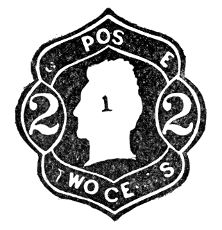
Variety 1 (22-1/4 × 25-3/4 mm.).
Bust points to centre of "W," which touches line above.
"O" of "POSTAGE" to left, but near the junction point of the inner frame line; "OS" nearly on level. "W" of "TWO" near inner frame line, and touching the latter in deteriorated dies. "OC" near. A line drawn through the junction point of the upper and lower inner frame lines cuts the end curves of the "C" of "CENTS." "CE" well spaced, but "C" lower than "E." "S" far from the right oval line. Figure "2" in right oval nearly touches at left. In deteriorated dies both figures touch at left. The tip of nose is near the left oval.
Class II.
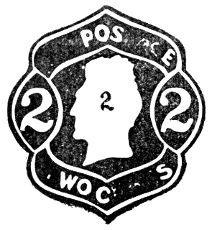
Variety 2 (22-3/4 × 25-1/2 mm.).
"POS" very near. "E" of "POSTAGE" touches frame.
Top of "TWO" far from left oval line, and distance between "O" of "TWO" and "C" of "CENTS" nearer than in Var. 1. Nose near left oval.
Class IV.

Variety 3 (22 × 26 mm.).
"O" in the centre of label and highest letter.
Centre line passes through "O" and "C" of "CENTS." The downstroke of "2" in the left oval touches inner frame. "C" of "CENTS" is the lowest letter, and "ENT" is widely spaced. Distance between "OC" wider than in Var. 2. Nose near left oval.
Variety 4 (22-1/2 × 25 mm.).
"OS" on a level. "OC" very wide.
"POS" wide and "O" to the left of the point. Centre line touches "O" to the right, and passes through the centre of "C" of "CENTS." Left numeral does not touch outer frame line. "S" of "CENTS" very far from right oval. Nose far from left oval.
Variety 5 (22-1/2 × 25-3/4 mm.).
"S" is the highest letter, far from line below.
A considerable margin between top of letters "S. POS" and the outer frame line. "PO" close. "GE" wide at top. Centre line touches "O" to right and passes through the curves of "C" of "CENTS." Numerals in ovals do not touch. Distance between "O" of "TWO" "and "C" of "CENTS" wide. "C" low. Nose near left oval.
Variety 6 (22 × 25-3/4 mm.).
Back of head close to right oval.
The entire inscription in the upper label is close to the inner frame line and the letters are spaced closely. "U. S." is spaced closer than in any other variety. Point of bust almost touches the frame line. Distance between "O" of "TWO" and "C" of "CENTS" near. "CE" very close. "S" near right oval. Nose near left oval.
Class V.
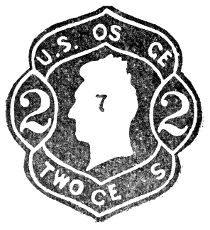
Variety 7 (22-1/2 × 25 mm.).
Bust points between "W" and "O."
"U. S." widely spaced. "OS" on level. "GE" close. "T" of "TWO" far from left oval. "OC" wide. "C" well under the point, and far from "E." "CENTS" well spaced, and "S" far from right oval.
DIE B.
Class IV.

Variety 8 (21-1/2 × 25 mm.).
In the numerals of value the end stroke does not curve back, but slants sharply from the downstroke.
"S" of "U. S." and "P" of "POSTAGE" are spaced closely. "O" to left of point. Top of "S" is a little above "O" and "T." Distance between "O" of "TWO" and "C" of "CENTS" very wide. "C" by far the lowest letter. The hair projects beyond the forehead, and the nose is near left oval.
This issue adds no new shapes of envelopes, only two knives are used, and they are No. 2 and 11, both known as "Full Letter," Size 3, measuring 139 × 83 mm. It has already been stated that the wrappers bearing the design of Dies A. and B. were issued in accordance with the Act of March 3, 1863, which changed the rate of postage for "transient newspaper" to two cents. Shortly after their issue the Post Office was informed that the wrapper, as issued with a marginal coating, infringed the patent issued to L. P. Mara, and that the inventor would assert his rights. We do not know what step the Department took to allay the ire of the famous patentee, but we do know that the issue of newspaper wrappers was suspended for about six months, to commence anew in April 1865.
Of more interest to the collector is the paper of these wrappers which, generally speaking, is a rough manila, varying considerably in shade. The width of the wrapper varies also from 148 to 152 mm., the length from 227 to 230 mm., while the stamp is from 62 to 72 mm from the gummed top of the wrapper.
Towards the end of 1864, Nesbitt (the contractor for furnishing the Post Office Department with stamped envelopes and newspaper wrappers) had considerable financial trouble in living up to his obligations and, at his earnest request, Congress passed a bill for his relief. As the then existing contract expired Sept. 11, 1864, the Post Office Department entered into a new agreement with Nesbitt, paying an advanced rate to the contractor and ordering a change of the dies of the two, three and six cents values.
At present we are interested only in the change of the two cent die. In its new form the general features have been retained, but the inscription is altered to read "U. S. POST" and the shape of the stamp is either narrow or broad.
The narrow die is called by the cataloguer "DIE C" and the broad one "DIE D."
Using the system of line prolongation which has been already fully described, we are at once in a position to handle the large number of varieties and to collect them systematically.
| C Dies. (24 to 25 mm. width) | ||
|---|---|---|
| Class II | Var. 1 and 2. | Bust points to intersection of 2nd and 3d stroke of "W." |
| " III | " 3 to 9. | " " to last stroke of "W." |
| " IV | " 10 to 13. | " " to left line of "O." |
| " V | " 14 to 16. | " " to middle of "O." |
| D Dies. (25-1/2 to 26-1/4 mm. in width.) | ||
| Class III | Var. 17 to 21. | |
| " IV | " 22 to 27. | |
| " V | " 28 to 40. | |
As these varieties have never been thoroughly described and classified and as there are but few collectors who have recognized the great philatelic value of the Jackson dies, the writer desires to place himself on record with a prophecy; i. e. that as soon as the general collector knows how to find and to easily recognize the different varieties of "U. S. POST," these dies are going to be sought after enthusiastically.
To assist those who desire to become better acquainted with them it will do no harm to give some additional information, showing how the writer has studied the varieties and what means he has employed to differentiate the several varieties belonging to one class.
Although the description of the varieties accompanying the cuts, should be sufficient for the identification of any die variety, the writer has found that a system of line prolongation is very useful whenever, due to die deteriorations, a stamp appears to possess features which are not found in the descriptions. The system is based on the position of five letters which differ greatly in many varieties. These letters are:—
1) "U" of "U. S."
2) "P" of "POST."
3) "T" of "POST"
4) "W" of "TWO."
5) "E" of "CENTS."
and the measurements are made as follows:
The left stroke of "U" is prolonged downward. Observe the line with regard to letters "O, C, E" and "N."
The upright stroke of "P" is prolonged downward. Observe line with regard to letters "C" and "E."
The central stroke of "T" is prolonged downward. Observe line with regard to letters "W, O, C" and "E."
The left stroke of "W" is prolonged upward. Observe line with regard to letters "S" of "U. S." and "P" of "POST."
The left stroke of "E" is prolonged upward. Observe line with regard to letters "U." and "S."
The student who employs these measurements will find that, taking the various dies belonging to one class, one of the above mentioned five line prolongations is sufficient to clearly differentiate any variety of that group from any other. For instance, Class one includes but two varieties. In Var. 1, a line prolongation of the "T" of "POST" cuts through the "O" of "TWO;" in Var. 2 it passes along the second stroke of "W." In case of doubt that single measurement is decisive.
As an additional safeguard to the collector the characteristic line measurement is mentioned at the end of the description of each variety.
CLASS II.
Bust points to intersection of second and third stroke of "W."
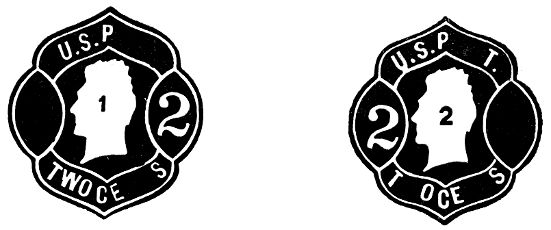
VARIETY 1 (24 × 26-3/4 mm.)
Narrow "U" far from oval line. Buff and Orange.
"POST" 7-1/2 mm. There is generally a dot near top of left bar of "U." "U. S." close. "P" nearly vertical. "T" of "TWO" far from left oval; "WO" close; "OC near; "S" of "CENTS" near right oval. Figures of value are exactly in centre of the side ovals. Nose near left oval. "E" line through left stroke of "U." Envelopes only.
VARIETY 2. (24 × 25-1/2 mm.)
Narrow "U" touching line below. Dark Manila.
"POST" fully 8 mm. "P" vertical, much above level of "O." "O" turned to the right. "ST" wide and "T" far from right oval; "WO" very close; "OC" close; "CE" close; "NTS" near inner frame line. Nose near left oval. "E" line to left of "S" of "U. S." Wrapper only.
CLASS III.
Bust points to last stroke of "W."

VARIETY 3. (24-1/2 × 26-1/4 mm.)
Narrow "U." "PO" on a level. "O" and "C" near. Buff and Orange.
"POST" 7-1/2 mm. "P" slants to left. "POST" evenly spaced. "T" far from right oval. "T" of "TWO" far from left oval; "WO" close; "C" considerably to left of the junction of the inner frame line. "EN" spaced a little wider than "NTS." "S" near right oval. Nose further from oval line than in Variety 1 and 2. Downstroke of right figure "2" is slim. "U" line through "C." Envelopes only.

VARIETY 4. (24-3/4 × 26-1/2 mm.)
Narrow "U." "OC" and "EN" very wide. Dark Manila.
"POST" 8 mm. Top of "P" near outer frame line. "PO" near, but "OS" widely spaced. "T" far from right oval. "T" of "TWO" near left oval. Nose far from left oval. End of downstroke of right figure "2" nearly touches inner oval line. "W" line passes through head of "P." Wrapper only.
VARIETY 5. (24-1/4 × 26 mm.)
"U" tall, wide open, and near inner frame line. Buff and orange.
"POST" 8 mm. "SP" near at base. "POST" closely spaced. "T" far from right oval. "T" of "TWO" near left oval. "W" narrow and close to "O." "OC" close. "CE" near at base. "S" near right oval. End of downstroke of right figure "2" near inner oval line. Nose far from left oval. "P" line passes through junction point of the two inner oval lines of lower label. Envelopes only.
VARIETY 6. (24-3/4 × 25 mm.)
"P" vertical and much above level of "O." Buff Orange and Dark Manila.
Outer frame line of upper label near to "U. S." and "PS" of "POST"[Pg 71] "POST" 8 mm. "U" wide and far from left oval. "SP" wide at top. "POST" well spaced. "O" considerably to right of point and slanting to right. "T" far from right oval. "T" of "TWO" near left oval. "WO" near. "OC" near, but top of "C" some distance below the point. "ENT" near. "S" near right oval. The left figure "2" is well in the centre of the oval, but the right one is near the inner frame line. Nose far from left oval. "E" line passes through center of "S" of "U. S."
VARIETY 6a. (24-3/4 × 25 mm.)
"P" slanting to left over point. "O" far from lower frame line and far to right of point. Buff.
"POST" 8 mm. "U" large, wide open, tipped to left, and far from left oval. "O" slants to right. Letters of "POST" well spaced. "T" far from right oval line. "T" of "TWO" near left oval line. "WO" close. "OC" near. "CENTS" near; "S" close to right oval. Nose near left oval. "U" line cuts "E" from left to right.
Similar to Var. 6, except that "P" and "O" are nearly on a level and the entire upper inscription is well in center of label.
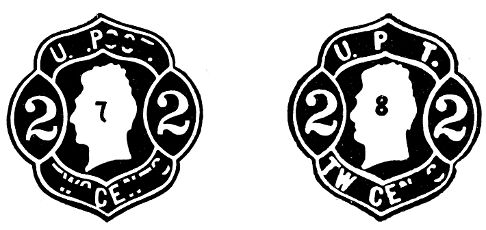
VARIETY 7. (24 × 26 mm.)
Nose generally touches line. Buff, Orange and Dark Manila.
"POST" 8 mm. "U" large, wide open, close to inner frame line and far from left oval. "P" well to left of junction of the two inner frame lines. "O" near the latter. "OS" widely spaced and "T" far from right oval. "T" of "TWO" far from left oval. "WO" close. "OC" near and base of "C" touches outer frame line. "EN" far. "NT" wide at base. "S" close to right oval. End of down stroke of both figures far from their respective oval lines. "E" line passes through first stroke of "U."
VARIETY 8. (23-3/4 × 26-1/4 mm.)
"O" above level of "P." "U. S." close. Buff, Orange and Dark Manila.
"POST" 8 mm. "U" large, wide open equally far from outer and inner frame line, and far from left oval. "P" to left of junction point of the two inner frame lines. "PO" closer than "OS." "T" far from right oval. "T" of "TWO" close to left oval and base of "T" touches outer frame line. "WO" close. "OC" near. "C" low. "EN" wide. "S" far from right oval. Nose quite near left oval.[Pg 72] End of down stroke of right figure "2" nearly touches inner oval line. "U" line passes along downstroke of "E."
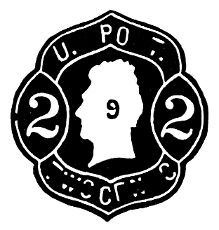
VARIETY 9. (23-3/4 × 26-1/4 mm.)
"U" almost vertical. "PO" wide. Buff and Orange.
"POST" 8-1/2 mm. "U" large, nearly touching outer frame line and far from left oval. Wide space between "S" and "P." "O" well to the right of junction point of the two inner frame lines. "T" far from right oval. "T" of "TWO" close to left oval. "WO" close. "OC" near. "CE" close, but "C" lower than "E." "EN" well spaced. "TS" close and "S" close to right oval. Figure in left oval well centered, but end of downstroke of right figure "2" near inner oval line. Nose near left oval. "T" line touches "O" of "TWO" to the left. Envelopes only.
CLASS IV.
Bust points to left line of "O."
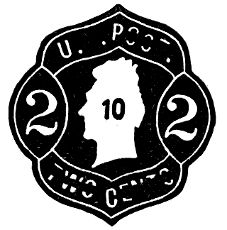
VARIETY 10. (24-1/4 × 26 mm.)
Narrow "U." Pointed bust, often touching line below. Buff and Dark Manila.
"POST" 7-1/2 mm. "U" far from "S," and far from right oval. "SP" very widely spaced. "PO" close. "OST" near. Note that the outer frame line commencing above "T" is incorrectly drawn so that the width at the right end of the label is much smaller than it should be. "T" far from right oval. "T" of "TWO" far from left oval. "WO" close. "OC" very wide. "CENTS" close, far from inner frame line and letters in a straight line. "S" far from right oval. Nose far from left oval. Top of right figure "2" near inner oval line. "E" line passes just behind the dot after "U" of "U. S." Wrappers only.

VARIETY 11. (25 × 26-1/2 mm.)
Outer frame line strongly pointed at top. Buff and Orange.
"POST" 7-1/2 mm. "U" large, far from left oval and top of "U" far from outer frame line. Top of "S" close to outer frame line. "POST" closely spaced. "T" far from right oval. "T" of "TWO" almost touches left oval. "WO" close. "OC" close. "CENTS" close and "CE" on level. "S" far from right oval. Nose near left oval. Both figures well in center of ovals. "U" line passes along middle of "N." Envelopes only.
VARIETY 12. (24 × 25-1/2 mm.)
"U" nearly touches line below, and "O" of "POST" line above. Buff, Orange, Amber and Dark Manila.
"POST" 8 mm. "U" large and far from left oval. "S" and "P" near. The latter is in a nearly vertical position and stands well to the left of the point. "POST" equally spaced. "T" far from right oval. "T" of "TWO" near left oval; "WO" close. "OC" near. "C" vertical, and at top near point of inner frame line. "EN" well spaced. "S" near right oval. Nose near left oval. Top of left figure "2" near point of oval. "U" line passes close to head of "E" and touches the latter at base.
VARIETY 13. (24-1/2 × 25-3/4 mm.)
Hair projecting. "CE" on level and nearly touch at top. Buff, Orange and Dark Manila.
"POST" 8 mm. "U" large and nearer to left oval than in Var. 12. "U. S." near. "SP." near. "P" a little inclined to left and to left of the point. "POST" spaced near. "T" far from right oval. "T" of "TWO" close to left oval. "WO" and "OC" close. "ENT" close. "S" far from right oval. Nose near left oval. "E" line passes near right stroke of "U".
CLASS V.
Point of Bust over middle of "O."

VARIETY 14. (23-1/2 × 26 mm.)
"OS" far apart. "S" of "CENTS" near oval line. Buff, Orange, Dark Manila.
"POST" 8 mm. "U" large, far from left oval, and near inner frame line. "SP" wide at top. "PO" near, but top of letters some distance from outer frame line. "T" far from right oval. "T" of "TWO" close to left oval. "OC" near and top of "C" under the point. "CE" wide at base. "EN" widely spaced. "NT" wide at base. "TS" near. Nose near left oval. Figures of value well centered in ovals. "W" line touches top of "P." A deterioration of this variety in which the nose almost touches left oval and "TW" touch upper and lower frame lines is called 14a.
VARIETY 15. (25 × 16 mm.)
Bust touches line over center of "O." Buff, Orange, Amber, Dark Manila.
"POST" 8 mm. "U" large, near left oval and at top far from outer frame line. "P" to left of point. "O" well to right of point and slanting to right. "OST" near. "T" far from right oval. "T" of "TWO" close to left oval. "WO" close. "OC" wide. "C" low and touching outer frame line. "ENTS" spaced near, but "S" far from right oval. Nose near left oval. Left figure "2" well centered, but right figure "2" much nearer to inner frame line. "W" line falls between base of "S" and the period. A deterioration of this die is Var. 15a.
VARIETY 16. (24-3/4 × 26-1/4 mm.)
Bust nearly touches line to right of "O." Buff, Orange.
"POST" 8 mm. "U" wide and far from left oval. "P" to left of point and close to outer frame line. "PO" wide. "O" far to right of point. "OST" near. "T" far from right oval. "T" of "TWO" far from left oval. Inner frame line is some distance from top of letters "WO" of "TWO" and "N" of "CENTS." "OC" wide. "CE" near but "EN" wide. "S" far from right oval. Nose far from left oval. Left figure "2" well centered, but right figure "2" much nearer to inner oval line.
D. DIES.
25-1/2 to 26-1/4 mm.
NOTE:—In Var. 17, 18, 23, 24, 31, and 34 the word "POST" is short and spaced closely. Var. 22 has the narrow "U," and Var. 21, 27, 38, 39 and 40 show the widest spacing of "POST."
CLASS III.
Point of Bust over last bar of "W."

VARIETY 17. (26-1/4 × 25-1/2 mm.)
"O" of "POST" considerably above level of "P." Wide space, after "S" of "CENTS." Buff, Orange and Amber.
"POST" 7-1/2 mm. "U" near left oval and near inner frame line. "U.S." close. "P" far to left of point; "O" near point. "OST" close. "T" very far from right oval. "T" of "TWO," far from left oval. "WO" near. "OC" near. "CE" close at top. "N" above level of "E." "NT" close to inner frame line. Nose far from left oval. Figures well centered. "U" line touches "O" at right.
VARIETY 18. (26 × 25-3/4 mm.)
"OC" very near and "O" nearly touching line below. Buff, Orange and Amber.
"POST" 8 mm. "U" wide, slanting sharply to left and near left oval. "P" is to left of point and slants to the left. "POS" near, but "ST" spaced wider. "T" very far from right oval. "T" of "TWO" close to left oval. "WO" close. "CE" close at top. "EN" well spaced at top. "NTS" near and "S" close to right oval. Nose near left oval. "U" line touches base of "N." Envelopes only.
VARIETY 19. (26 × 25-3/4 mm.)
Letters evenly spaced, those in upper label almost in vertical position. Amber and Light Manila.
"POST" 8 mm. "U" wide, nearly vertical and far from left oval. "U.S." wide. "P" vertical and to left of point. "POS" widely spaced. "ST" near. "T" very far from right oval. "T" of "TWO" far from left oval and top stroke of "T" nearly touches "W." "WO" near. "OC" near. "C" vertical but a little below "E." "Top stroke of "T" of "CENTS" close to inner frame line. "S" near right oval. Nose near left oval. Figures well in center of ovals. "T" line touches top of "E."
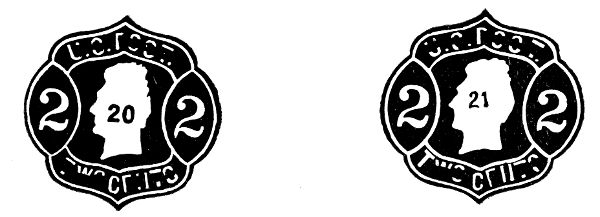
VARIETY 20. (25-1/2 × 25-1/2 mm.)
Sharp point at base of right "2." Amber and Light Manila.
"POST" 8 mm. "U" wide and near left oval. "P" nearly vertical and to left of point. Top of "O" almost touches outer frame line. Base of "S" and "T" close to inner frame line. "T" of "TWO" far from left oval. "WO" very close. "OC" close. "CENTS" close and "S" far from right oval. Nose far from left oval. "T" line touches "O" to right.
VARIETY 21. (26 × 25-1/2 mm.)
"ST" and "OC" extremely wide. Point of bust far from line. Sharply pointed nose. Amber and Light Manila.
"POST" 9 mm. "U" wide, near left oval, and sharply slanting to left. "U.S." and "SP" very wide. "P" to left of point and slanting a little to the right. "PO" very wide. "O" far to right of point and turned to right. "OS" wide. "T" near right oval, "T" of "TWO" close to left oval. "TW" very wide at base. "WO" close. "C" low and nearly under the point. "ENTS" near and "S" close to right oval. Nose pointed and far from left oval. Figures well centered. "U" line passes from tip of "E" to base of "N."
CLASS IV.
Bust points to left line of "O."

VARIETY 22. (25-1/2 × 26 mm.)
Narrow "U," the only one in DIE D. Buff.
Extremely rare. "POST" 7-1/2 mm. "U" nearly vertical and far from left oval. "P" small near the point and at top far from outer frame line. "O" far to right of point. "POST" equally spaced. "T" far from right oval. "T" of "TWO" near left oval. "WO" close. "OC" wide, "C" slants sharply to right and at base is within the angle,[Pg 77] formed by the outer curves. "CENTS" are on the same level. "S" near right oval. The inner curves are far from top of letters "WO" and "CENTS." Nose near left oval. In both side ovals the downstroke of figure "2" ends in a sharp point. "U" line touches "O" to left. Buff envelope only. Knife 2.
VARIETY 23. (26 × 25 mm.)
Extremely wide space before "U" and after "T" in upper label. Bust pointed. Amber and Light Manila.
"POST" 7-1/2 mm. "U" wide. The inner curves of the label are close to the inscription. "P" nearly vertical. "POS" close. "ST" near. "T" of "TWO" close to left oval. "WO" near. "OC" near but "C" slants from left to right and its base touches the outer frame line. Top of vertical stroke of "E" close to inner point. "EN" well spaced at top. "S" slants to right and is close to right oval. Nose very far from right oval. Figure 2 in left oval is lower than figure "2" in right oval. "W" line passes through middle of "U."
VARIETY 24. (26 × 26 mm.)
"O" above level of "P," "C" sharply turned to left. Buff Orange and Light Manila.
"POST" 7-1/2 mm. "U" wide, inclined to left and near left oval. "U.S." near. "SP" near. "P" slanting to left and near the point. "POST" about equally spaced but "OST" high nearly touching outer frame line at top. "T" far from right oval. "T" of "TWO" far from left oval. "WO" near. "OC" near. "EC" close at top. "ENT" well spaced. "S" near right oval. Nose close to left oval. Figures in oval well centered. "C" line passes between "O" of "TWO" and "C" of "CENTS."
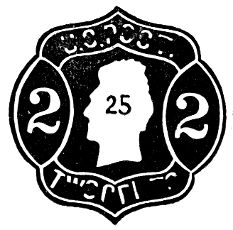
VARIETY 25. (25-1/2 × 26 mm.)
"P" tipped sharply to left and "O" to right. Buff and Orange.
"POST" 8 mm. "U" wide and far from left oval. Base of "U", close to inner frame line, but top of "S" close to outer frame line. "U S P" near. "P" far to left and "O" in line with point. "POS" near. "T" far from "S" and far from right oval. "T" of "TWO" near left oval. "WO" close. "OC" close. "CE" on level but "E" slanting to right. "TS" close. "S" near right oval. Nose some distance from left oval. Figures in ovals well centered. Envelopes only.
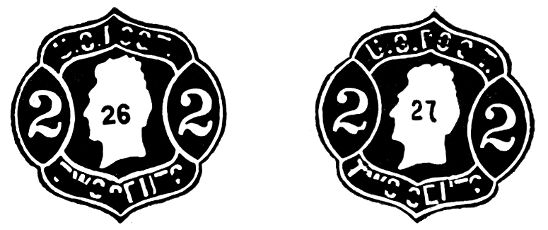
VARIETY 26. (26 × 26 mm.)
"P" nearly on a level with "O." "POST" close. "OC" near. Amber and Light Manila.
"POST" 8 mm. "U" wide slanting to left, and far from left oval. "US." wide. "SP" wide. "P" to left of point and nearly vertical. "T" very far from right oval. "T" of "TWO" near left oval. "WO" close. "OC" near. "C" vertical. "CE" close. "EN" near. "NTS" close. "S" far from right oval. Nose near oval. Figures well centered in ovals. "T" line passes close to junction point of inner frame lines, and touches "C" to left.
VARIETY 27. (26-1/2 × 25-1/2 mm.)
Sharp point of bust high above left of "O." Amber and Light Manila.
"POST" 9-3/4 mm. "U" wide slanting considerably to left and near left oval. The entire inscription in upper label is widely spaced, but "OS" widest. "T" slants sharply to right, nearly touches outer frame line and is far from right oval. "T" of "TWO" close to left oval. "WO" near. "OC" wide. The junction point of the inner frame lines is over the center of "C", which is low. "EN" well spaced and close to inner frame line. "S" nearly horizontal and close to right oval. Nose near left oval. Downstroke of right figure "2" near inner oval line. "T" line passes through first stroke of "W" of "TWO."
VARIETY 27a. (26-1/4 × 25-1/2 mm.)
"POST" 9-3/4 mm. Same as last variety, but appearing to be different. This is due to great deterioration of the die. It is found on a wrapper only and is rather scarce.

CLASS V.
Bust points to middle of "O".
VARIETY 28. (26 × 26 mm.)
"ST" close. Wide space after "S" of "CENTS". Buff and Orange.
"Post" 7-1/2 mm. "U" wide, nearly vertical and near the left oval. "U.S." near. "PO" near, but "O" slightly above "P". There is a wide space between "OS". "T" near right oval. "T" of "TWO" far from left oval. "WO" very close. "OC near". "CE" close and top of "E" under the point. "EN" wide, especially at top: "N" slightly above "E". "NTS" close. Nose near left oval. Figures well centered in ovals. "U" line cuts top of "O" of "TWO" at right. Envelopes only.
VARIETY 29. (25 × 25-3/4 mm.)
Space before "U" and after "T" extremely wide. Light Manila.
"POST" 7-1/2 mm. "U" wide. "U.S." near and both letters close to inner frame line. "P" well to left of point and on a level with "O." "O" close to point. "POS" near, but "T" further from "S". "T" of "TWO" close to left oval. "WO" near. "OC" near and "C" under the point. "E" quite a distance to right of point. "EN" wide. "NTS" near right oval. Nose far from left oval. Figures well centered in ovals. "U" line passes through middle of "C" of "CENTS". Point of bust very broad. Wrappers only.
VARIETY 30. (26 × 25-1/2 mm.)
Nose far from oval line. Amber and Light Manila.
"POST" 7-1/2 mm. "U" wide, nearly vertical and near left oval "U.S." wide. "SP" widely spaced. "PO" close and nearly on a level, "OST" near. "T" far from right oval. "T" of "TWO" far from left oval. "WO" near, but "OC" wide. "CE" on level and close at top. "EN" well spaced. "TS" wide at base. "S" far from right oval. Nose far from left oval. Figures well centered in ovals. "E" line touches "S" of "U.S." at the right.
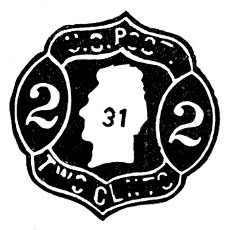
VARIETY 31. (25-3/4 × 25-3/4 mm.)
"P" considerably above "O". Point of bust square and nearly touches line. Buff and Orange.
"Post" 7-1/2 mm. "U" wide, inclined to left, and near left oval. "S" close to inner frame line. Top of "P" close to outer frame line.[Pg 80] "POST" near. "T" far from right oval. "T" of "TWO" near left oval and base of "T" some distance from outer frame line. "WO" near. "OC" very wide. "C" low. Back stroke of "E" almost touches the point. "EN" wide and "N" high. "NT" wide at top. "TS" close. "S" near right oval. Nose near left oval. Figures well centered in ovals. "T" line passes through center of "U" of "U. S."
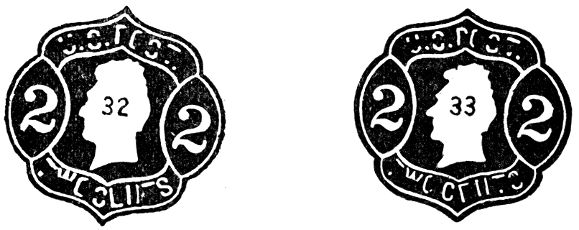
VARIETY 32. (26 × 26-1/4 mm.)
Bust ends in a sharp point, which nearly touches line over centre of "O" of "TWO". Orange and light manila.
"POST" 7-1/4 mm. "U" rather short, inclined to left and near left oval. "SP" wide at top. "P" near point and above level of "O". "PO" near but "O" slanting to right. "OS" well spaced, but "S" low. "ST" wide. "T" far from left oval. "WO" close. "C" of "CENTS" almost touches outer frame line and "CE" close at base. "ENTS" close and "S" near right oval. Nose near left oval. Figures well centered in ovals. "U" line passes slantingly from top of "E" to base.
VARIETY 33. (25-3/4 × 25-3/4 mm.)
Projecting hair. Wide space after "S" of "CENTS." Buff, Orange and Light Manila.
"POST" 8 mm. "U" wide, close to inner frame line and near left oval. Base of "S" some distance from inner frame line. "P" leans to the left. "PO" close but "O" slants to the right and is near the point. "OS" well spaced but "ST" spaced wider. "T" far from right oval. "T" of "TWO" far from left oval. "WO" near. "OC" wide. "C" some distance to right of point but on level with "E." The backstroke of the latter nearly touches the point. "EN" wide, and "ENTS" close to inner frame line. Nose far from left oval. Figures well centered in ovals. "P" line passes through back stroke of "E."
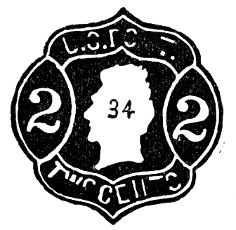
VARIETY 34. (25-3/4 × 27 mm.)
"S" of "U.S" touches line above. "OC" near. Buff envelope and wrapper.
"POST" 8 mm. "U" wide, inclined to left and near left oval. "SP" near, "P" far to left of point. "PO" well spaced at top and "O" a little raised. "OS" widely spaced. "ST" low, so that top stroke of "T" is somewhat above top of "S." "T" far from right oval. "T" of "TWO" near left oval. "WO" near. "C" slants to left, and "E" to right, so that there is a considerable space between the letters at base. "ENT" wide. "TS" close. "S" far from right oval. Figure in right oval near inner frame line, but in left oval well centered. "U" line passes between "CE."

VARIETY 35. (25 × 25-3/4 mm.)
"O" of "POST" slants sharply to left. Hair far from frame line. Buff, Orange and Light Manila.
"POST" 8 mm. "U" almost vertical and quite near to left oval. "U.S." near. "P" inclined to left. "O" near point. "OST" close. "T" near right oval. "T" of "TWO" far from left oval. "WO" near. "OC" near. "CE" wide at base. "N" higher than "E" or "T." "S" slants sharply to right and is far from right oval. Nose far from left oval. Figures well centered in oval. "T" line slants through "C" from right to left. Bust ends in a rather short point.
VARIETY 36. (26 × 26 mm.)
"P" tipped to left. "O" nearly touches outer frame line. Point of bust short and over centre of "O." Amber and Light Manila.
"POST" 8 mm. "U" large, inclined to left and near left oval. "U. S." near and base of "S" some distance from inner frame line. "P" near point and slanting to left. "PO" wide, "O" nearly vertical. "OST" wide. "T" far from right oval. "T" of "TWO" far from left oval. "WO" close. "OC" near. "C" is low and slants sharply to left. "CE" close at top. "ENTS" close. "T" almost touches line above. "S" near right oval. Nose near left oval. Figures in ovals well centered. "U" line touches ends of upper and lower stroke of "E."
VARIETY 37. (26-1/2 × 26 mm.)
"P" nearly touches line at top. "POST" near. Orange and Amber.
"POST" 8 mm. "U" wide, inclined to left and near left oval. "US" wide. "P" nearly vertical and some distance to left of point. "PO" on a level. "T" "of "POST" very far from right oval. "T" of "TWO" near left oval. "WO" close. "OC" near. "C" nearly under the point and vertical. "EN" well spaced at top. "NTS" close, especially the last two letters, "S" near right oval. Nose far[Pg 82] from left oval. Figures in ovals well centered. "T" line slants across top of "E." Envelopes only. A common die.

VARIETY 38. (26 × 26 mm.)
Bust point behind "O." "NT" wide. Orange, Amber, Light Manila.
"POST" 8 mm. "U" wide, greatly inclined to left, and quite near left oval. "US" very wide. "P" near point and slanting to left. "O" some distance to right of point and inclined to right. "POS" wide but "ST" widest. Top stroke of "T" close to outer frame line. "T" of "TWO" near left oval. "WO" near. "OC" very wide. "C" almost vertical and close to point. Top of "E" slightly above "C." "EN" near. "TS" wide at base and "S" close to right oval. Nose far from left oval. Figures in ovals well centered. "U" line touches base of "T" of "CENTS."
VARIETY 39. (26-1/4 × 25-1/2 mm.)
"P" considerably above level of "O." "POST" wide. Amber, and Light Manila.
"POST" 9 mm. "U" wide, inclined to left, and near left oval. "US" wide. "SP" wide. "P" slants to left and is close to the point. "PO" very wide. "O" far to right of point and but little slanting. "OST" wide. "T" near right oval. "T" of "TWO" close to left oval, "WO" close. The entire word is well above the outer frame line. "OC" very wide. "C" under the point and upright. Top of "E" slightly above "C." "NT" close. "TS" wide. "S" close to right oval. Nose near left oval. Figures in ovals well centered. "W" line touches base of "U" at right. Broad point to bust. Envelope and wrapper.
VARIETY 40. (26 × 26 mm.)
"NT" very near. "POST" wide. Buff, Orange, Amber, Light Manila.
"POST" 9-1/2 mm. Inscription in upper label much resembles that of the preceding variety, but "S" of "U.S." is low and "PO" nearer. "T" of "TWO" near left oval. "WO" close. "OC" wide. "TS" close at top. Nose far from left oval. Figures in ovals well centered. "U" line passes along middle stroke of "N." One of the most common varieties.
ENVELOPES.
TWO CENTS, BLACK.
1863.
Inscribed: "U. S. POSTAGE."
DIE A.
| Var. 3. | ||||||
|---|---|---|---|---|---|---|
| No. | Class. | Paper. | Knife. | Size. | Dimensions. | Remarks. |
| 370 | 4 | Buff | 2 | 3 | 139 × 83 | Gummed. |
| 371 | " | " | 2 | 3 | " | Ungummed. |
| Var. 5. | ||||||
| 372 | 4 | Buff | 2 | 3 | 139 × 83 | Ungummed. |
| 373 | " | " | 2 | 3 | " | Gummed. |
| Var. 6. | ||||||
| 374 | 4 | Amber | 2 | 3 | 139 × 83 | Gummed. |
| 375 | " | Buff | 2 | 3 | " | Ungummed. |
DIE B.
| Var. 8. | ||||||
|---|---|---|---|---|---|---|
| No. | Class. | Paper. | Knife. | Size. | Dimensions. | Remarks. |
| 376 | 4 | Buff | 11 | 3 | 139 × 83 | Ungummed. |
| 377 | " | Orange | 11 | 3 | " | " |
1864.
Inscribed: "U. S. POST."
DIE C.
| Var. 1. | ||||||
|---|---|---|---|---|---|---|
| No. | Class. | Paper. | Knife. | Size. | Dimensions. | Remarks. |
| 378 | 2 | Buff | 11 | 3 | 139 × 83 | Ungummed. |
| 379 | " | " | 11 | 3 | " | Gummed. |
| 380 | " | Or. | 11 | 3 | " | Ungummed. |
| Var. 3. | ||||||
| 381 | 3 | Buff | 11 | 3 | 139 × 83 | Gummed |
| 382 | " | Or. | 11 | 3 | " | Ungummed |
| Var. 5. | ||||||
| 383 | 3 | Buff | 11 | 3 | 139 × 83 | Gummed |
| 384 | " | Or. | 11 | 3 | " | Ungummed |
| Var. 6. | ||||||
| 385 | 3 | Buff | 11 | 3 | 139 × 83 | Gummed[Pg 84] |
| Var. 6a. | ||||||
| 386 | 3 | Buff | 11 | 3 | 139 × 83 | Gummed |
| 387 | " | Or. | 11 | 3 | " | Ungummed |
| Var. 7. | ||||||
| 388 | 3 | Buff | 11 | 3 | 139 × 83 | Gummed |
| 389 | " | Or. | 11 | 3 | " | Ungummed |
| Var. 8. | ||||||
| 390 | 3 | Buff | 11 | 3 | 139 × 83 | Gummed |
| 391 | " | Or. | 11 | 3 | " | Ungummed |
| Var. 9. | ||||||
| 392 | 3 | Buff | 11 | 3 | 139 × 83 | Gummed |
| 393 | " | Or. | 11 | 3 | " | Ungummed |
| Var. 10. | ||||||
| 394 | 4 | Buff | 11 | 3 | 139 × 83 | Gummed. |
| Var. 11. | ||||||
| 395 | 4 | Buff | 11 | 3 | 139 × 83 | Gummed. |
| 395a | " | " | 12 | 5 | 160 × 90 | " |
| 396 | " | Or. | 11 | 3 | 139 × 83 | Ungummed. |
| Var. 12. | ||||||
| 397 | 4 | Buff | 11 | 3 | 139 × 83 | Gummed. Generally "Specimen." |
| 398 | " | Or. | 11 | 3 | " | Ungummed. Generally "Specimen." |
| 399 | " | Buff | 12 | 5 | 160 × 90 | " Generally "Specimen." |
| Var. 13. | ||||||
| 400 | 4 | Buff | 11 | 3 | 139 × 83 | Gummed. |
| 401 | " | Or. | 11 | 3 | " | Ungummed. |
| Var. 14. | ||||||
| 402 | 5 | Buff | 11 | 3 | 139 × 83 | Gummed. |
| 403 | " | Or. | 11 | 3 | " | Ungummed. |
| Var. 15. | ||||||
| 404 | 5 | Buff | 11 | 3 | 139 × 83 | Gummed. |
| 405 | " | Or. | 11 | 3 | " | Ungummed. |
| 406 | " | Buff | 12 | 5 | 160 × 90 | " |
| Var. 16. | ||||||
| 407 | 5 | Buff | 11 | 3 | 139 × 83 | Gummed. |
| 408 | " | Or. | 11 | 3 | " | Ungummed. |
| 409 | " | Buff | 12 | 5 | 160 × 90 | "[Pg 85] |
DIE D.
| Var. 17. | ||||||
|---|---|---|---|---|---|---|
| No. | Class. | Paper. | Knife. | Size. | Dimensions. | Remarks. |
| 410 | 3 | Buff | 11 | 3 | 139 × 83 | Gummed |
| 411 | " | Or. | 11 | 3 | " | Ungummed |
| 412 | " | Buff | 12 | 5 | 160 × 90 | " |
| Var. 18. | ||||||
| 413 | 3 | Buff | 11 | 3 | 139 × 83 | Gummed. |
| 414 | " | Or. | 11 | 3 | " | Ungummed. |
| 415 | " | Buff | 12 | 5 | 160 × 90 | " |
| 415a | " | " | 12 | 5 | " | Gummed. |
| Var. 19. | ||||||
| 416 | 3 | Amber | 12 | 5 | 160 × 60 | Gummed |
| 417 | " | " | 12 | 5 | " | [HW: Gummed] |
| Var. 20. | ||||||
| 418 | 3 | Amber | 12 | 5 | 160 × 90 | Ungummed |
| Var. 21. | ||||||
| 419 | 3 | Amber | 11 | 3 | 139 × 83 | Gummed |
| 420 | " | " | 12 | 5 | 160 × 90 | Ungummed |
| Var. 22. | ||||||
| 421 | 4 | Buff | 2 | 3 | 139 × 83 | Ungummed. Very rare. |
| Var. 23. | ||||||
| 422 | 4 | Amber | 12 | 5 | 160 × 90 | Ungummed. |
| Var. 24. | ||||||
| 423 | 4 | Buff | 11 | 3 | 139 × 83 | Gummed. |
| 424 | " | Or. | 11 | 3 | " | Ungummed. |
| Var. 25. | ||||||
| 425 | 4 | Buff | 11 | 3 | 139 × 83 | Gummed. |
| 426 | " | Or. | 11 | 3 | " | Ungummed. |
| Var. 26. | ||||||
| 427 | 4 | Amber | 11 | 3 | 139 × 83 | Gummed. |
| Var. 27. | ||||||
| 428 | 4 | Amber | 12 | 5 | 160 × 90 | Ungummed. |
| Var. 27a. | ||||||
| [Pg 86]429 | 4 | Amber | 12 | 5 | 160 × 90 | Ungummed. |
| Var. 28. | ||||||
| 430 | 5 | Buff | 11 | 3 | 139 × 83 | Gummed. |
| 431 | " | Or. | 11 | 3 | " | Ungummed. |
| Var. 30. | ||||||
| 432 | 5 | Amber | 12 | 5 | 160 × 90 | Ungummed. |
| Var. 31. | ||||||
| 433 | 5 | Buff | 11 | 3 | 139 × 83 | Gummed. |
| 434 | " | Or. | 11 | 3 | " | Ungummed. |
| 434a | " | Buff | 12 | 5 | 160 × 90 | " |
| Var. 32. | ||||||
| 435 | 5 | Or. | 11 | 3 | 139 × 83 | Gummed. |
| Var. 33. | ||||||
| 436 | 5 | Buff | 11 | 3 | 139 × 83 | Gummed. |
| 437 | " | Or. | 11 | 3 | " | Ungummed. |
| 438 | " | Buff | 12 | 5 | 160 × 90 | Gummed. |
| Var. 34. | ||||||
| 439 | 5 | Buff | 11 | 3 | 139 × 83 | Gummed. |
| Var. 35. | ||||||
| 440 | 5 | Buff | 11 | 3 | 139 × 83 | Gummed. |
| 441 | " | Or. | 11 | 3 | " | Ungummed. |
| Var. 36. | ||||||
| 442 | 5 | Amber | 12 | 5 | 160 × 90 | Ungummed. |
| Var. 37. | ||||||
| 443 | 5 | Amber | 11 | 3 | 139 × 83 | Gummed. |
| 444 | " | Or. | 11 | 3 | " | Ungummed. |
| Var. 38. | ||||||
| 445 | 5 | Or. | 11 | 3 | 139 × 83 | Ungummed. |
| Var. 39. | ||||||
| 446 | 5 | Amber | 11 | 3 | 139 × 83 | Gummed. |
| 447 | " | " | 12 | 5 | 160 × 90 | Ungummed. |
| Var. 40. | ||||||
| 448 | 5 | Buff | 11 | 3 | 139 × 83 | Gummed. |
| 449 | " | Amber | 11 | 3 | " | " |
| 450 | " | Or. | 11 | 3 | " | Ungummed. |
Wrappers.
1863.
Inscribed: "U. S. POSTAGE."
DIE A.
| Var. 1. | |||||
|---|---|---|---|---|---|
| No. | Class. | Paper. | Dimensions. | Laid. | Remarks. |
| 451 | 1 | D. M. | 227 × 148 | ||
| Var. 2. | |||||
| 452 | 2 | D. M. | 227 × 148 | ||
| Var. 4. | |||||
| 453 | 4 | D. M. | 227 × 148 | ||
| Var. 6. | |||||
| 454 | 4 | D. M. | 227 × 148 | ||
| Var. 7. | |||||
| 455 | 4 | D. M. | 227 × 148 | ||
1864.
Inscribed: "U. S. POST."
DIE C.
| Var. 2. | |||||
|---|---|---|---|---|---|
| No. | Class. | Paper. | Dimensions. | Laid. | Remarks. |
| 456 | 3 | D. M. | 100 × 200 | V | |
| Var. 4. | |||||
| 457 | 3 | D. M. | 100 × 200 | V | |
| Var. 6. | |||||
| 458 | 3 | Buff | 100 × 200 | V | |
| 459 | " | D. M. | " | V | |
| Var. 6a. | |||||
| 460 | 3 | Buff | 100 × 200 | H | |
| 461 | " | D. M. | " | V | |
| Var. 7. | |||||
| 462 | 3 | D. M. | 100 × 200 | V | |
| Var. 8. | |||||
| 463 | 3 | D. M. | 100 × 200 | V | [Pg 88] |
| Var. 10. | |||||
| 464 | 4 | D. M. | 100 × 200 | V | |
| Var. 12. | |||||
| 465 | 4 | D. M. | 100 × 200 | V | |
| Var. 13. | |||||
| 466 | 4 | D. M. | 100 × 200 | V | |
| Var. 14. | |||||
| 467 | 5 | D. M. | 100 × 200 | V | |
| Var. 15. | |||||
| 468 | 5 | Buff | 100 × 200 | V | |
| 469 | " | D. M. | " | V | |
| Var. 16. | |||||
| 470 | 5 | Buff | 100 × 200 | V | |
DIE D.
| Var. 17. | |||||
|---|---|---|---|---|---|
| No. | Class. | Paper. | Dimensions. | Laid. | Remarks. |
| 471 | 3 | Buff | 100 × 200 | V | |
| Var. 19. | |||||
| 472 | 3 | L. M. | 133 × 200 | V | |
| Var. 20. | |||||
| 473 | 3 | L. M. | 100 × 200 | V | |
| 474 | " | " | 133 × 200 | — | |
| Var. 21. | |||||
| 475 | 3 | L. M. | 133 × 200 | H | |
| 476 | " | " | 115 × 375 | H | Stamp 137 mm. from top. |
| Var. 23. | |||||
| 477 | 4 | L. M. | 133 × 200 | H | |
| 478 | " | " | " | V | |
| 479 | " | " | " | Wove | |
| Var. 24. | |||||
| 480 | 4 | L. M. | 100 × 200 | V | |
| 480a | " | Buff | " | V | |
| Var. 25. | |||||
| 481 | 4 | Buff | 100 × 200 | V | [Pg 89] |
| Var. 26. | |||||
| 482 | 4 | L. M. | 133 × 200 | H | |
| Var. 27. | |||||
| 483 | 4 | L. M. | 133 × 200 | H | |
| Var. 27a. | |||||
| 484 | 4 | L. M. | 133 × 200 | V | |
| Var. 29. | |||||
| 485 | 5 | L. M. | 133 × 200 | H | |
| Var. 30. | |||||
| 486 | 5 | L. M. | 133 × 200 | H | |
| Var. 31. | |||||
| 487 | 5 | Buff | 100 × 200 | V | |
| Var. 32. | |||||
| 488 | 5 | L. M. | 100 × 200 | V | |
| Var. 33. | |||||
| 489 | 5 | L. M. | 100 × 200 | V | |
| 490 | " | Buff | " | V | |
| Var. 34. | |||||
| 491 | 5 | L. M. | 100 × 200 | V | |
| 492 | " | Buff | " | V | |
| 493 | " | " | 150 × 212 | V | |
| 494 | " | " | " | H | |
| Var. 35. | |||||
| 495 | 5 | L. M. | 100 × 200 | V | |
| 496 | " | Buff | " | V | |
| Var. 36. | |||||
| 497 | 5 | L. M. | 133 × 200 | V | |
| Var. 38. | |||||
| 498 | 5 | L. M. | 133 × 200 | H | |
| Var. 39. | |||||
| 499 | 5 | L. M. | 133 × 200 | H | |
| Var. 40. | |||||
| 499a | 5 | L. M. | 133 × 200 | H | |
THREE CENTS, ROSE; THREE CENTS, BROWN; SIX CENTS, ROSE AND SIX CENTS, PURPLE.
In the Postmaster-General's report for 1864 it is stated that "during the last session of Congress a bill was passed for the relief of the contractor for furnishing the department with stamped envelopes and newspaper wrappers, under the provisions of which the existing contract expired on Sept. 11, 1864."
With the renewal of the former contract Nesbitt changed the dies of the two, three and six cents. The first we have already exhaustively treated. It is, of course, the two cents, black, "U. S. POST". All these dies remained in use until June 30th, 1870.
As a matter of history it may be noted here that the three cents printed in brown, likewise the six cents rose, both on official size, were issued in July, 1865. The dies have a portrait of Washington facing to the left in a plain oval. It is enclosed in a frame of colorless lines. Inscription above "UNITED STATES"; below, "THREE CENTS" or "SIX CENTS", in block capitals. Large numerals of value at each side.
None of the Nesbitt die varieties have given the writer so many anxious hours and have required such prolonged study as the three cents of 1864. Indeed, the final solution of the problem of classification of the various dies was only arrived at after more than two years continuous research. Like the famous balancing of the egg of Columbus, the problem, when solved, is extremely simple. Looking backward on the long series of failures, it seems strange that the chief characteristics have so long escaped the attention of cataloguers. The fact, however, is patent. Even as thorough and painstaking a student as the late Gilbert Harrison who, in 1895, chronicled, as he thought, all of the existing die varieties of the three cents has failed to observe the most important differences. Indeed, in the entire philatelic literature dealing with the Nesbitt dies of 1864 there is but one allusion to the feature which constitutes the surest means for the identification of the die varieties, and this is only a single sentence contained in the Historical Notes of Messrs. Tiffany, Bogert and Rechert. It reads:—
"It is worth mentioning, however, that while dies 9, 15 and 26 (the latter the die under consideration) all have the small bust of Washington, there are small differences in each which show them to be different engravings. * * In die 26 the front hair shows only five locks and the back hair only four lines."
We shall presently see that, like the three cents, red of 1853, (Die A) the diemakers have produced different groups of heads which, once known, are not only an absolute means of differentiating the varieties, but also protect the collector from acquiring a multitude of the same die.
Although, as stated above, the die of the three cents rose equals that of the three cents red in the use of various heads, it is, otherwise, quite dissimilar to the first issue, as will be seen presently.
As in the varieties of the two cent dies the horizontal and vertical dimensions of the three cents vary greatly. After careful research and taking the advice of experienced philatelists, it was decided to adopt only two sizes for classification: i.e.
Size A:—to include all stamps measuring horizontally 24 mm. but not exceeding 25 mm.
Size B:—to include all stamps measuring horizontally 25-1/2 mm. or more.
In our study of the three cents red of 1853 we noted, in addition to the various heads, some minor differences in the spacing of the letters forming the inscription. Referring now to the three cents of 1864, even the unskilled eye of the layman will be struck with the surprising changes, not only in the spacing of the letters forming a word, but, also, in the relative position of the words to each other and their distance from a definite point, such, for instance, as the figure "3." The subsequent cuts well illustrate this point.
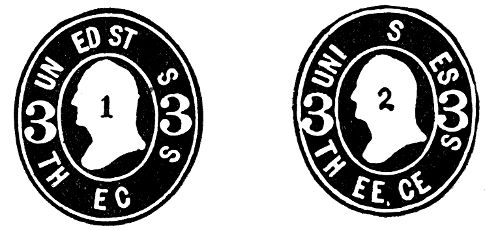
In the first the "S" of "CENTS" is several mm. distant from the right figure "3": in the second it is close to "3". The same remarks apply to the "U" of "UNITED" in its relative position to the left figure "3". In the second cut there is also a square period after the final "E" of "THREE".
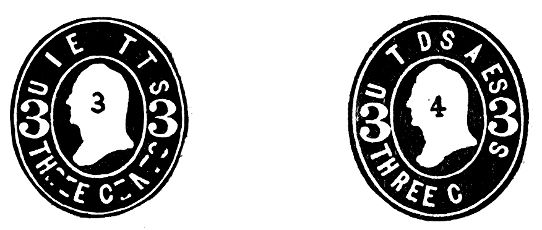
Looking at cuts 3 and 4 the great variety of spacing between the letters of a word is strikingly apparent in the word "THREE." These differences are easily detected by the 10 mm. unit distance measurement, which has been explained in the introductory chapter of this series of articles. The subjoined diagram proves that there are at least three forms of each word, and, with a little study, the collector will soon recognize the leading types.
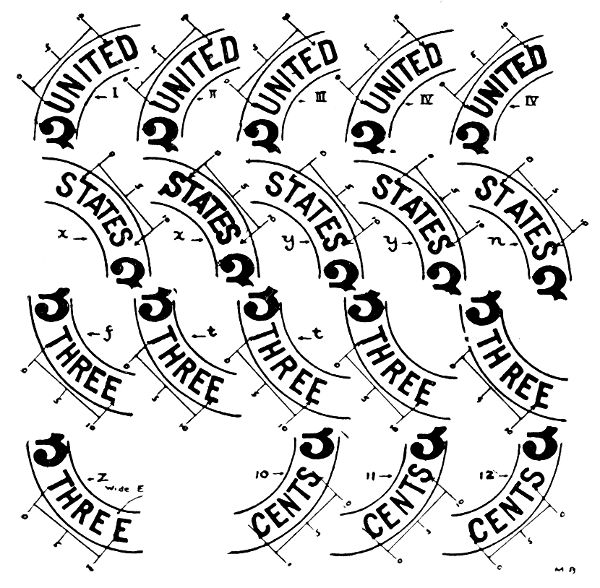
It seems strange that such great and palpable differences remained unknown until 1892. Quoting from the work of Messrs. Tiffany, Bogert & Rechert, we are, however, informed: "Heretofore it has not been noticed that there are a large number of minor varieties of this die depending on the relative position of the parts."
Commenting on Die 26 (three cents rose) the writers make some valuable suggestions, but they discourage the would-be student from going deeper into the subject by the closing paragraph: "So few collectors would be interested in looking for these varieties that it has been thought unnecessary to devote space to them in a general work." In the writer's opinion the most valuable hint thrown out by Messrs. Tiffany, Bogert & Rechert is contained in the following sentence: "If a thread be laid along the lower stroke of the "U" it will pass at different distances from the tip of the nose and fall on different parts of the right numeral, of the space below it, or even as low as the "S" of "CENTS."
Why these experts stopped at the gate and did not enter is one of those freaks of the human mind that defies explanation. Certainly the person who made this observation was on the very threshold of discovering a scientific classification of this elusive die. The writer confesses that, after having independently evolved this system of classification, nothing has given him greater satisfaction than to find that the basic idea had been chronicled as far back as 1892. To-day it is well known that a line prolongation along the "U" of "UNITED" establishes five distinct classes. As this system has been fully described in a lecture given by the writer before the Boston Philatelic Society, (April 19, 1904) which lecture has also been published in pamphlet form, and, as this classification has been accepted by the writer of the latest Scott Catalo gue, it seems unnecessary to go into the details, especially as the subjoined diagram is self-explanatory.
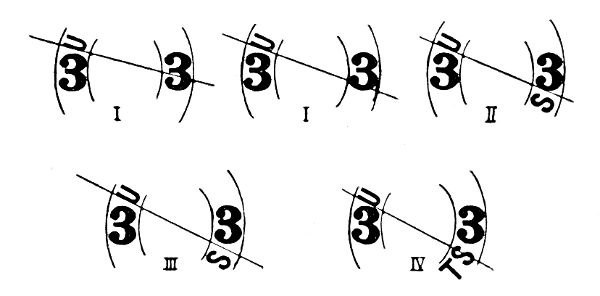
It is evident that we now possess various means for the classification of the three cents die varieties, but a system based solely on a line measurement, as has been stated heretofore, would not guard the collector sufficiently from acquiring a number of the same dies, due to unavoidable mistakes of measurement. To prevent duplication of dies it is imperative to know the various heads.
Luckily the distinctive features are quite plain and it is easy to divide the heads into five classes for, as in the first issue, the die cutters have adorned the head of Washington with a variety of coiffures.
In Heads 1 and 2 there is a triangular open space between the middle bunch of hair and the lowest strand which meets the queue.
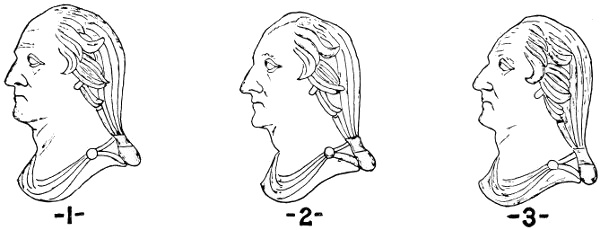
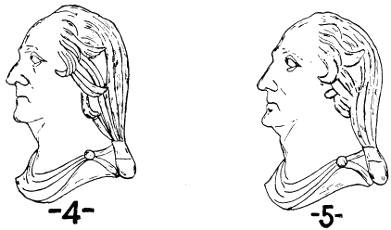
HEAD 1.—The queue consists of three vertical strands extending from the top of the head to the neck. Next to the queue are 3 rear locks, of which the middle one is a large, pear-shaped[Pg 94] bunch, consisting of five fine strands, while the second highest is by far the longest, and cuts into the queue, resembling the stem of a pear.
HEAD 2.—Same as Head 1, but the second lowest strand of hair in the pear-shaped bunch is the longest and does not extend into the queue. The triangular space below is slightly larger than in Head 1.
HEAD 3.—The queue consists of either three or four strands which extend from the top of the head to the neck. Next to the queue there are five locks in the rear row, the arrangement of which differs in the various specimens. The main feature of Head 3 consists in the absence of an open space between the middle bunch and the lowest lock.
HEAD 4.—The queue consists of three strands which extend from the top of the head to the neck. The back row of hair consists of five locks of which the lowest is very small and runs almost perpendicularly into the queue. There is a small space between the perpendicular lock and the next lowest.
HEAD 5.—Generally found on the second quality of buff paper. The queue consists of three strands, which extend from the top of the head to the neck. The main feature is the middle bunch of hair, which is oblong shaped and consists of three heavy strands, all of which slant diagonally into the queue. Immediately below this bunch is the lowest small lock, which also slants diagonally into the queue.
Of the five heads, the first is certainly the one which is most commonly found; especially on amber paper. Knife 1 is always Head 4. Head 3 is less common, and Head 5 is most frequently found on the second quality buff paper. It is also useful to remember that Head 5 appears on Knife 11.
The subsequent table gives the knives and heads of the three cents, Rose:—
| K. | 22 | 120 × 73 | P. O. Size | 1 | Heads | 1, 2, 3, 4 | White |
| " | 1 | 120 × 73 | " | 1 | " | 4 | White |
| " | 2 | 139 × 83 | " | 3 | " | 3 | White |
| " | 11 | 139 × 83 | " | 3 | " | 1, 2, 3, 4, 5 | White |
| " | 11 | 139 × 83 | " | 3 | " | 1, 2, 3, 4, 5 | Buff |
| " | 11 | 139 × 83 | " | 3 | " | 1, 2 | Amber |
| " | 11 | 139 × 83 | " | 3 | " | 1, 5 | Buff 2nd |
| " | 9 | 139 × 83 | " | 3 | " | 1, 2, 3, 4 | White |
| " | 9 | 139 × 83 | " | 3 | " | 1, 3, 4 | Buff |
| " | 9 | 139 × 83 | " | 3 | " | 1, 2 | Amber |
| " | 12 | 160 × 90 | " | 5 | " | 1, 2, 3, 4 | White |
| " | 12 | 160 × 90 | " | 5 | " | 1, 3, 4 | Buff |
| " | 12 | 160 × 90 | " | 5 | " | 1, 2 | Amber |
A similar table for the three cents, Brown shows that the following heads exist:—
| K. | 21 | 225 × 98 | Size | 7 | Heads | 1, 2, 3, 4 | White |
| " | " | " | " | " | " | 1, 2, 3, 4 | Buff |
| " | " | " | " | " | " | 1, 2 | Amber |
The six cents, Rose and Purple comes only on heads 1 and 3.
A systematic and rational classification of the three cents (both rose and brown) and their congener the six cents (purple and rose) is now ready. The collector of entire envelopes will proceed as follows:—
Given a certain specimen, he first ascertains the knife, second the color of the paper. He then decides which head is represented, and finally ascertains whether it is an "A" or "B" die. The specialist, or any collector who is sufficiently interested to possess the various sub-varieties, goes a step further. Having determined the head, he finds to which of the four classes of line measurement a given specimen belongs. Thus the apparently bewildering number of varieties, through the knowledge of the heads and the "U" line measurement, are brought into perfect order, and all risk of confusion is avoided. It is evident that, henceforth, the collector of cut squares will try to obtain at least one specimen of the different heads of both die A and B, while the collector of entires may go to any length to satisfy his zeal and ambition.
The large die (Die B), measuring horizontally 25-1/2 mm. or more, is comparatively scarce and it is found most commonly on the small envelope, Knife 22.
THREE CENTS, ROSE.
| K. | 22 | Heads | 1, 2, 4 | White |
| " | 11 | " | 4 | Buff |
| " | 9 | " | 1, 4 | White |
| " | 9 | " | 1 | Buff |
| " | 12 | " | 2, 4 | White |
| " | 12 | " | 2 | Amber |
THREE CENTS, BROWN.
| K | 21 | Head | 1 | White |
| " | " | " | 1, 2 | Buff |
| " | " | " | 2 | Amber |
With the issue of the three cents, rose, the contractor, at the order of the Post Office Department, introduced a second quality of buff paper. This matter is of importance to all collectors and should be duly noted.
In a circular letter from the Finance Office, dated "Washington Oct. 1866," signed "A. N. Zevely, 3d Asst. P. M. G.", it is stated:—
"Letter size envelopes stamped 3 cents, made of a cheaper quality of paper than those hitherto furnished, are furnished by the Department at $32.80 per 1,000."
The schedule of 1867 gives the prices of three cent envelopes, etc., and of letter size second quality buff. A circular to the public of the same date says that "letter size second quality are furnished ONLY in buff."
The white and colored paper of this issue exists in various qualities, of which the extremes may be called nearly cardboard paper and almost tissue. The texture is soft and highly surfaced. An interesting[Pg 96] variety of the white paper is a decidedly brownish-white, which, as far as the writer knows, has not been mentioned heretofore. There are also various shades of buff and even a reddish toned orange paper.
Doubtless collectors would like to possess some information about the rarity of the various heads found in the three cents, rose, of this issue. From a study of some six thousand envelopes of this series the writer can give a fairly accurate estimate. Calling the total number of envelopes examined one hundred per cent, the respective percentages of the five heads were:
Head 1—50%
" 2—30%
" 3—10%
" 4—09.5%
" 5—00.5%
————
100.
In regard to the sub varieties of the various heads it is also of interest to observe that a considerable number are "repeating dies," i.e., generally a die, say of Head 1 on white paper and on Knife 11, is liable to be found on buff and amber paper not only on Knife 11, but also on Knife 9. Only very few sub varieties of a given Head exist on of this series. Although it is evident that of all Nesbitt issues the 3 cent rose 1864 has by far the largest number of die varieties, it is by no means an impossible task to classify all existing varieties as has been done with the two cent Jackson, and it is the intention of the writer to carry out this work at no distant day. Probably due to the apparent similarity of many dies collectors have been apathetic and have considered one as good as the other, but a little study speedily convinces the student of this error. Indeed, this issue contains a number of extremely rare dies, and as soon as proper information and classification is published, the 3 cent rose of 1864 will be a favorite of all true philatelists.
Before leaving these interesting dies we must not fail to mention that, on the three cents and six cents, there is often a small dot on Washington's face shaped like a mole, about one mm. under the ear. It is of little importance, and is evidently merely a flaw.
In addition to the 3 and 6 cents, Nesbitt produced, in 1864, a new design for the 9, 12, 18 and 30 cents, while the old design of the former 24 and 40 cents was changed in December 1865. The main difference between the new and the old design is that the oval band and small circular disks are with colored background bordered by colorless lines. The inscriptions and numerals are now colorless. The branches have eight leaves.
Of these values no die varieties are known; but, excepting the 40 cents pink, there are several distinct shades of each stamp.
Commencing with the Nine Cents, we have a decided lemon-yellow and an orange; the Twelve Cents appears in dark brown and red-brown; the Twenty-four Cents in two shades of blue; the Eighteen Cents exists in red and dark red, and the Thirty Cents in yellow-green, dark green and olive-green.
This concludes the Nesbitt issues of United States envelopes. His connection with the Postal Department ceased March 31, 1870, when a new contract was awarded to George H. Reay, of New York.
To the philatelists the Nesbitt issues are by far the most interesting series of all the United States Postal issues and, as the years pass on, the intrinsic value of these die varieties will increase rapidly. Specialization is the watchword of the now growing class of collectors, and there is no field so inviting and which will repay a student so richly for his labor as a specialized collection of the Nesbitt issues. What is wanted to-day is a special album for United States envelopes, which would insure to this prominent branch of United States philately that measure of official recognition for which collectors have long and earnestly contended. An equally valuable aid would be the formation of a Society of Collectors of United States envelopes. The writer confidently expects that this suggestion will soon assume a more tangible form.
If this series of articles has, in even the slightest degree, helped collectors of United States envelopes to a wider knowledge and better appreciation of these hitherto unknown die varieties, the writer will feel well repaid for the many hours of labor. In closing, he again asserts; "Variety is the spice of life!"
1864.
THREE CENTS, ROSE.
DIE A.
| Head I. | ||||||
|---|---|---|---|---|---|---|
| No. | Paper. | Knife. | Size. | Dimensions. | Variety. | Remarks. |
| 501 | White | 22 | 1 | 120 × 73 | 1 | |
| 502 | " | 22 | 1 | " | 2 | |
| 503 | " | 22 | 1 | " | 3 | |
| 504 | " | 22 | 1 | " | 4 | |
| 505 | " | 11 | 3 | 139 × 83 | 1 | |
| 506 | " | 11 | 3 | " | 1 | Unwatermarked. |
| 507 | " | 11 | 3 | " | 2 | |
| 508 | " | 11 | 3 | " | 3 | |
| 509 | " | 11 | 3 | " | 4 | |
| 510 | " | 9 | 3 | " | 1 | |
| 511 | " | 9 | 3 | " | 2 | |
| 511a | " | 9 | 3 | " | 2 | Without Patent Lines. |
| 512 | " | 9 | 3 | " | 3 | |
| 513 | " | 9 | 3 | " | 4 | |
| 514 | " | 12 | 5 | 160 × 90 | 2 | |
| 515 | " | 12 | 5 | " | 3 | [Pg 98] |
| 516 | " | 12 | 5 | " | 4 | |
| 517 | Buff | 11 | 3 | 139 × 83 | 2 | |
| 518 | " | 11 | 3 | " | 3 | |
| 519 | " | 11 | 3 | " | 4 | |
| 520 | " | 9 | 3 | " | 1 | |
| 521 | " | 9 | 3 | " | 2 | |
| 522 | " | 9 | 3 | " | 3 | |
| 523 | " | 9 | 3 | " | 4 | |
| 524 | " | 12 | 5 | 160 × 90 | 2 | |
| 525 | " | 12 | 5 | " | 4 | |
| 526 | Buff 2nd | 11 | 3 | 139 × 83 | 3 | |
| 527 | " | 11 | 3 | " | 4 | |
| 528 | Amber | 11 | 3 | " | 1 | |
| 529 | " | 11 | 3 | " | 2 | |
| 530 | " | 11 | 3 | " | 3 | |
| 531 | " | 11 | 3 | " | 3 | Ungummed. |
| 532 | " | 11 | 3 | " | 4 | |
| 533 | " | 9 | 3 | " | 3 | |
| 534 | " | 9 | 3 | " | 4 | |
| 535 | " | 12 | 5 | 160 × 90 | 2 | |
| 536 | " | 12 | 5 | " | 3 | |
| 537 | " | 12 | 5 | " | 4 | |
| 538 | Amber 2nd | 11 | 3 | 139 × 83 | 2 | |
| 539 | " | 11 | 3 | " | 3 | |
| 540 | " | 11 | 3 | " | 4 | |
| Head II. | ||||||
| No. | Paper. | Knife. | Size. | Dimensions. | Variety. | Remarks. |
| 541 | White | 22 | 1 | 120 × 73 | 1 | |
| 542 | " | 22 | 1 | " | 2 | |
| 543 | " | 22 | 1 | " | 3 | |
| 544 | " | 11 | 3 | 139 × 83 | 1 | |
| 545 | " | 11 | 3 | " | 2 | |
| 546 | " | 11 | 3 | " | 3 | |
| 547 | " | 9 | 3 | " | 1 | |
| 548 | " | 9 | 3 | " | 2 | |
| 549 | " | 9 | 3 | " | 3 | |
| 550 | " | 12 | 5 | 160 × 90 | 1 | |
| 551 | " | 12 | 5 | " | 2 | |
| 552 | " | 12 | 5 | " | 3 | |
| 553 | Amber | 11 | 3 | 139 × 83 | 1 | |
| 554 | " | 11 | 3 | " | 2 | |
| 555 | " | 11 | 3 | " | 4 | |
| 556 | " | 9 | 3 | " | 1 | |
| 557 | " | 9 | 3 | " | 3 | |
| 558 | " | 12 | 5 | 160 × 90 | 2 | |
| 559 | " | 12 | 5 | " | 3 | |
| Head III. | ||||||
| No. | Paper. | Knife. | Size. | Dimensions. | Variety. | Remarks. |
| 560 | White | 22 | 1 | 120 × 73 | 1 | |
| 561 | " | 22 | 1 | " | 2 | [Pg 99] |
| 562 | " | 22 | 1 | " | 3 | |
| 563 | " | 2 | 3 | 139 × 83 | 3 | Ungummed. Probably a proof. |
| 564 | " | 11 | 3 | " | 1 | |
| 565 | " | 11 | 3 | " | 2 | |
| 566 | " | 11 | 3 | " | 3 | |
| 567 | " | 9 | 3 | " | 1 | |
| 568 | " | 9 | 3 | " | 2 | |
| 569 | " | 12 | 5 | 160 × 90 | 1 | |
| 570 | " | 12 | 5 | " | 2 | |
| 571 | Buff | 2 | 3 | 139 × 83 | 3 | Ungummed. Probably a proof. |
| 572 | " | 11 | 3 | " | 1 | |
| 573 | " | 11 | 3 | " | 2 | |
| 574 | " | 11 | 3 | " | 3 | |
| 575 | " | 9 | 3 | " | 1 | |
| 576 | " | 9 | 3 | " | 2 | |
| 577 | " | 9 | 3 | " | 2 | Without patent lines. |
| 578 | " | 9 | 3 | " | 3 | |
| 579 | " | 12 | 5 | " | 2 | |
| 580 | " | 12 | 5 | " | 3 | |
| Head IV. | ||||||
| No. | Paper. | Knife. | Size. | Dimensions. | Variety. | Remarks. |
| 581 | White | 22 | 1 | 120 × 73 | 1 | |
| 582 | " | 22 | 1 | " | 2 | |
| 583 | " | 22 | 1 | " | 3 | |
| 581 | " | 1 | 1 | " | 2 | |
| 585 | " | 11 | 3 | 139 × 83 | 2 | |
| 586 | " | 11 | 3 | " | 3 | |
| 587 | " | 11 | 3 | " | 3 | Unwatermarked |
| 588 | " | 9 | 3 | " | 1 | |
| 589 | " | 9 | 3 | " | 2 | |
| 590 | " | 9 | 3 | " | 3 | |
| 591 | " | 12 | 5 | 160 × 90 | 1 | |
| 592 | " | 12 | 5 | " | 2 | |
| 593 | " | 12 | 5 | " | 3 | |
| 594 | Buff | 11 | 3 | 139 × 83 | 1 | |
| 595 | " | 11 | 3 | " | 2 | |
| 596 | " | 11 | 3 | " | 3 | |
| 596a | Buff 2nd | 11 | 3 | " | 2 | |
| 597 | Buff | 9 | 3 | " | 1 | |
| 598 | " | 9 | 3 | " | 2 | |
| 599 | " | 9 | 3 | " | 3 | |
| 600 | " | 12 | 5 | 160 × 90 | 1 | |
| 601 | " | 12 | 5 | " | 2 | |
| Head V. | ||||||
| No. | Paper. | Knife. | Size. | Dimensions. | Variety. | Remarks. |
| 602 | White | 11 | 3 | 139 × 83 | 3 | |
| 603 | Buff | 11 | 3 | " | 2 | |
| 604 | Buff 2nd | 11 | 3 | " | 2 | |
| 605 | " | 11 | 3 | " | 3 | |
DIE B.
| Head I. | ||||||
|---|---|---|---|---|---|---|
| No. | Paper. | Knife. | Size. | Dimensions. | Variety. | Remarks. |
| 606 | White | 22 | 1 | 120 × 73 | 2 | |
| 607 | " | 9 | 3 | 139 × 83 | 2 | |
| 608 | " | 12 | 5 | 160 × 90 | 1 | |
| 609 | Buff | 9 | 3 | 139 × 83 | 2 | |
| 610 | " | 9 | 3 | " | 3 | |
| Head II. | ||||||
| 611 | White | 22 | 1 | 120 × 73 | 1 | |
| 612 | " | 22 | 1 | " | 3 | |
| 613 | " | 9 | 3 | 139 × 83 | 3 | |
| 614 | " | 12 | 5 | 160 × 90 | 4 | |
| 615 | Amber | 9 | 3 | 139 × 83 | 1 | |
| 616 | " | 12 | 5 | 160 × 90 | 2 | |
| 617 | " | 12 | 5 | " | 3 | |
| Head III. | ||||||
| 617a | White | 12 | 5 | 160 × 90 | 5 | |
| Head IV. | ||||||
| 618 | White | 22 | 1 | 120 × 73 | 1 | |
| 619 | " | 11 | 3 | 139 × 83 | 2 | |
| 620 | " | 9 | 3 | " | 1 | |
| 621 | " | 9 | 3 | " | 2 | |
| 622 | " | 9 | 3 | " | 3 | |
| 623 | " | 12 | 5 | 160 × 90 | 1 | |
| 624 | " | 12 | 5 | " | 2 | |
| 625 | Buff | 11 | 3 | 139 × 83 | 1 | |
| 626 | " | 12 | 5 | 160 × 90 | 1 | |
| 627 | " | 12 | 5 | " | 2 | |
| 629 | Amber | 12 | 5 | 160 × 90 | 3 | |
1865.
THREE CENTS, BROWN.
DIE A.
| Head I. | ||||||
|---|---|---|---|---|---|---|
| No. | Paper. | Knife. | Size. | Dimensions. | Variety. | Remarks. |
| 630 | White | 21 | 7 | 225 × 98 | 2 | |
| 631 | Buff | 21 | 7 | " | 2 | |
| 633 | Amber | 21 | 7 | " | 2 | |
| 634 | " | 21 | 7 | " | 3 | |
| Head II. | ||||||
| 635 | White | 21 | 7 | 225 × 98 | 2 | |
| 637 | Buff | 21 | 7 | " | 3 | [Pg 101] |
| Head III. | ||||||
| 638 | White | 21 | 7 | 225 × 98 | 2 | |
| 639 | Buff | 21 | 7 | " | 1 | |
| 640 | " | 21 | 7 | " | 2 | |
| Head IV. | ||||||
| 642 | White | 21 | 7 | 1 | ||
| 643 | " | 21 | 7 | 2 | ||
| 644 | " | 21 | 7 | 3 | ||
| 645 | Buff | 21 | 7 | 1 | ||
| 646 | " | 21 | 7 | 2 | ||
DIE B.
| Head I. | ||||||
|---|---|---|---|---|---|---|
| No. | Paper. | Knife. | Size. | Dimensions. | Variety. | Remarks. |
| 647 | White | 21 | 7 | 225 × 98 | 2 | |
| 648 | Buff | 21 | 7 | " | 2 | |
| Head II. | ||||||
| 649 | White | 21 | 7 | 225 × 98 | 2 | |
| 650 | Buff | 21 | 7 | " | 4 | |
| 650a | Amber | 21 | 7 | " | 2 | |
| 650b | " | 21 | 7 | " | 4 | |
SIX CENTS, PURPLE.
| Head I. | |||||
|---|---|---|---|---|---|
| No. | Paper. | Knife. | Size. | Dimensions. | Remarks. |
| 651 | White | 11 | 3 | 139 × 83 | |
| 652 | Amber | 11 | 3 | " | |
| Head III. | |||||
| 653 | White | 11 | 3 | 139 × 83 | |
| 654 | Buff | 11 | 3 | " | |
| 655 | Amber | 11 | 3 | " | |
SIX CENTS, ROSE.
| Head I. | |||||
|---|---|---|---|---|---|
| No. | Paper. | Knife. | Size. | Dimensions. | Remarks. |
| 656 | White | 21 | 7 | 225 × 98 | |
| 657 | Amber | 21 | 7 | " | |
| Head III. | |||||
| 658 | White | 21 | 7 | 225 × 98 | |
| 659 | Buff | 21 | 7 | " | |
| 660 | Amber | 21 | 7 | " | |
NINE CENTS, YELLOW.
| No. | Paper. | Knife. | Size. | Dimensions. | Remarks. |
|---|---|---|---|---|---|
| 661 | Buff | 21 | 7 | 225 × 98 | |
| 662 | Amber | 21 | 7 | " |
NINE CENTS, ORANGE.
| No. | Paper. | Knife. | Size. | Dimensions. | Remarks. |
|---|---|---|---|---|---|
| 663 | Buff | 21 | 7 | 225 × 98 | |
| 664 | Amber | 21 | 7 | " |
TWELVE CENTS, BROWN.
| No. | Paper. | Knife. | Size. | Dimensions. | Remarks. |
|---|---|---|---|---|---|
| 665 | Buff | 21 | 7 | 225 × 98 | |
| 666 | Amber | 21 | 7 | " |
TWELVE CENTS, RED-BROWN.
| No. | Paper. | Knife. | Size. | Dimensions. | Remarks. |
|---|---|---|---|---|---|
| 667 | Buff | 21 | 7 | 225 × 98 |
EIGHTEEN CENTS, RED.
| No. | Paper. | Knife. | Size. | Dimensions. | Remarks. |
|---|---|---|---|---|---|
| 668 | Buff | 20 | 8 | 249 × 104 |
TWENTY-FOUR CENTS, BLUE.
| No. | Paper. | Knife. | Size. | Dimensions. | Remarks. |
|---|---|---|---|---|---|
| 669 | Buff | 20 | 8 | 249 × 104 | |
| 670 | " | 20 | 8 | " | Dark blue |
| 671 | Amber | 20 | 8 | " |
THIRTY CENTS, GREEN.
| No. | Paper. | Knife. | Size. | Dimensions. | Remarks. |
|---|---|---|---|---|---|
| 672 | Buff | 20 | 8 | 249 × 104 | Yellow-green. |
| 673 | Buff | 20 | 8 | " | Dark green. |
| 674 | Buff | 20 | 8 | " | Olive green. |
FORTY CENTS, ROSE.
| No. | Paper. | Knife. | Size. | Dimensions. | Remarks. |
|---|---|---|---|---|---|
| 675 | Buff | 20 | 8 | 249 × 104 |
Series of 1853-1855.
DIE I.
Since the publication of the early portion of the present work the writer has discovered two new varieties of this die, both with Head I, which must be known as varieties 1a and 2a and which, therefore, necessitate his re-writing the descriptions of Vars. 1 and 2.
He has, also, re-written the description of variety 3 with the idea of enabling collectors to more easily differentiate between it and the other varieties.
The following should, therefore replace the descriptions of these varieties on pages 107 and 108 of the Journal for 1905.
Head I.
LONG SIDE LOCK.
Var. 1. "CENTS" is near the frame line. "C" and "N" are in an almost vertical position. "N" is near "T." "S" is near curve. Letters "TH" are parallel and slant to left. A line drawn along the "E" of "CENTS" and prolonged upwards touches the right end of the top stroke of the first "E" of "THREE."
Var. 1a. The "C" of "CENTS" and "E" of "THREE" slant distinctly to the right. "EN" close and near outer frame line. "N" and "T" are wide at base. A line drawn along "E" touches the left end of the top stroke of the final "E."
Var. 2. "TH" of "THREE" widely spaced and "R" is almost in center of label and vertical. The "N" of "CENTS" slants to the right and is far from "T" at top and base. The top of "S" is some distance from curve. There is a flaw in the outer colored line nearly opposite the tip of nose. A line drawn along "E" touches right the end of the top stroke of the final "E."
Var. 2a. There is a flaw in the red outer frame line nearly opposite the junction of the queue with the garment. "CENTS" is near the inner frame line. "HR" wide at top and near at base. "C" is some distance from the curve. "EN" near. "N" short and broad. The upper right curve is nearly a straight line. A line drawn along "E" touches the left end of the top stroke of the second "E" of "THREE."
Head 1a.
SHORT SIDE LOCK.
Var. 3 The "C" of "CENTS" is high and close to curve. "CE" very wide. "EN" wide. "N" nearly vertical. "EN" close at top. A line drawn along "E" touches the left end of the top stroke of the final "E."
The following envelopes and wrappers have been discovered since the lists were published and should, therefore, be added to them.
ENVELOPES.
1853-55.
THREE CENTS, RED.
DIE I.
| Var. 1a. Head I. | ||||||
|---|---|---|---|---|---|---|
| No. | Paper. | Knife. | Size. | Dimensions. | Gum. | Remarks. |
| 2a | W | 2 | 3 | 139 × 83 | Seal | |
| 2b | B | 2 | 3 | " | " | |
| Var. 2a. Head I. | ||||||
| 4a | W | 2 | 3 | 139 × 83 | Seal. | |
| 4b | B | 2 | 3 | " | " | |
DIE V.
Head XV.
| Var. 21. | ||||||
|---|---|---|---|---|---|---|
| No. | Paper. | Knife. | Size. | Dimensions. | Gum. | Remarks. |
| 98a | B | 4 | 3 | 139 × 83 | ||
| Var. 29. | ||||||
| 131a | B | 5 | 3 | 139 × 83 | ||
1860.
ONE CENT, BLUE.
| Var. 3. | |||||||
|---|---|---|---|---|---|---|---|
| No. | Paper. | Knife. | Size. | Dimensions. | Gum. | Remarks. | |
| 163a | B | 9 | 3 | 139 × 83 | U | ||
| Var. 7. | |||||||
| 177a | L. Or. | 5 | 3 | 139 × 83 | U | ||
| Var. 8. | |||||||
| 178a | B | 5 | 3 | 139 × 83 | U | ||
| 178b | B | 5 | 3 | " | U | No watermark | |
| 178c | Y. B. | 5 | 3 | " | U | " " | wove paper |
| Var. 10. | |||||||
| 183a | B | 11 | 3 | 139 × 83 | G | ||
| Var. 11. | |||||||
| 184a | W | 11 | 3 | 139 × 83 | |||
THREE CENTS, RED.
| Var. 1. | ||||||
|---|---|---|---|---|---|---|
| No. | Paper. | Knife. | Size. | Dimensions. | Gum. | Remarks. |
| 187a | B | 7 | 2 | 137 × 77 | G | |
| Var. 3. | ||||||
| 199a | W | 7 | 2 | 137 × 77 | G | |
WRAPPERS.
| Var. 3. | |||||
|---|---|---|---|---|---|
| No. | Paper. | Dimensions. | Laid. | Distance of stamp from upper edge. | Remarks. |
| 245a | S. B. | 148 × 225 | H | 35 | |
| Var. 4. | |||||
| 252a | B | 148 × 232 | H | 38 | |
1863.
TWO CENTS. BLACK.
ENVELOPES.
DIE A.
| No. | Class. | Paper. | Knife. | Size. | Dimensions. | Remarks. |
|---|---|---|---|---|---|---|
| 373a | 4 | Buff | 11 | 3 | 139 × 83 | Gummed. |
1864.
DIE D.
| Var. 19. | ||||||
|---|---|---|---|---|---|---|
| No. | Class. | Paper. | Knife. | Size. | Dimensions. | Remarks. |
| 415b | 3 | Buff | 12 | 5 | 160 × 90 | Gummed. |
WRAPPERS.
DIE D.
| Var. 35. | |||||
|---|---|---|---|---|---|
| No. | Class. | Paper. | Dimensions. | Laid. | Remarks. |
| 496a | 5 | Buff | 100 × 200 | H | |
Page 13, last line under Head 6, read: narrow for "norrow."
" 18, add to description of Var 2, Head XI: there is usually a flaw in the outer colored line opposite the lower left straight line near "C."
Page 31, Head XVIII, second line, after "eye-brow", read; some distance instead of: "a considerable distance."
" 35, No. 46 should read: "W 2 3 139 × 82."
" " " 47 " " "B 2 3 "
" 37, No. 89 and 90, under "Remarks", add: "Reprints on white and buff vertically laid paper."
" 38, No. 121 and 122, under "Remarks", cancel: "Reprints on white and buff vertically laid paper."
" 42, Variety 3, add: "distance from "E" to "C" is 3-1/2 mm."
" " The cut marked "7" should have its number changed to "9."
" 43, The cut marked "9" should have its number changed to "7."
" 52, No. 248, read: "V" instead of "H".
" " No. 270, dimensions should be: 180 × 260.
" 62, No. 327 and 327a are: Size 3.
" 85, No. 417, is gummed.
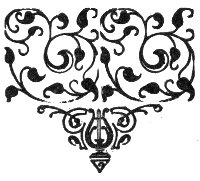
Transcriber's Notes
[HW:] contains handwritten errata notes, as listed above. Roman and
Arabic numeral inconsistencies were retained. Minor punctuation errors
and the following typos were corrected:
CONTENTS: Changed The 1853-55 Series from page 5 to 6.
Changed Addenda from page 105 to 104.
Page 3: Changed "humilation" to "humiliation".
(it is an humilation to American philatelists)
Page 3: Changed "unkown" to "unknown".
(timorous traveler to proceed into the unkown country)
Page 4: Deleted duplicate "the".
(spacings between the the letters)
Page 5: Changed "ascer" to "ascertained".
(easy manner, we have ascer [end of line] three important classes.)
Page 6: Changed "proceeed" to "proceed".
(and the manufacture will at once proceeed.)
Page 7: Changed "accordence" to "accordance".
(In accordence with the instructions of the United States Postal)
Page 7: Changed "pecular" to "peculiar".
(artists, had pecular ideas of the manly beauty)
Page 7: Deleted duplicate "the".
(expression runs the the gamut of meekness)
Page 8: Changed "aquaintance" to "acquaintance".
(Die 1 are concerned, a thorough knowledge of, or aquaintance)
Page 31: Deleted duplicate "the".
(Together with the the side-lock)
Page 40: Changed "realty" to "reality".
(new SIX and TEN CENTS. In realty the latter two appeared)
Page 44: Changed "broarder" to "broader".
(To give the philatelist a broarder hold on this issue)
Page 59: Changed "bu" to "but".
(the SIX CENTS is very similar to the last one, bu)
Page 64: Changed "uts" to "cuts".
(Class V.—Line falls outside of "W" and sometimes uts "O.")
Page 65: Changed "luckly" to "lucky".
(a rarity possessed only by a few luckly mortals.)
Page 68: Changed "contracter" to "contractor".
(the contracter for furnishing the Post Office Department)
Page 68: Changed "vareties" to "varieties".
(five letters which differ greatly in many vareties.)
Page 69: Changed "measurment(s)" to "measurement(s)".
(and the measurments are made as follows:)
(The student who employs these measurments)
(In case of doubt that single measurment is decisive.)
(the characteristic line measurment is mentioned)
Page 75: Deleted duplicate "of".
(top stroke of of "T" nearly touches "W.")
Page 77: Changed "manilla" to "manila".
(Buff Orange and Light Manilla.)
Page 78: Changed "deteoriation" to "deterioration".
(This is due to great deteoriation of the die.)
Page 82: Changed "beheind" to "behind".
(Bust point beheind "O.")
Page 82: Deleted duplicate "and".
("C" almost vertical and and close to point.)
Page 84: Under VAR. 13: Changed "041" to "401".
Page 103: Changed "discriptions" to "descriptions".
(replace the discriptions of these varieties)